Creating a New Project
The way in which Safran users create a new project will vary in a variety of ways depending on both project type and organizational maturity. In some cases, projects might be created totally from scratch, others may make use of existing libraries, while in larger organizations with a heritage of previous projects, rich libraries of project execution models or templates may exist that can be used as the basis for a new project.
Safran offers two basic methods of creating a new project either as a 'new' project and configure the different options and associated information, or by using an existing Template where a variety of characteristics and attributes are already set up.
Additionally, you can create a Project Group consisting of a number of existing projects. Safran Project's multi-project management functionality is described in detail in the chapter Multi Project Management.
Note: The "Project Group" feature is not relevant and therefore unavailable when using Safran Risk.
To set up a new project, click the 'New' icon on the File ribbon.
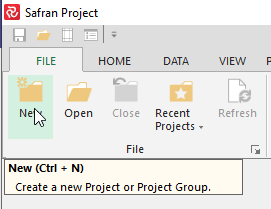
The New Project wizard will open with three options: Create a New Project, a New Project Group, or a New Project from a Template.
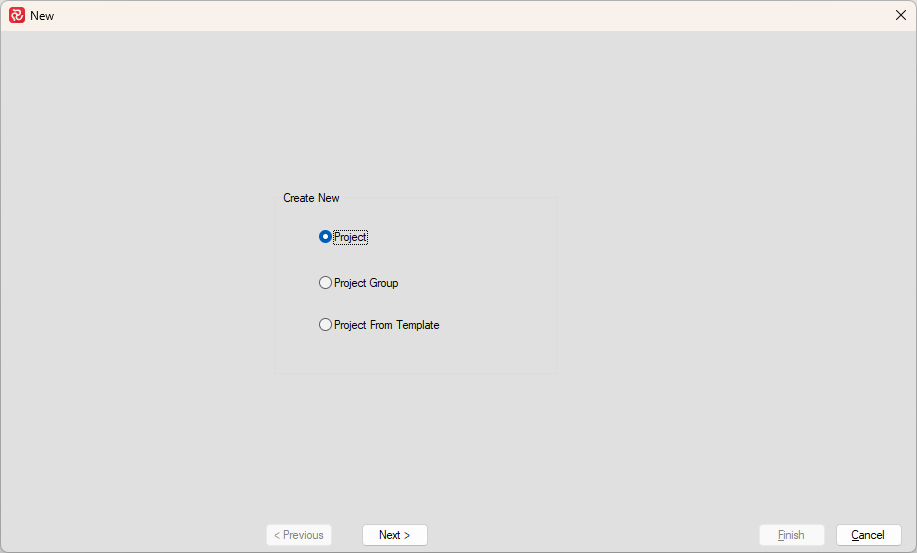
Creating a new project from scratch
If you are just starting to use Safran or working with a ‘stand-alone’ version and don’t have access to existing libraries or templates, the New Project wizard will guide you through the process of setting up your project. You’ll be prompted to create the minimum of library data and attributes required to get you started.
Keep in mind that you don’t have to configure/set up the complete environment upon initial setup. You will always be able to go back and add/modify information later using the ‘Project Properties’ facilities.
After selecting Create New Project, press ‘Next’ to start the New Project wizard.
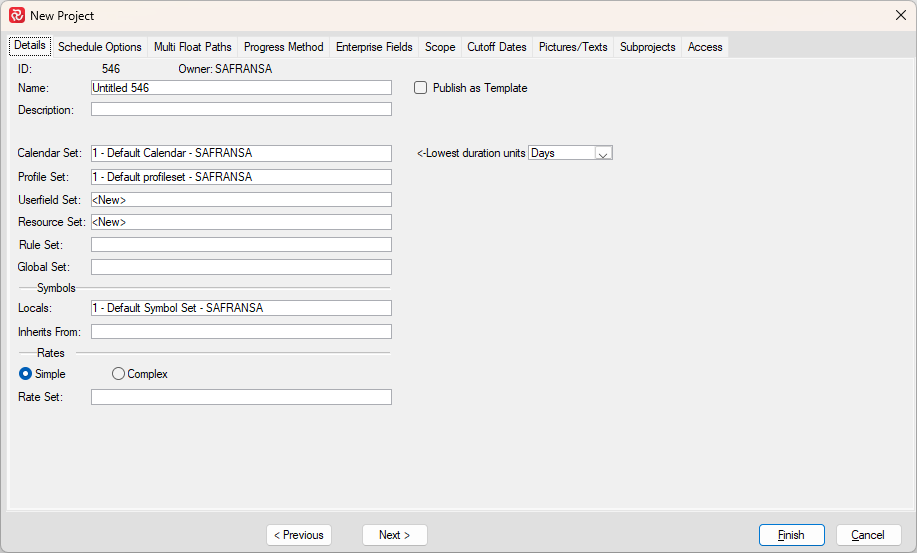
The initial page allows you to configure a wide range of attributes and options and may look slightly intimidating to begin with, however the minimum required libraries (Calendar, Userfield, Resource, Symbols) and majority of options are pre-set based on ‘sensible’ defaults.
As shown above there is both a default Calendar and Symbol set containing basic data. A ‘New’ Userfield Set, and Resource Set will be defined. Both the Userfield and Resource sets will be empty and will be given default names derived from the Name of your project. You will have the ability to add to these sets as part of the wizard.
There are however only a few things that you have to consider at this time.
Start by giving your project a Name and a Description. These two attributes will be readily available as header information for all layout and report configurations.
You'll also need to make the correct selection of the 'lowest duration units' before you proceed, as this will have consequences for your Calendar and cannot be changed after the project is created:

Next, select the Schedule Options tab.
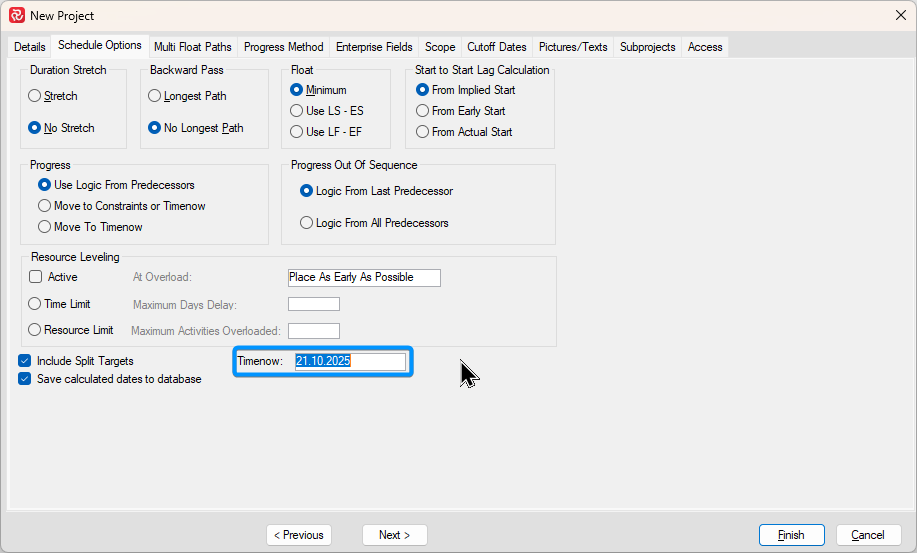
Notice the Timenow date and that it is by default set to today’s date. This will be the starting point of your schedule, and you will not be able to schedule activities before this date. You can modify this date to suit your needs.
In general, it’s always a good idea to set this date to the Monday in the week your project starts.
Next, select the CutOff Dates tab.
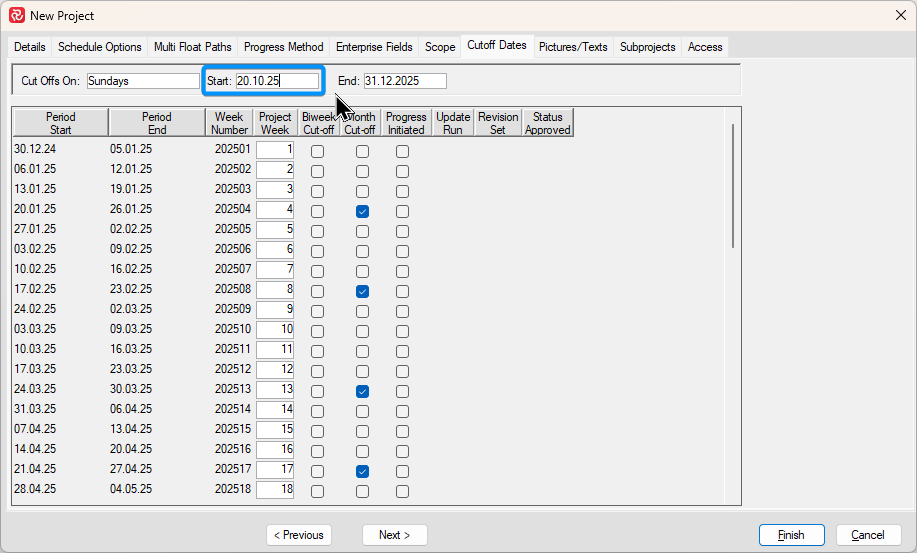
On this tab you should use the date you entered for Timenow above as the Cutoff Dates Start date and also enter an estimate for the Project End date. Again, it’s a good idea to select the last day of the month your project ends as the End date. The End date may be modified at any later time if the project duration increases.
By doing this you’ll see that Safran establishes and re-aligns the project periods.
The Cutoff day of the week is by default set to Sunday as this is the most common, however this may also be changed to another day of the week if needed.
If you now press the Next button, you will have the opportunity to configure User defined fields as shown below:
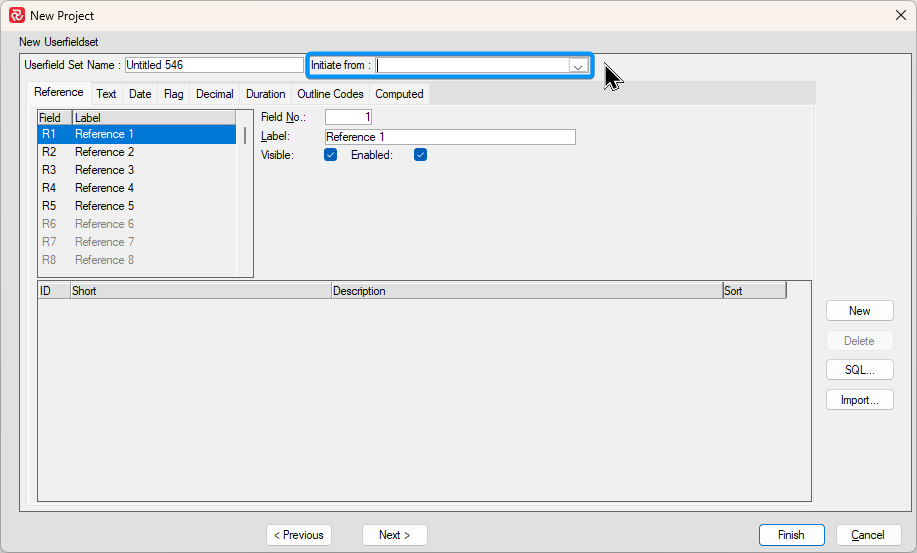
It's not necessary to define/configure userfields at this moment and is most likely more appropriate later when you have more information about your project.
Note that the 'Initiate from' dropdown allows you to select and make a copy of an existing userfield set and associate it with your project if such is available/relevant.
If you press the Next button again, you’ll be able to define Resources.
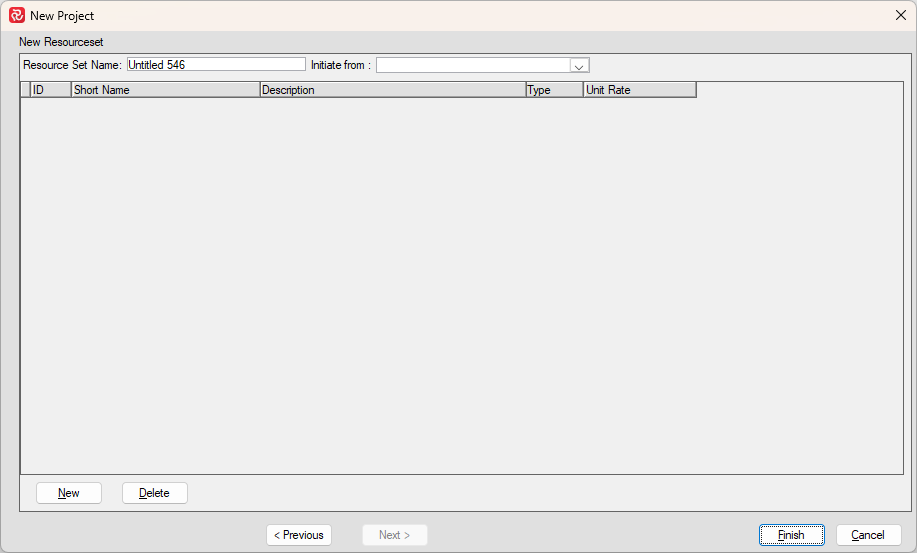
When you have been through the required Library sets, you’ll notice that the ‘Next’ button is now grey. You can then press the Finish button to complete the project setup after which Safran will open your project in the barchart editor.
It is not really necessary to configure these libraries at project creation as you can always access them anytime from the Data ribbon when working with your project shown below:

Similarly, the project configuration options Schedule Options, Cutoff Dates and so forth may be accessed from the Project-Properties ribbon.

Detailed information on how to both establish and modify the contents of library sets and other configuration options can be found in the chapters Project Properties in Detail and Working with Library Sets below.
Creating a new project making use of existing libraries
If you have access to existing Safran library data in your database, it’s often more efficient to set up your project by linking existing libraries to your project. The process is very similar to the ‘from scratch’ method, however you will not have to go through all the wizard steps. As mentioned above, you don’t have to do the complete configuration at this time as you can always add/modify information later using the Project Properties facilities.
After selecting Create New Project, press ‘Next’ to start the New Project wizard.
The initial page displayed below allows you to configure a wide range of attributes and options. The minimum required libraries when creating a new project are a Calendar, Userfield, Resource, and Symbol set.
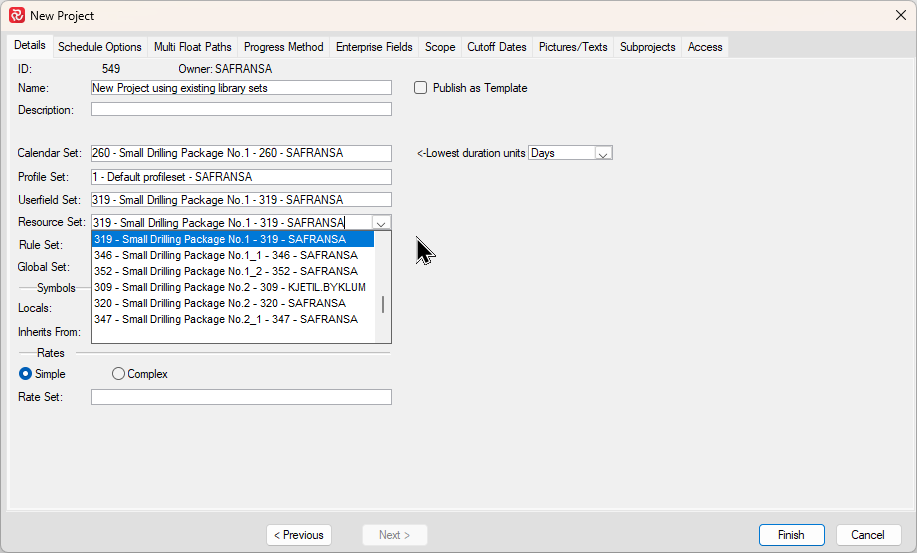
In larger organizations the Safran System Administrator has the ability to nominate default libraries when creating a new project so a number of libraries may already have been selected. Even if this is the case you will still be allowed to select another library from the dropdown list box if needed.
At the top of each dropdown list you’ll find a ‘New’ value. If you choose this value, Safran will create a new library set that will be empty and will be given a default name derived from the Name of your project.
You will also have the ability to add to these sets as part of the wizard.
There are only a few things that you have to consider initially.
Start by giving your project a Name and a Description for your project. These two attributes will be readily available as header information for all layout and report configurations.
You'll also need to make the correct selection of the 'lowest duration units' before you proceed, as this will have consequences for your Calendar and cannot be changed after the project is created:

Next, select the Schedule Options tab.

Notice the Timenow date and that it is by default set to today’s date. This will be the starting point of your schedule, and you will not be able to schedule activities before this date. You can however modify this date to suit your needs. In general, it’s always a good idea to set this date to the Monday in the week your project starts.
Next, select the Cutoff Dates tab.

On this tab you should use the date you entered for Timenow above as the Cutoff Dates Start date and also enter an estimate for the Project End date. Again, it’s a good idea to select the last day of the month your project ends as the End date. The End date may be modified at any later time if the project duration increases.
By doing this you’ll see that Safran establishes and re-aligns the project periods.
The Cutoff day of the week is by default set to Sunday as this is the most common, however this may also be changed to another day of the week if needed.
Now it's time to select/establish the four mandatory library sets:
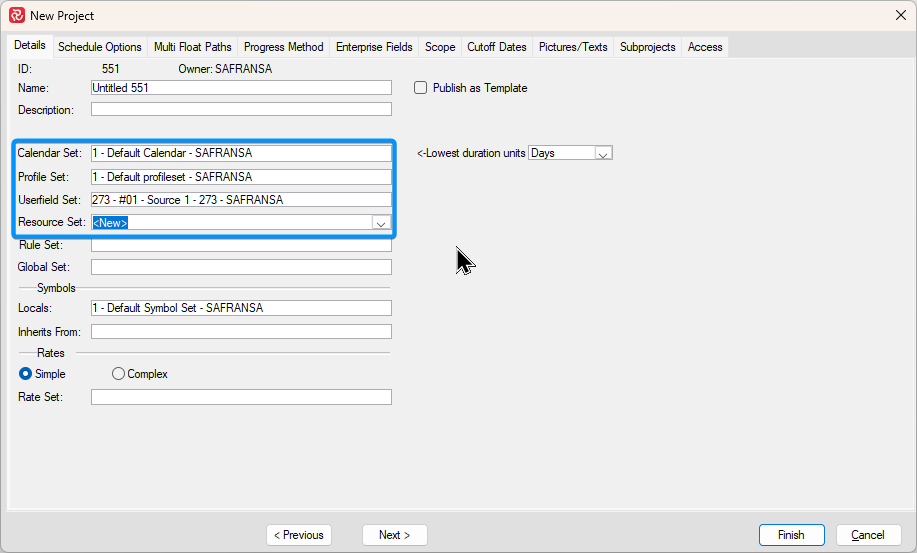
If you choose to establish one or more of the mandatory library sets yourself, either by initially leaving leaving a library set blank or selecting a New library, pressing the next button will guide you through any remaining missing library sets.
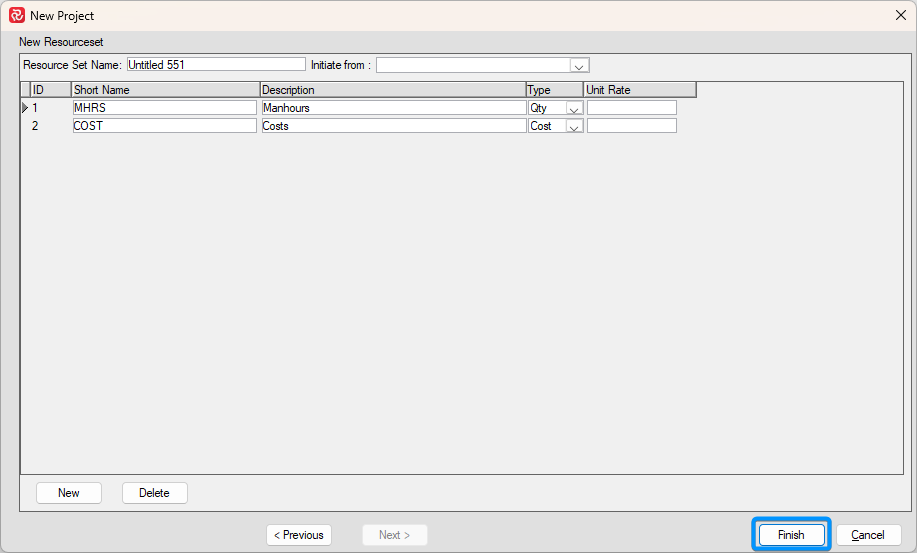
Once you have either selected or established all four mandatory library sets you'll notice that the 'Next' button is no longer active. In this case you can press the Finish button to complete the setup after which Safran will open your project in the barchart editor.
It is not totally necessary to configure these libraries at project creation as you can always access them anytime from the Data ribbon when working with your project. However, do note that Calendar in use, will be locked for editing after a baseline/status is urn.

Similarly the project configuration options Schedule Options, Cutoff Dates and so forth may be accessed from the Project-Properties ribbon.

Detailed information on how to both establish and modify the contents of library sets and other configuration options can be found in the chapters 'Project Properties in Detail' and 'Working with Library Sets' below.
Creating a Project Group
Creating a new project from a Template
If you or your organization have been using Safran for some time, you might have created one or more project templates that contain most/all of the libraries and attributes you need to setup a new project. A template may also contain activities, links and resources as a framework for a Project Execution Model.
To create a new Project using a template, select File/New/’Project from Template’ and press 'Next':
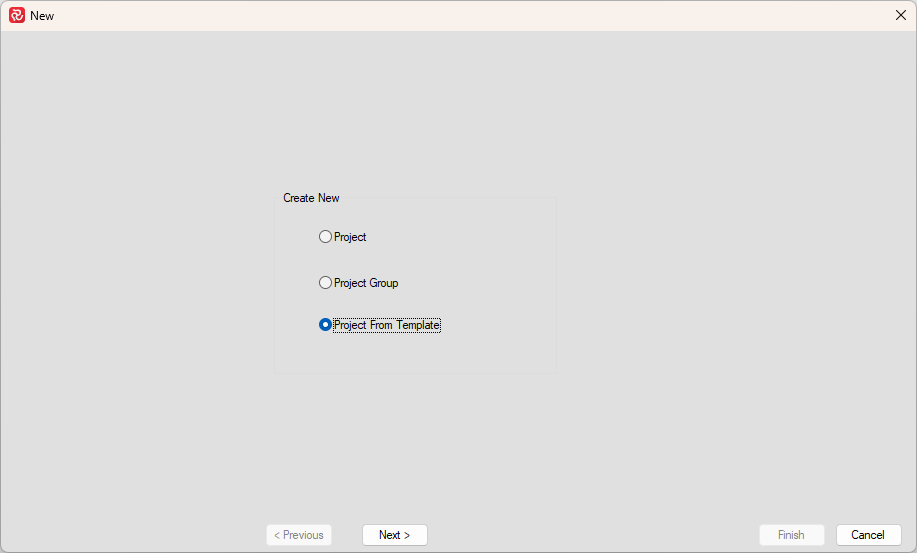
When the New Project From Template panel opens, a list of template projects within your database will appear. Set focus on the template project you want to use as the basis for your new project and click "Finish".
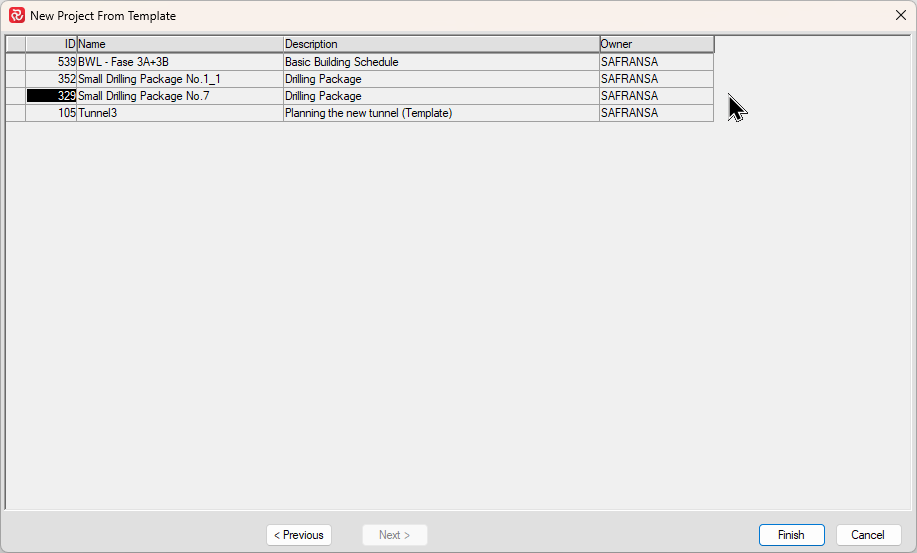
This will open up the template project in the barchart editor with "Test" access. This will allow you to see all of its properties and contents, but you will not be able to save any changes you make to the template. You may, however, save changes to a new project by selecting File/Save As.
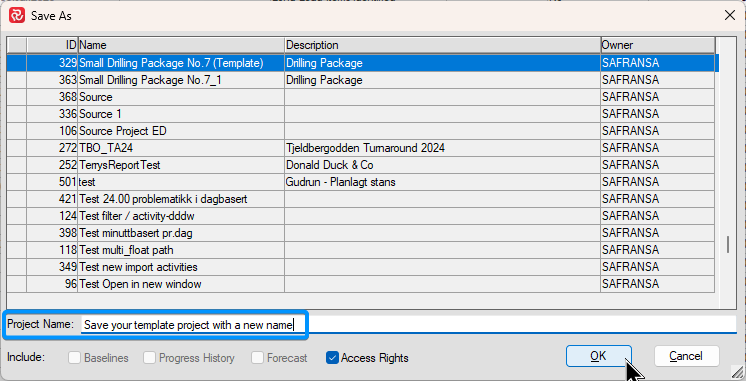
When the Save As panel appears, you’ll see a list of existing projects in the database. Enter a unique Project Name for your project and press ‘OK’. This will create a new Project ID with the chosen new name using the exact same library sets as the Template project:
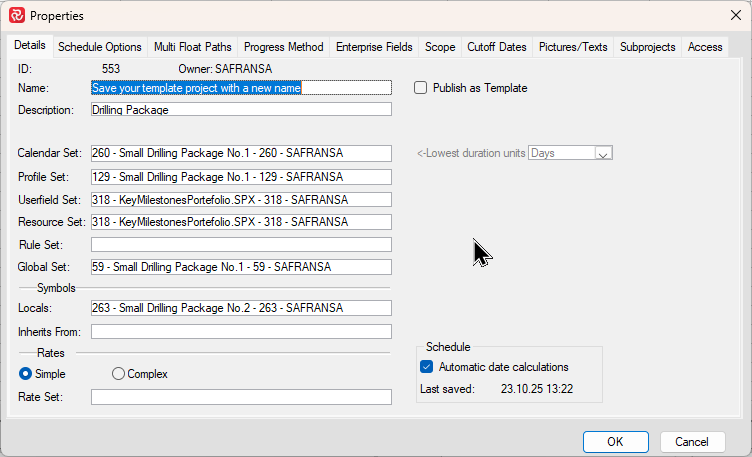
Project Properties in Detail
Details
| Field | Description |
|---|---|
| Name | Project name |
| Description | Project description |
| Calendar set | From the dropdown list, select the Calendar set that should be used for the project |
| Profile set | From the dropdown list, select the Profile set that should be used for the project |
| Userfield set | From the dropdown list, select the Userfield set that should be used for the project |
| Resource set | From the dropdown list, select the Resource set that should be used for the project for the project |
| Rule set | From the dropdown list, select the Rule set that should be used for the project |
| Global set | From the dropdown list, select the Global set that should be used for the project |
| Symbol set | From the dropdown list, select the Symbol set that should be used for the project |
| Publish as template | Select this project configuration to be saved as a template. |
| Locals | From the dropdown list, select the Symbol set that should be used for the project |
| Inherits from | Select the symbol set you want to inherit symbols from |
| Rates | Select the Simple or Complex rates/Rate set for your project |
Schedule Options
The Safran Project network analysis process/scheduler considers activity durations/constraints, activity relationships, and calendar information to calculate start/finish dates for each activity/resource and the project completion date. Safran Project calculates activity dates using the Critical Path Method (CPM).
Since project logic alone cannot always reflect all planning conditions, you may also want to consider the demand for resources and their availability when calculating the schedule. This process is called Resource Leveling. Resource Leveling is an automated process in Safran Project and delays the start of specific activities to when the resources are available while still meeting the plan’s logical constraints.
Your project schedule is dynamic: whenever you change activities or logic, Safran Project recalculates the schedule incorporating these changes.
Safran Project allows you to modify the default schedule options. In most cases, the default configuration should be sufficient. If this is not the case, it is easy to reconfigure the network analysis. You may modify the default options that the time analysis process uses. This may be done at any time before calculating the project schedule.
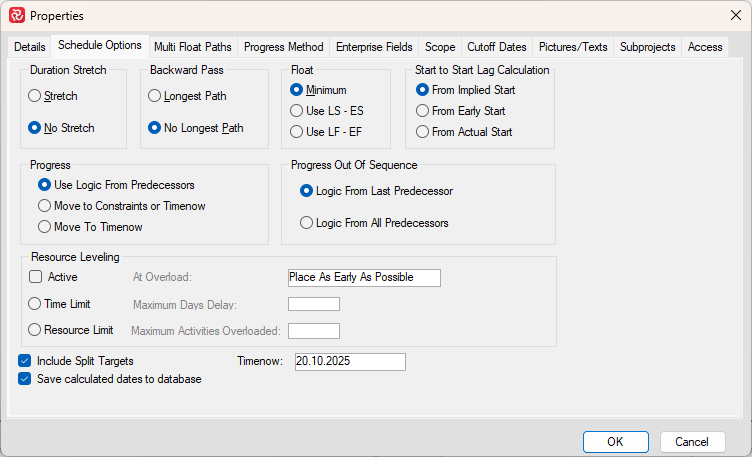
The various options and their effect on the network calculations are discussed in the table below:
| Field | Description |
|---|---|
| Duration Stretch* | Specify whether the analysis process may stretch an activity duration. The default is No Stretch. (See comment * below) |
| Backward Pass* | Influences the late dates of the project. The default is No Longest Path.(See comment * below) |
| Float* | Specify how to calculate the total float on activities. The default is Minimum. (See comment * below) |
| Start to Start Lag Calc | Specify the starting point/date for Start to Start Lag, either Implied Start, Early Start, or Actual Start. The default is Implied Start. |
| Progress | Specify whether the incomplete part of an activity may be split from the complete part. The default is Use Logic From Predecessors. |
| Progress out of sequence* | Specify whether the incomplete part of an activity can be completed after the last predecessor or after all predecessors.(See comment * below) |
| Resource Leveling | Select the type and value for optimizing available resources. |
| Timenow | Enter the Timenow date for the time analysis. Used for calculating the Live Plan (ES/EF, LS/LF). |
| Include Split Targets | This option allows you to run a CPM project time analysis using either the split target information or disregard the split target constraint. (See Appendix A - Constraints for details about Split target). |
| Save Calculated dates to database | Mark this check box to save calculated results to the database. The default is On. |
-
The standard time analysis calculation allows the duration of an activity to be stretched by the constraints leading to and from the activity. The stretch option will enable activities to be stretched on the forward pass by preceding SF or FF constraints and stretched on the backward pass by succeeding SF or SS constraints. If the option “No Stretch” is chosen, the start dates are placed as late as possible, compatible with project logic, on the forward pass, and their finish dates are set as early as possible on the backward pass.
-
The backward pass calculates the late start and late finish dates and the total float and free float for each activity and constraint. Calculations regarding hammocks and resources are also performed during the backward pass. By default, the time analysis process bases each activity's late dates on the early finish dates for each finished activity. You may use the “longest path” option to change the calculation. By doing this, all late dates are based on the last activity found at the end of the longest path through the project. If your project has multiple “finish” activities, the analysis, while the longest path is chosen, will use the latest Early Finish as a start for a backward pass for all finish activities. “No Longest Path” uses the individual finish activity’s early finish as a start for the backward pass.
-
Safran Project calculates Total Float based on the activity's start or finish dates or as the minimum of these two values, i.e., the most critical dates. By choosing “Start,” float is calculated as the difference between LS and ES of the activity. By selecting “Late,” the float is calculated as the difference between LF and EF of the activity.
-
Progress out of sequence refers to an activity that is in progress or has been completed earlier than one or more of its predecessors.
After setting up your new project, you can modify the Schedule Options by clicking Properties in the Project ribbon.
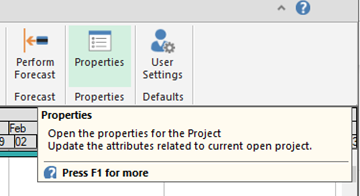
To consult your planning manager or system administrator if you would like to perform changes in Project Properties in an ongoing project.
Multiple Float Paths
Whereas the critical path in a project calculates one or more paths where activities have a Total Float of 0 or less (default) or are along the Longest Path, you’ll find that a project also has a number of sub-critical or ‘almost critical’ paths where a delay in an activity could potentially delay the project's end date.
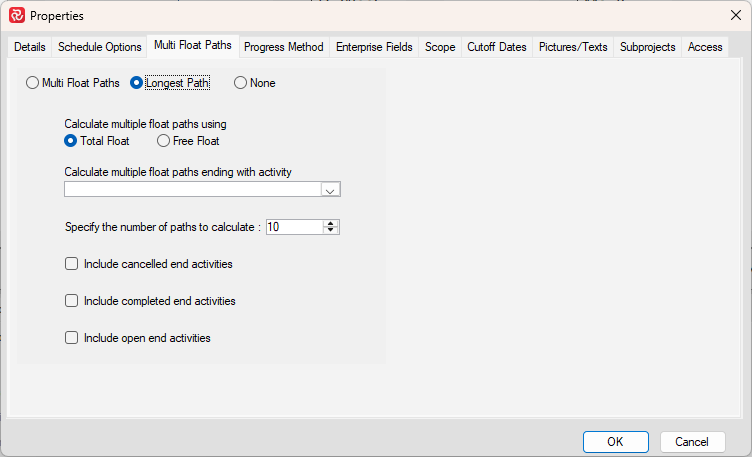
The default float calculation method when creating a new project is 'Longest Path' as shown above.
Safran can also calculate and highlight any practical number of float paths. Instead of focusing only on the paths with zero float, the multiple float path analysis identifies a series of paths with varying amounts of float. It allows you to see multiple paths in order of length or importance, grouped and ranked by their float value.
Additionally, while the critical path analysis focuses on the project as a whole, the multi path analysis allows you to select a specific activity (or milestone) and calculate the paths leading to this activity. This allows you to find both the longest path and sub-critical paths for any detailed part of your project such as a discipline, system, area and so forth.
Calculating multiple float paths has no effect on the general critical path as the results of the analysis are stored in separate fields.
The configuration panel for the multiple float path analysis is shown below:
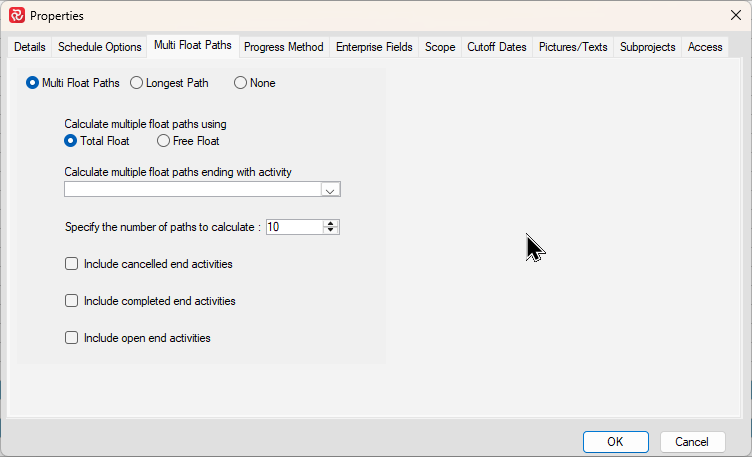
You can elect to calculate only the longest path, multiple float paths or turn the calculations off. If you choose to calculate multiple float paths, this will also calculate the longest path.
Calculations may be based on either Total float or Free float.
By default the complete project will be considered by the analysis, however if you nominate a specific activity/milestone from the 'Calculate multiple float paths ending with activity' dropdown, the analysis will only be carried out for that specific case.
Note: When using this facility it may be a good idea to define three userfields to store the results (Float Path, Float Path Number, Longest Path) of a specific MFP analysis if needed for later use, as a change of selected activity will erase the calculations for the activities in the previous selection. Additionally, turning off the calculations by selecting 'None' will erase all results.
You can specify the number of float paths to be calculated by choosing any number between 0-9999.
Keep in mind that analyzing a very large number of float paths might have a performance impact, especially for larger projects. If this should become an issue, you have the option to turn the float analysis off completely when not in use by choosing the 'None' option.
By default, cancelled, completed (%Complete PC=100) and open end activities are not considered, however these can be included by ticking the checkbox for the relevant activity type.
The picture below highlights the fields calculated during the analysis.
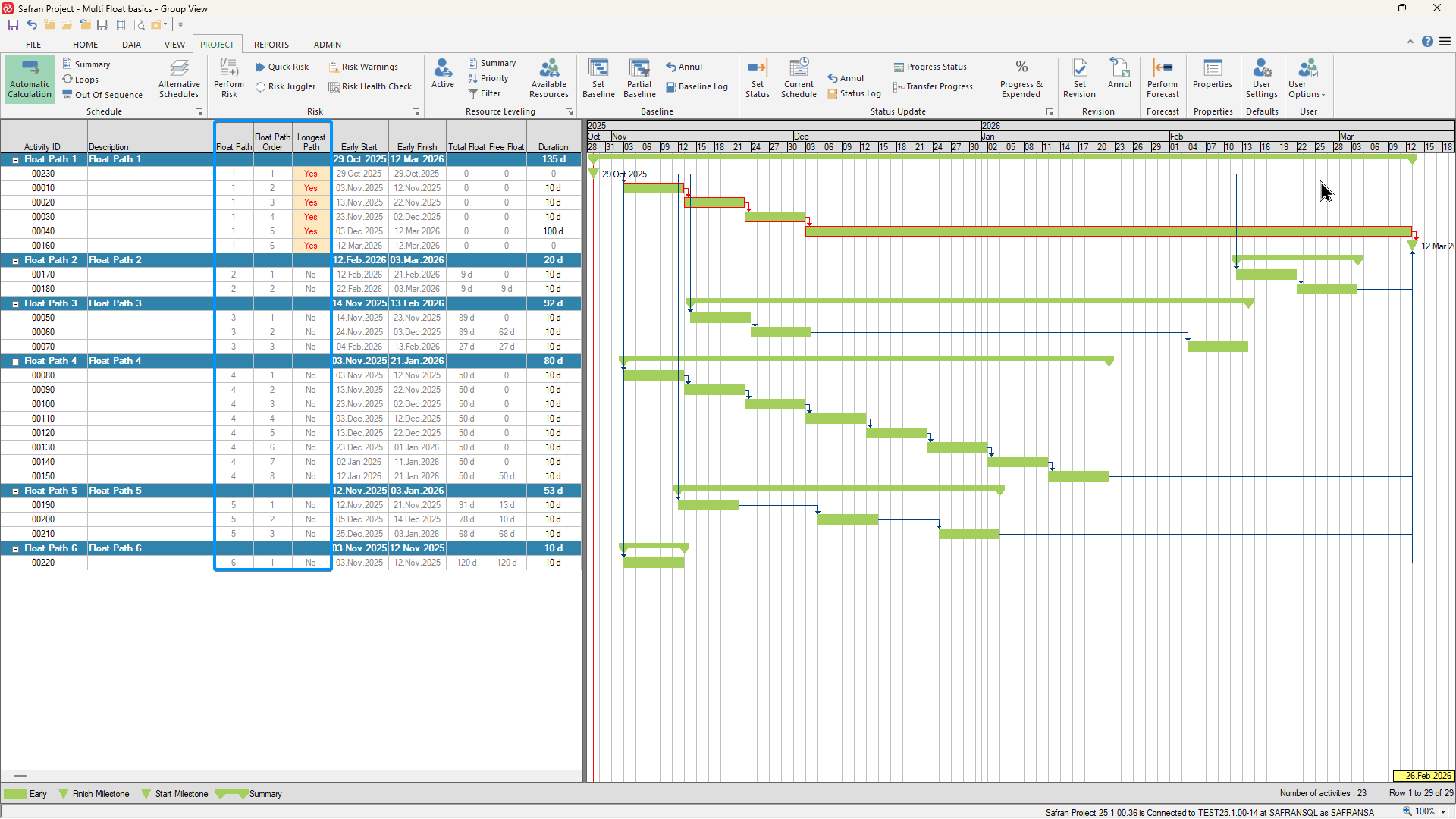
Activities in each float path are assigned/ranked a float path starting with the group with no float/longest path which are given the number 1. The group with the least amount of float (based on the final activity in the path) is given the number 2 and so forth.
A default layout named 'Multi Float Paths' is also provided so that you can easily access the calculated/related fields when you start working with multiple float paths. This layout may be modified to suit your own needs and stored as a new layout.
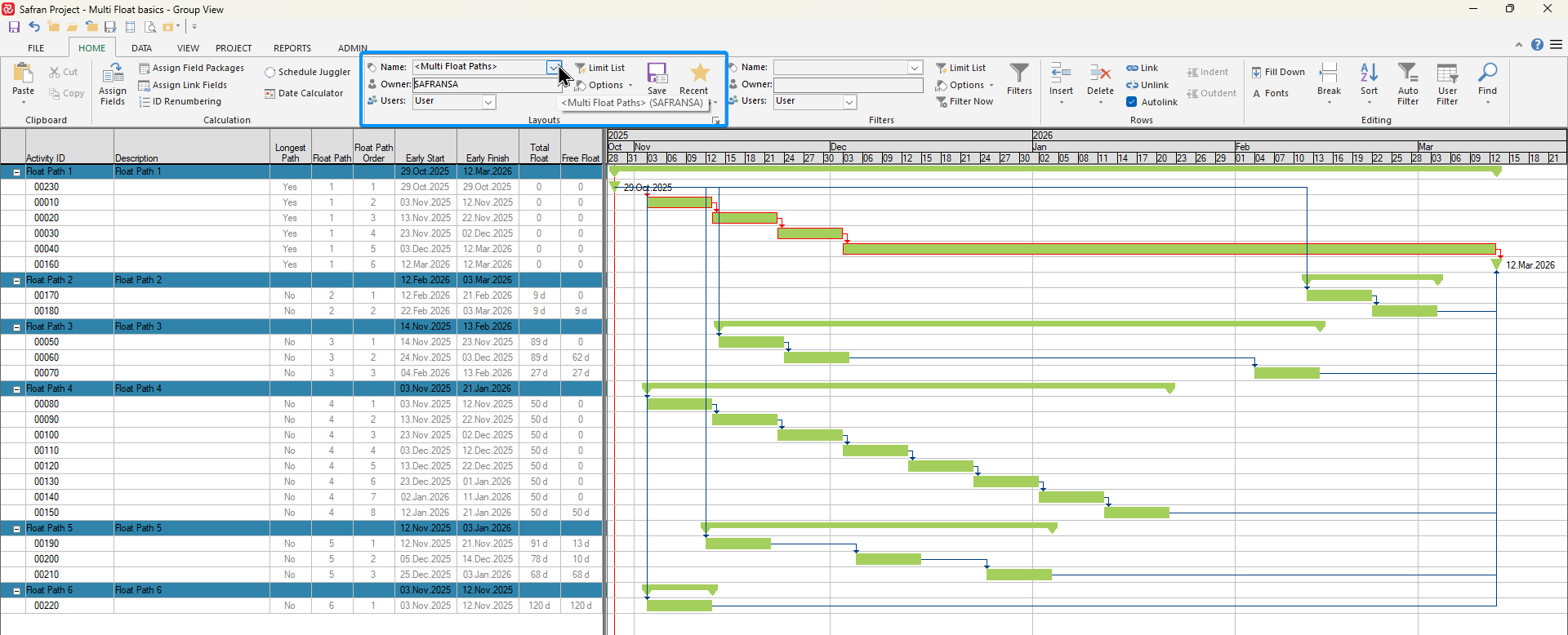
All three calculated fields are available as columns in the barchart and may also be used for filtering, sorting and grouping in order to assist you in making your analysis as legible/visible as possible.
When working with with your schedule in the barchart editor, you can access the configuration options from the Schedule Tab found on the Project ribbon shown below:
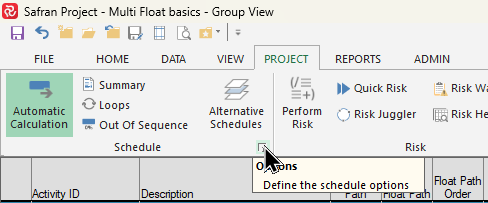
In this case, you can also choose to open the default 'Multi Float Path' layout by ticking the checkbox at the bottom of the panel as shown below:
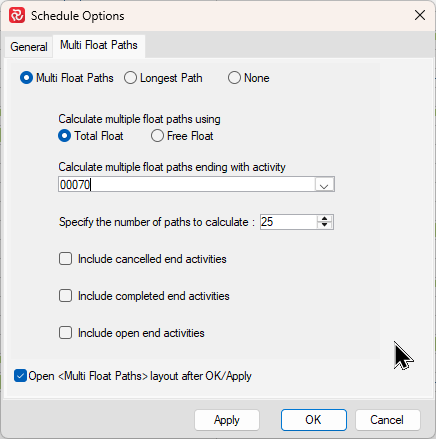
Progress Method
Safran Project allows you to select a default progress method supporting three differing work practices. This may have already been selected as a default for all projects within your organization. You should, therefore, consult with your planning manager or system administrator before making any changes.
Timenow is the starting point for activities without preceding links or date constraints. Timenow should be set to the starting day/hour of the project. For projects with weekly cutoffs, we recommend you set Timenow to the Monday for the first week of your project.
The Timenow date may be changed manually at any time, however in its simplest and most common use, it is only required to be changed at each Baseline Revision to re-schedule remaining durations and work.
Alternatively, the Timenow date may be updated/synchronized automatically at pre-determined intervals with status information from a cut-off.
The three available Progress methods are discussed below.
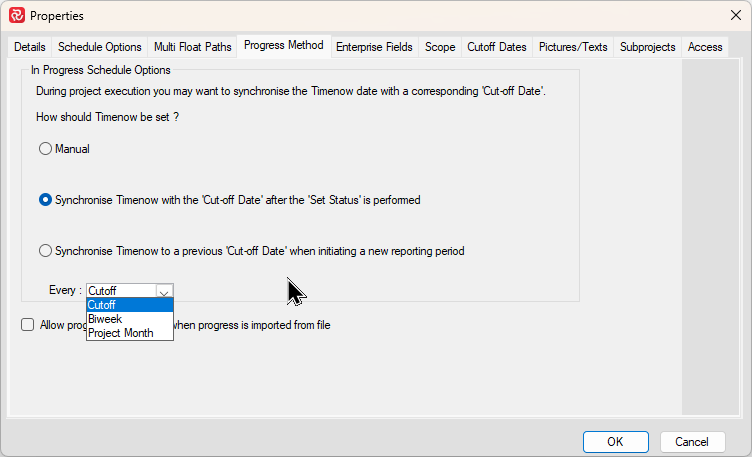
- The Manual option is the system default. The Timenow date remains unchanged until the user chooses to change the date.
When you change the the Timenow date you are given options as to how to treat any existing Live Plan status values in the Actual Start/Finish, Percent Complete and Remaining Duration fields.
If the date you choose does not coincide with a Cut-off date, you may choose between either keeping or clearing any existing values.
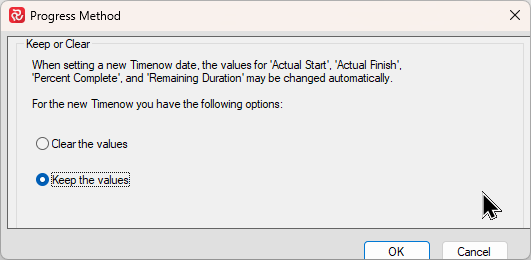
If the date you choose coincides with a Cut-off date with status information (ie. your chosen Timenow date is the day after a Cut-off date with status information), you will be given additional options.
You can then choose to update with the status values (Actual %, Current Actual Start/Finish, Current Remaining duration) from the cut-off date. This will synchronize the Live Plan with that Current Plan.
Additionally if the date you choose coincides with a Baseline you can have the status values updated from the Baseline cut-off.

The picture below shows a project with progress information at the 30.11.25 Cut-off prior to moving Timenow to 1.12.25.

After moving the Timenow to the day after the cut-off and choosing to Update with progress values, note that the Live and Current plans are now equal/synchronized.

The two Synchronize options update Timenow and Live Plan status information from a cut-off in connection with your Status update process. This will in turn synchronize the Live plan with the Current plan at that time to show remaining work. The difference between the two options has to do with exactly when the update takes place as described below:
- The Synchronize Timenow with the Cutoff date after the 'Set status' is performed option does the update as the final part of a status update.
The two pictures below showing two consecutive cut-offs with this option chosen.


This option may be useful for users who are used to working with remaining work and not familiar with Safran's Current schedule (Current Early Start/Finish) and/or need to modify the remaining schedule as to reflect 'reality'. This option ensures that the Live schedule (Early Start/Finish) reflects the Current schedule after a status update and until a new status update is executed.
- The Synchronize Timenow to a previous 'Cut-off Date when initializing a new reporting period option does the update when a new reporting period is initialized.
This happens each time you select Progress & Expended and elect to initiate a new cut-off. This option ensures that the Live schedule in effect reflects the previous period's Current schedule after running a Status update.
This may be useful to highlight/compare progress development and variation in finish dates in consecutive cut-offs.
The snapshot sequence below illustrates the steps and helps to understand the concept.

The progress for the first project week has been entered and the status update has been executed. The three barchart symbols, Current/Baseline/Early(live) show that the activity is on schedule.

In the picture above, a new cut-off is initiated.
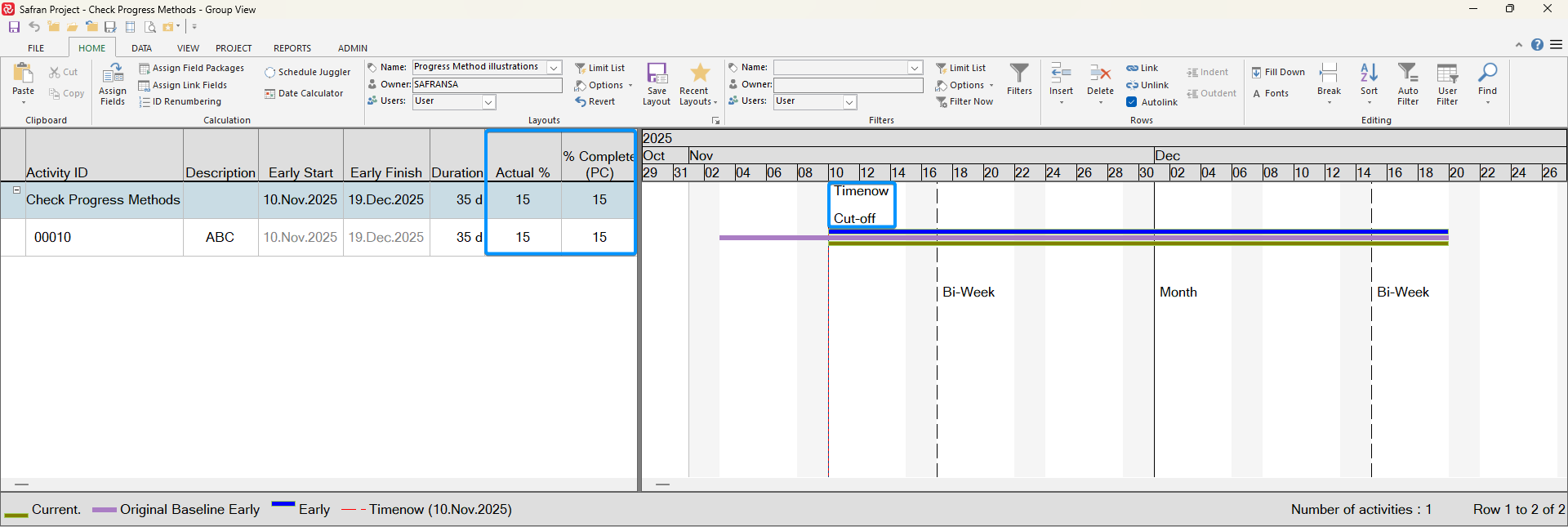
After pressing OK, Timenow will be moved forward to the day after the new Cut-off and the live plan will be synchronized with the ‘now’ previous Current plan.

After progress has been entered and the status update executed, the live plan is effectively a copy of the previous Current plan. It’s now easy to see that the activity has not had the desired progress and has slipped.

The process is repeated the next week as a new period is initiated.

After progress has been entered for the cut-off and status update executed, barchart now shows that the activity is once again on schedule as the Current bar now has the same end date as the Baseline bar.
- Whereas the Synchronize Timenow options govern when the synchronization takes place in your progress updating process, the Every dropdown governs how often/at which intervals it takes place.
You can choose between Weekly, Bi-weekly, And Project Month. The two latter intervals/dates may be configured in the Cutoff Dates tab of the Properties window.

The default option is Weekly and results in a dynamic view of remaining work at all times since its updated so frequently.
Choosing either Bi-weekly or Project Month will have the effect of making the Live plan more rigid since it's synchronized on a less regular basis therefore presenting a 'snapshot' of remaining work/status as it was some weeks or a month ago.
After the initial project set up is complete, the options selected can be viewed/modified at any time using the Project properties option from the Project tab. Choose the Progress method tab of the Properties window.
Allow Progress to decrease during Progress import
In addition to manually entering progress and expended information, Safran Project also supports file import of such information. During the import process, Safran carries out a number of validations, including a check if imported progress figures are lower than reported in the previous period. This is an error by default; however, if required, a progress decrease can be accepted by checking the final option in the Progress Method panel below.

To provide a better understanding of how the progress method should be set, it may be helpful to clarify the relationships between plan sets, Timenow, and cut-off dates:
Live vs. Current plan sets
Although Safran has several plan sets or dates to control and visualize project performance, it is all based on one single activity network construction with activities, links, and resource requirements. The various plan sets are analyses with different starting points and may have different statuses or progress for the schedule analysis. This allows planners and project control team members to view, compare, and evaluate the project's progress, performance, and development.
Two similar (but different) user inputs control the starting point for the CPM (Critical Path Method) for the Live and Current Analysis.
- Timenow: The Timenow date is the starting point for all remaining work used for the Live analysis. If no progress has been reported, the Timenow date is the starting point for your project schedule. If the project is progressed, the live analysis uses the progress from the four fields: Actual Start, Actual Finish, % Complete (PC), and Remaining Duration.
- Cut-Off date: The cut-off date represents your project's reporting or status by time or date. You can have cut-off dates weekly, daily, or even multiple times per day. The latter is beneficial for running short-term projects such as campaigns or shutdown, Turnaround, and Outage projects (STO), where progress is reported and updated frequently.
When you define your project and reporting frequency, Safran Project generates a table of valid cut-off dates. The reporting period frequency also depends on your project's selected calendar unit. If your calendar has a minimum duration of days, you cannot choose a reporting frequency more often than once daily. If the calendar unit is hours, you can specify a maximum of 6 reporting periods per day. As the cut-off date represents the status by date, it also represents the starting point for the remaining work.
The progress input fields for the Current analysis are Actual %, Current Actual Start, and Current Actual Finish.
The cutoff date will not be set until you run your first status update. Timenow is set initially set when creating a project. The cutoff date is advanced step by step according to your selected reporting frequency.
During project execution, the Timenow date and Cut-off dates may differ, thus giving you two views of your schedule. However, Safran lets you align Timenow and Cutoff and update the Live progress field with the corresponding values from your project status update. When running a new baseline, this is part of preparing the new baseline.
Different Work Practices
Over the years, we have observed various work practices on how and when the Timenow date is synchronized with the cutoff date.
- Only when preparing for and running a new baseline
- After every status update (timenow=cutoff date (+1))
- Timenow is set to a previous Cutoff date from the weekly, bi-weekly, or monthly status updates before running a status update.
All three methods are discussed below. Safran Project also supports a setup that automates synchronizing the dates. The automation of this process can also be set as a default for all projects, using the project defaults option of the Sys Adm. application.
Before setting or changing these options, we recommend you consult your planning manager or system administrator.
Moving Timenow only when a new baseline is set
In effect, this method keeps the Timenow date at the point in time when the latest baseline was set. Immediately after setting a baseline, either initial or subsequent, the Baseline plan and the Live plan will be identical. Baseline dates are always a snapshot of Live dates as they were when running the Baseline process.
In many projects, the baseline is only updated or amended at pre-defined contractual periods (for instance, every six months). During this period, the approved baseline is 'frozen' and kept as a reference against which to measure progress.
During Project execution, it is likely that you will experience changes to the scope of work and your estimates. These changes should be added without you having to change your approved baseline. Safran lets you do exactly that.
The Current plan (Current Early Start/Finish) is advanced and analyzed during each Status update, considering the cutoff date and the progress (Actual %) for the activities and resources.
The Live plan (Early Start/Finish), using the same base date as the baseline, the Timenow Date, includes all new work added after the baseline was set in addition to the original work.
The Baseline plan (Baseline Early Start/Finish) consists of all known and planned work when setting the Baseline.
As the project progresses, progress information is entered, and a status update is carried out at predefined intervals. The Current plan represents all known remaining work starting from the latest cutoff. The period between the Timenow and Cut-Off dates will increase after each new status update.

In this figure, a small project has been established with a baseline (blue bars), and the Live plan is shown in gray. After the baseline was set, some changes were made, i.e., new activities, Design platform extensions, Fabrication platform extensions, Transport extensions, and Installation of platform extensions have been added to the project plan. These activities were not part of our baseline and had no baseline reference. Keeping the Timenow at the baseline base date allows you to use the Live plan as the reference for work included and added after the baseline was approved. The red line shows the Timenow and the dark vertical line shows the current Cutoff date. A progress update has been run. The project's status is displayed with the yellow bars representing the Current plan as analyzed using the progress entered and the cut-off date as a starting point for the current analysis.
Moving the Timenow date after each status update
If you synchronize Timenow with your Cut-off date after each status update, Safran updates the Live plan with matching progress from the status update. The result is that the Current and Live dates are equal.
Some users claim that one loses one set of schedule and progress information. Others argue that by doing so, you simplify the schedule control in Safran.
The baseline is still unchanged and represents the progress and performance benchmark.

In this example, the Timenow date is synchronized with the latest cutoff date, and the live plan = current plan. This can be observed from the bars where the grey bar (Live Plan) and the yellow bar (Current Plan) are identical. The dark vertical line represents the cut-off date. A blue vertical shows the base date for the baseline plan. The baseline plan is kept unchanged.
Synchronizing the Timenow date with a previous Cutoff date
Sometimes, comparing your current progress with the status reported in an earlier reporting period is beneficial. You can do this by synchronizing Timenow and progress with a previous Cutoff date before entering the progress for this period.
Your live plan will now a) start at a previous Cut-off date and b) represent the status reported by that reporting period. You can now compare the latest progress reported with the previous status to see where there are slippages or gains between the two periods. This synchronization can be done weekly, bi-weekly, or monthly, supporting different needs.

In this figure, the live plan is synchronized with the status update (the Current Plan) at the end of February. The project is advanced to the end of March, and the status update is completed. You can now compare your updated project schedule with the update from last month's reporting. The vertical lines represent blue = baseline start, Red: Timenow for the Live plan, and Dark- The latest status date and the Cutoff date for the current plan.
The progress method supports the three work practices.
- The manual option is the system default. The Timenow date is unchanged until the user chooses to change the date himself.
- Synchronize Timenow with the Cutoff date when 'Set status' is performed. This option updates and synchronizes the Timenow with the latest cut-off date every time a status update is performed.
- The third option allows you to synchronize the Timenow date with the last cutoff date, the last bi-weekly reporting date, and the last monthly cutoff date when a new reporting period is initialized.
Sub Projects
Safran Project allows you to divide your project into any number of subprojects. You can also specify which users can access the subproject and at what access level. When opening the project, users will be presented with the subprojects to which they have access and will only see the activities for those subprojects. Additionally, if an activity were linked to/from an activity from another subproject, the user would be able to see the activity but not modify it.
One typical use for this functionality would be if your project consisted of multiple buildings/contractors and you wanted all to develop a single coherent schedule in Safran. Each contractor has its own discrete activities while the project owner needs to access the total schedule.
Another widespread use of subprojects is in MOM environments (Modification & Maintenance) when working with Contract Items.
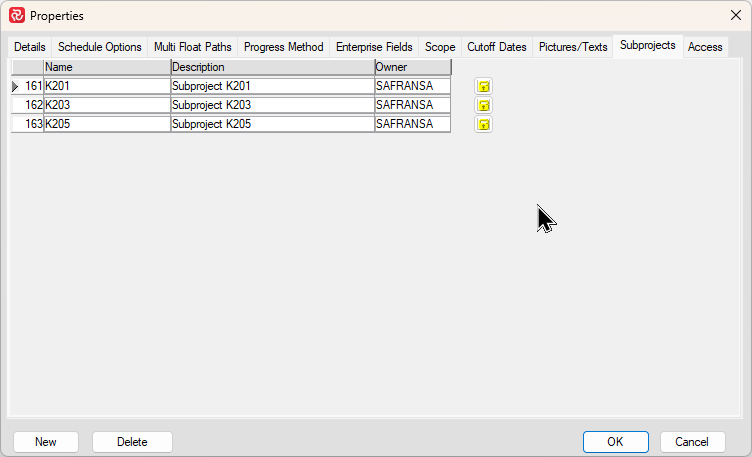
| Field | Description |
|---|---|
| Name | Enter the contract item name. This name will be displayed in the screen title bar and as a reference to the project throughout the application. |
| Description | Contract item description. |
| Owner | Sub Project owner. Output field showing user name. |
Adding Subprojects
Press the New button to add a subproject in the Properties/Subproject tab. You may add a new subproject even when the project is open.
Removing (or transferring) Subprojects
To remove a subproject, go to File/Open and right-click on your project. Choose Project Properties.
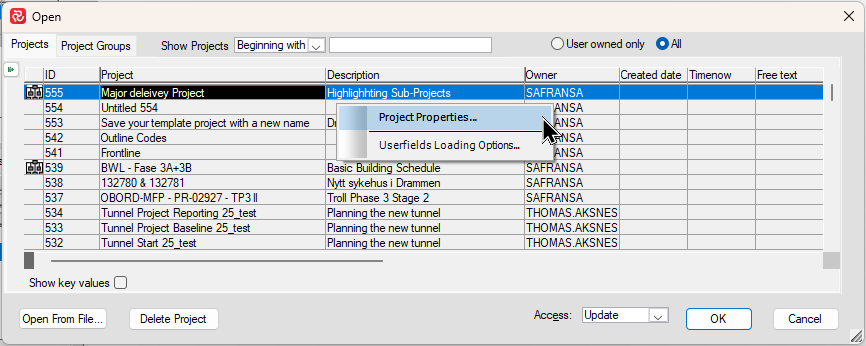
Go to the Subprojects tab.
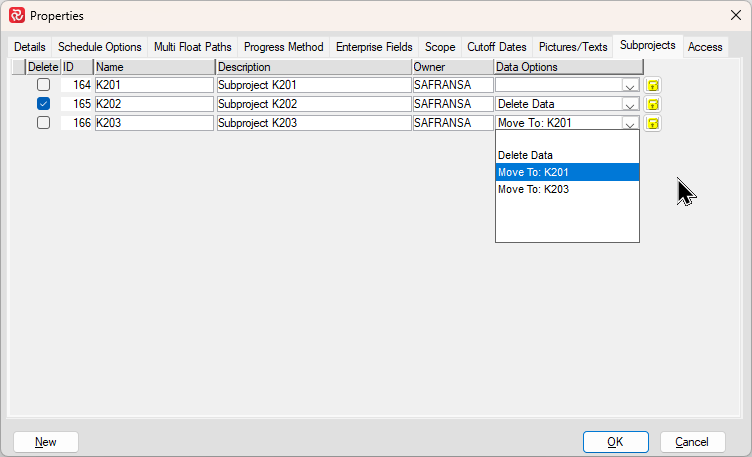
In the left column, tick 'Delete'; in the right column, choose what you would like to happen to the existing activities belonging to that subproject either deleting or moving to another subproject.
You can delete one or more subprojects or transfer all their activities to another from the Subproject panel.
Transferring Subprojects
When establishing one or more newSubprojects for a project with already existing activities not belonging to a specific subproject, Safran allows you to select which Subproject the activities should be transferred to. Alternatively, you would be able to delete all activities if required.
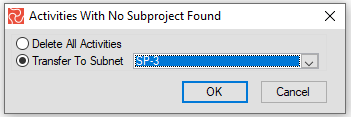
Moving activities from one subproject to another
Suppose you need to move activities from one subproject to another. In that case, this can be done by choosing Subproject as a field in the Barchart Editor and modifying the value for the activity or activities in question. A more effective way of doing this for large groups of activities would be to use the 'Fill down' capability shown below:
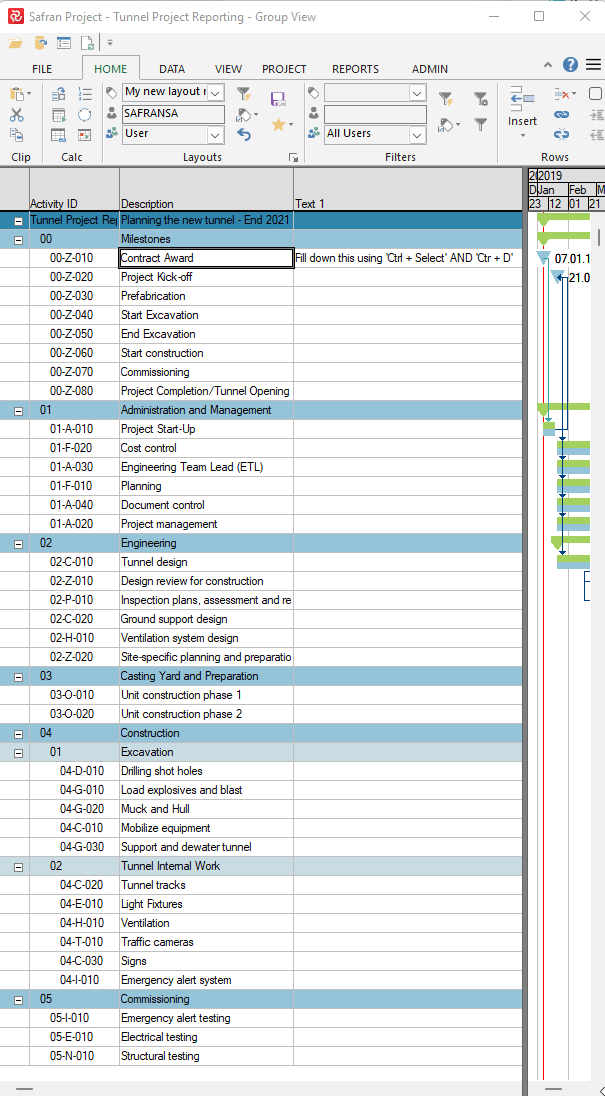
Although the example shows changes made to a text type field, the same approach could be used to modify the 'Sub Project' field which governs which Sub Project an activity belongs to.
Alternatively you could also use the Assign Fields tool shown below:
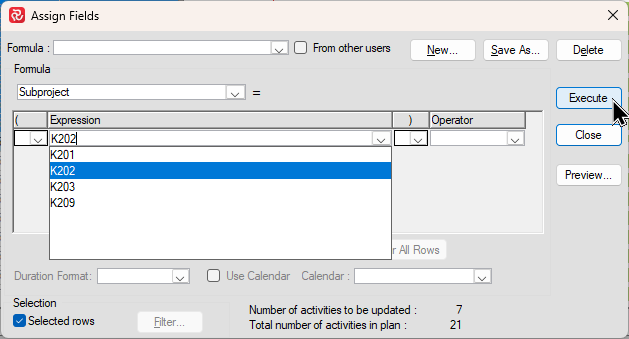
Adding Access to Subprojects
To add or modify access to your subprojects, go to the Project Properties>Subprojects panel.
To the right of each subproject you'll notice a yellow 'padlock' icon. Click on the yellow icon next to the subproject to open the Access To window. You can use use the 'Drag n drop' technique or the Add/Remove button to grant access and the dropdown to select the relevant level.
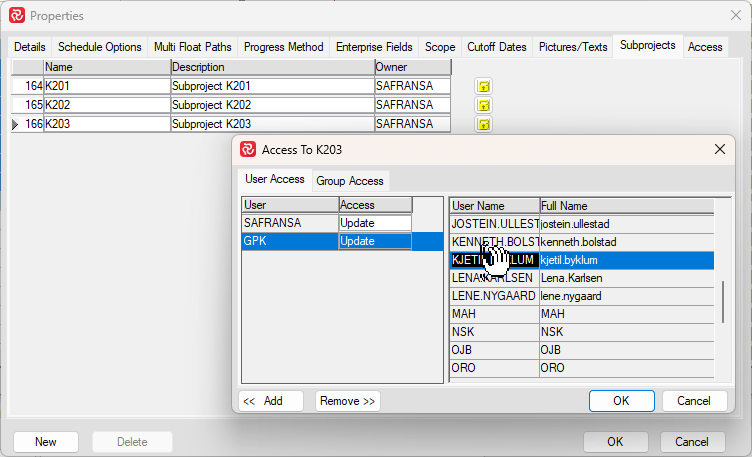
Keep in mind that it's only the 'Owner' of a project who is allowed to grant access to a subproject.
Open one or multiple subprojects.
When you open a project containing Subprojects, you have the option to open one or more, or all subprojects you have access to and also choose your access level:
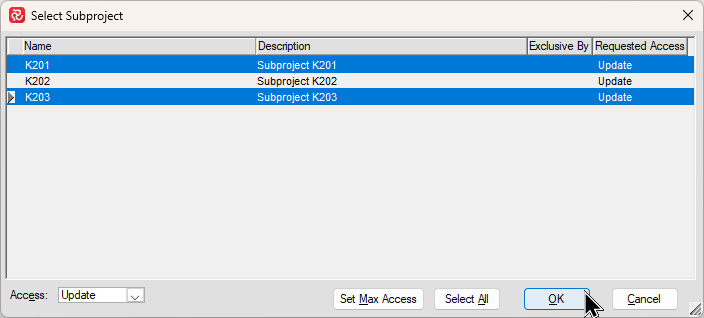
If you select 'Set Max Access' your maximum access level for each individual subproject will be applied when opening the project.
Enterprise Fields
Enterprise fields are often used to categorize/filter/sort projects while working with Safran Project. Unlike Userfields, which are assigned at the activity level, an Enterprise field is set at the Project level.
Project Type, Project State, Contract No., Project Owner, or Region are typical examples of Enterprise fields.

In ADMIN/Enterprise fields, you can to define up to:
-
100 Text fields
-
100 Reference fields
-
100 Flag fields
-
100 DateTime fields
Defining Enterprise Fields
Enterprise fields are defined 'globally' for the entire Safran Project database. To define Enterprise Fields and Codes, look for the Enterprise Fields option under the Admin tab shown below:
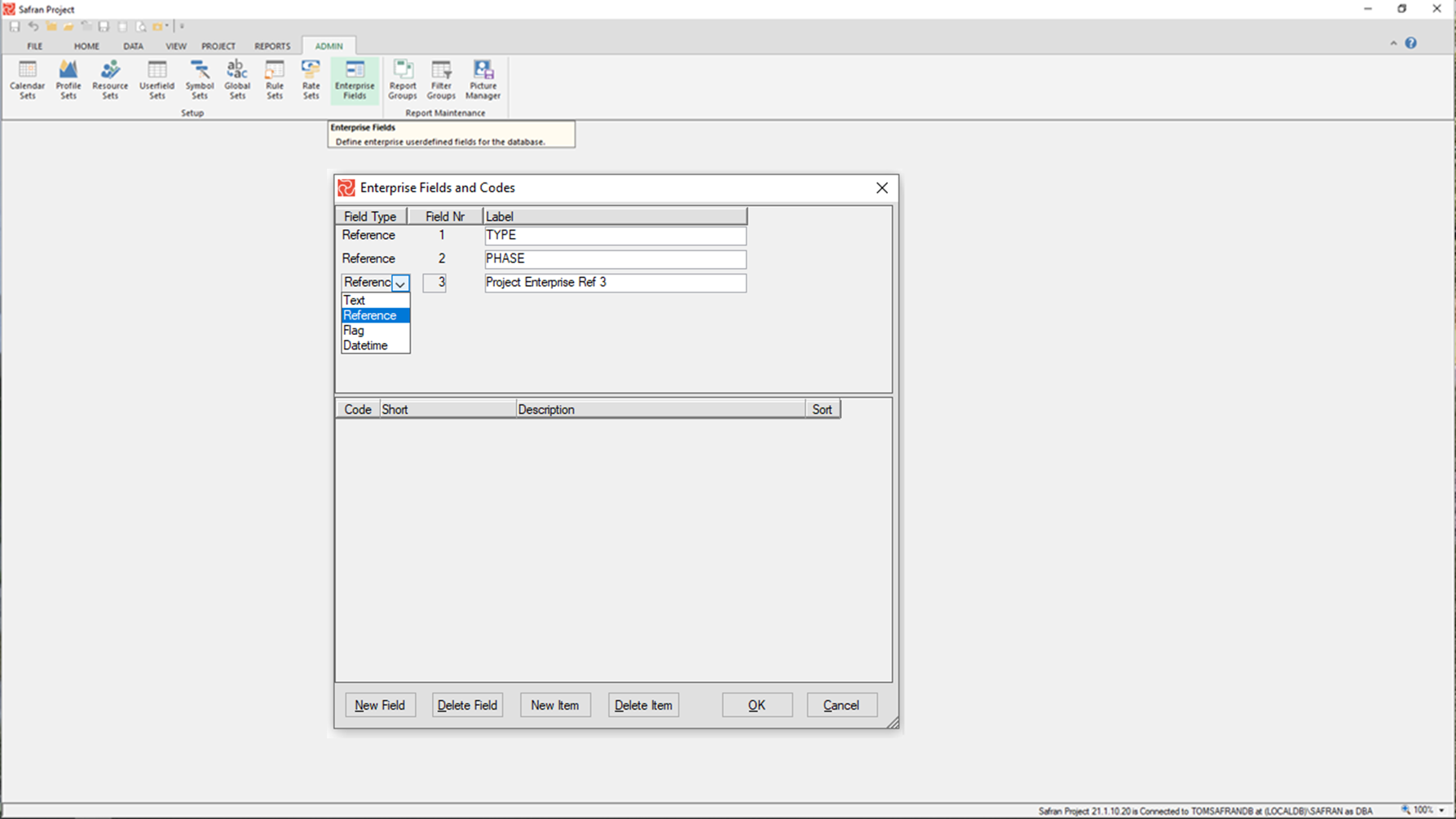
To define a new Enterprise Field, press the 'New Field' button and select the relevant field type. Enter a 'Field No' unique for the field type chosen and a label in the 'Label' column.
If you choose to define a Reference field, you will also have the opportunity to define valid codes/descriptions/sort for the field in the lower panel of the window by pressing 'New Item.'
When using a Reference field to group or sort on, Safran will, by default, sort by the 'Short' value. If the 'Short' values don't give the sort order you require, you can enter a 'Sort' value and specify to use the 'Sort' field in your layout or report.
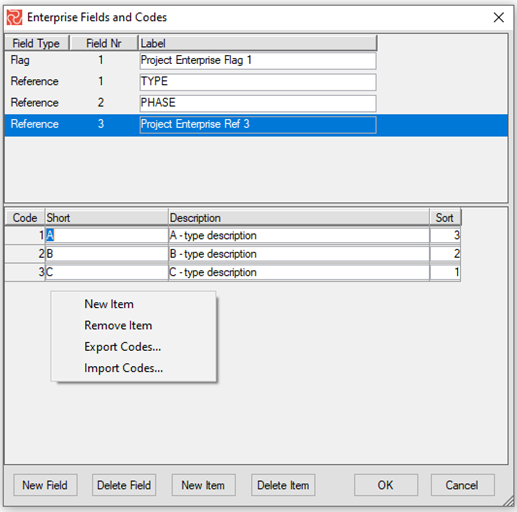
When you are finished entering/updating your Enterprise Field information, press the 'OK' button to save it and close the window.
If you 'right click' in the upper panel, you'll see a context-sensitive short-cut menu that, in addition to the 'New/Delete' field/item options, also allows you to export/import all or a single selected field definition and codes.
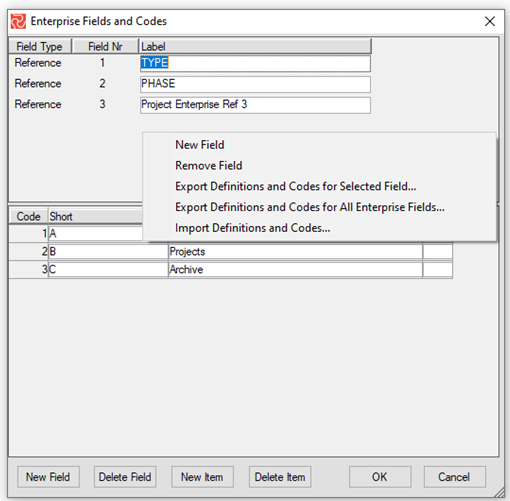
If you 'right-click' the lower panel, you can export/import codes for the Reference field in focus.

In both cases, the information is saved to/retrieved from a tab-separated text-type file via a standard Windows file save/open window.
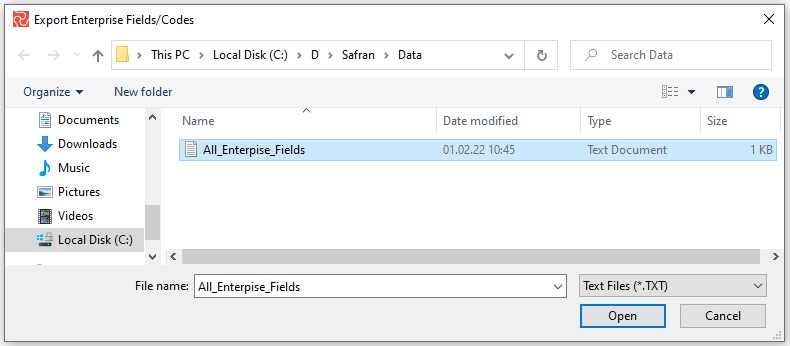
Assigning Enterprise Values
A projects Enterprise fields may be set from the Project Properties/Enterprise Fields tab as shown below:
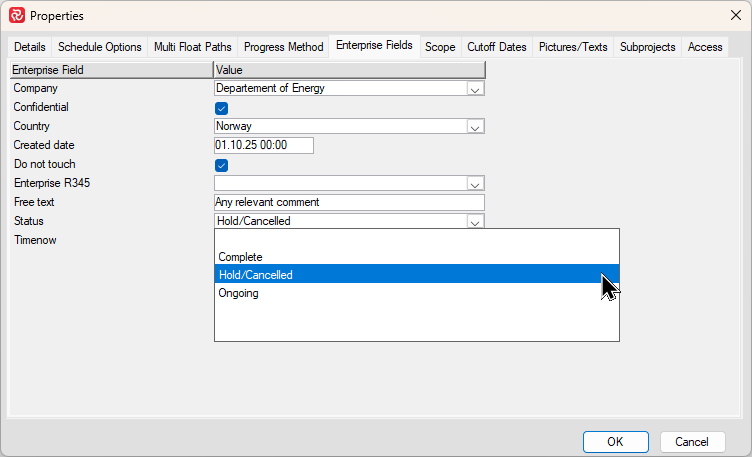
A list of defined Enterprise Codes for the database is presented allowing you to choose the value for each code from a dropdown list.
Using Enterprise Fields
When working in an environment with large numbers of projects in your database, using several enterprise fields to organize projects in the File Open panel is a convenient way of selecting the projects you would like to work with.
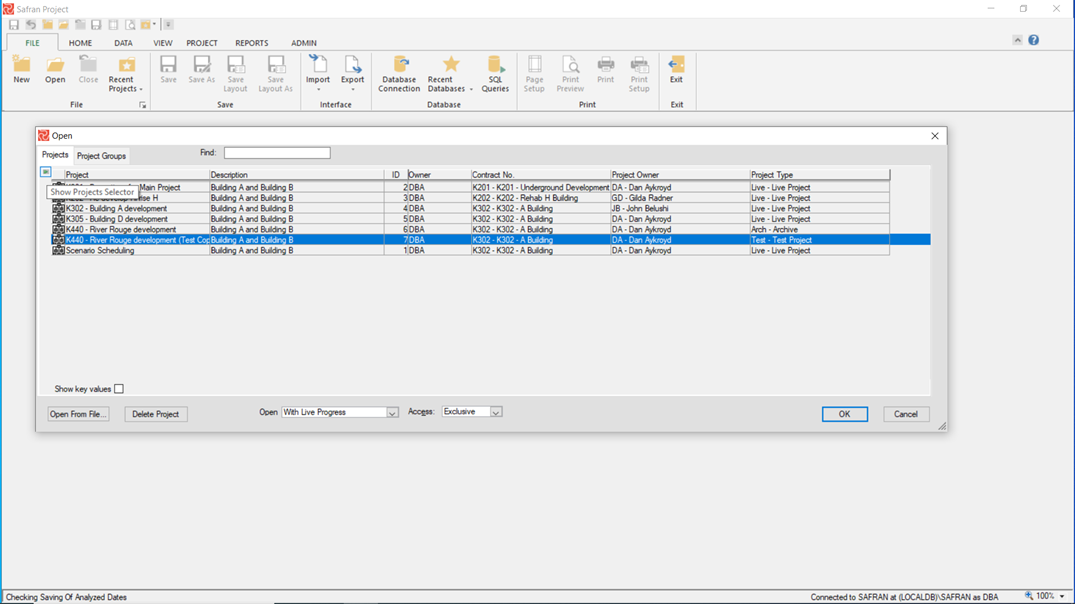
By pressing the 'Show Project Selector' button to the upper left in the File Open panel button (highlighted above), you'll be able to choose several Enterprise Fields to group on as shown below:
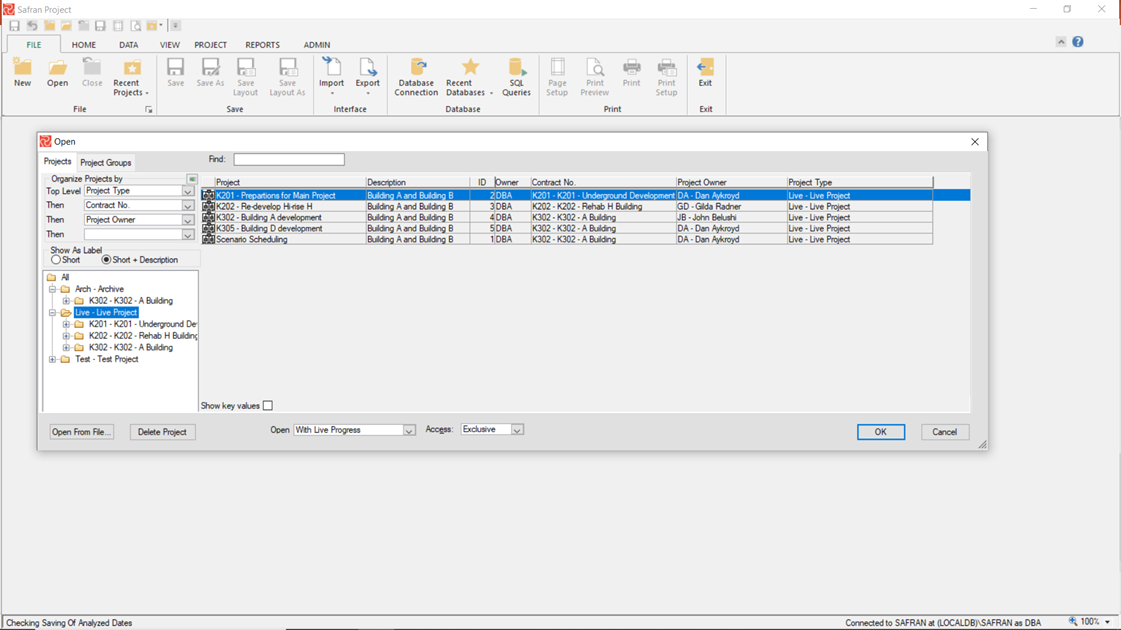
Enterprise fields are also available for grouping and sorting in the Barchart Editor and various reports. This is most relevant when working with Project Groups.
Scope
Safran Project provides you with three separate scopes to help you track and control your project:
- Baseline Scope
- Current Scope
- Total Scope
The Baseline scope would typically contain only the approved work for the project. The scope is kept frozen between Baseline updates/revisions as a point of reference to measure progress and performance and is only updated at pre-agreed intervals, typically Bi-annually. Progress measured and reported against the baseline is generally a client/project owner requirement.
The Current scope is slightly more 'dynamic.' It would typically accumulate approved changes in addition to the original baseline scope. However, it would be updated as a part of each Status Update and be more 'up to date' than the Baseline scope. This scope is often used for manpower histograms as it gives a more accurate picture than the baseline for the agreed resource requirement. Additionally, it may be used as a basis for progress measurement to see the 'true' project performance for projects with many changes to the project scope.
The Total scope is even more dynamic as it is updated at each Status Update; however, compared to the Baseline/Current scope, it also includes requested VOs. By using the Total scope as the basis for manpower histograms, you would be able to see a 'worst case' picture of the resource requirements if all requested changes were to be approved.
The above discussion of scope configuration is reflected in the default settings for a new project. Although the initial scope settings are experience-based 'sensible defaults,' you can change these to meet your project requirements.
Note: An essential and integral part of controlling scope summarization is the Change Control/Change Register functionality in Safran. After creating and 'freezing' your initial schedule, you can set up Safran to collect all changes to scope (additions/reductions to resources or new activities) in the Change Register. Changes can be categorized into four types/catagories: VO-Variation Order, VO-Request, Internal Change, and Subcontracted.
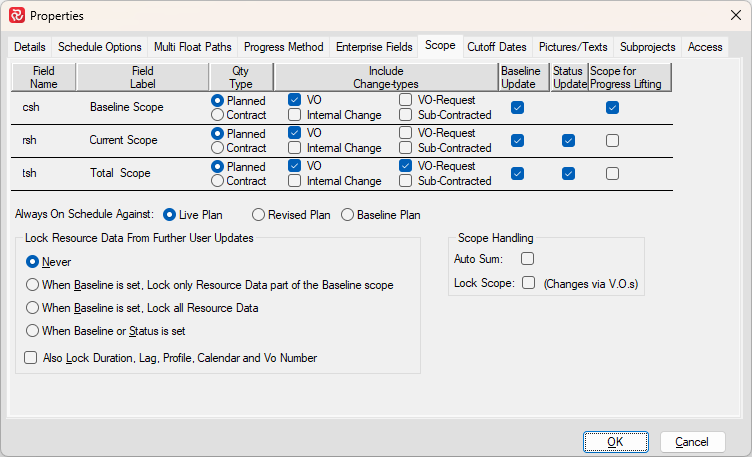
| Field | Description |
|---|---|
| Field name | The field code for the three separate scopes at the activity level. |
| Field label | The corresponding field description. |
| QTY type | Button to select one of the two quantity fields from the resource table. |
| Include change-types | Checkboxes for including the various change types in the scope fields. |
| Baseline update | Checkbox will include selected changes into scope sets during the Baseline update. |
| Status update | Checkbox will include selected changes into scope sets during the Status update. |
| Scope for progress lifting | Checkboxes to select which scope to use as a weighting factor when aggregating progress from resource to activity level. Only one field may be selected. |
| Always on schedule against | Checkbox to select schedule for 'AOS' activities. |
| Lock Resource Data From further User Updates | Configuration options for locking of resource entries. |
| Scope handling | Options for auto summary of autosum scopes and invoking of change order system. |
The Project Configuration— access/permissions system also controls Scope setup; hence, you can only modify the scope configuration for projects where you have been granted update access. Similarly, you may read (display) the QTY Configuration panel for all projects you have read access to.
How and when Quantities and Scopes are updated
Planned QTY is always the sum of all resource quantities for an activity irrelevant of Change type and status. If you enter/change a resource quantity, the Planned QTY is updated immediately.
The three scopes, Baseline(CSH), Current(RSH), and Total(TSH), will contain the original quantities from the initial baseline and accumulate quantities according to their configuration in the Properties/Scope panel. The three scopes will only be updated during a Baseline process and Status Update process again, according to the configuration made in the Properties/Scope panel.
The Total(TSH) scope will be updated at every change to a Planned QTY.
The two additional scopes, Current QTY(RSH Autosum) and Total QTY(TSH Autosum) will also be updated according to the guidelines above.
Because both Current and Total scopes are not updated between status updates, they would not immediately reflect a quantity change. This is because Baseline/Current/Total scopes are considered 'official,' must be 'consistent' figures, and are therefore only updated at pre-determined times.
To view and report on Current/Total quantities, including changes before they are updated as a part of a Status Update, you can select the 'Auto Sum' option on the Properties/Scope/Scope Handling panel. This will ensure that the fields Current QTY(RSH Autosum)/Total QTY(TSH Autosum) are always up to date when opening the Barchart editor or running a report. However, if you change a quantity, you must do a save/refresh (F5) to update the 'autosum' scopes.
The following set of screenshots illustrate the concepts discussed above.

Three activities have been added to a project, and resource quantities have been assigned. Planned QTY and Total QTY (TSH) are updated.

A Baseline process has been run. Baseline QTY(CSH), Current QTY (Autosum), and Total QTY (TSH Autosum) are now updated.

A Status Update has been run. Current QTY (RSH) has also been updated.

A new resource quantity/Change has been added with the status 'VO-request.' Planned QTY and Total QTY (TSH) are updated, while other fields (Autosum) remain the same.
If 'Autosum Scopes' was checked/turned on, and the project re-opened or refreshed (F5), you would see that both Current QTY (Autosum RSH)/Total QTY (Autosum TSH) are now updated. At the same time, Current QTY (RSH)/Total QTY (TSH) remain the same as these scopes are only updated during Baseline/Status Update processes.


Scope for Progress Lifting
Safran provides you with multiple reference points for aggregating progress while using the Barchart Editor based on the configurable scopes Baseline/Current/Total.
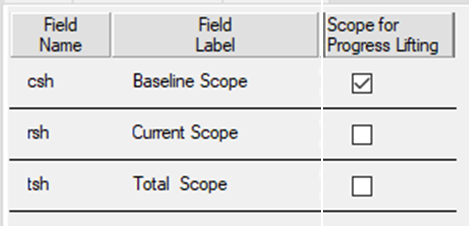
Note: This option primarily affects the way progress is aggregated in the Barchart Editor. A number of the report types in the Reports suite additionally have the ability to configure a 'User defined' scope the report should be based on.
When choosing the Baseline for progress aggregation, Safran would only consider activities/resources with a baseline in the calculation and present the %Actual for baselined activities/resources. A client or project owner would typically request progress information on this basis.
Considering a situation where a large amount of additional work/scope had been added to a project and agreed/approved after a baseline but not currently included in the baseline, it would be of value to be able to check/follow the progress of all approved scope and get an impression of the project's 'true' progress. Switching the progress lifting basis from Baseline to Current and looking at the Barchart Editor %Actual would give you this information.
Switching between scopes for this purpose may be done at any time, but using the correct aggregation basis for the relevant report is imperative.
Instead of switching in Properties, adding the following columns in the Barchart Editor is now possible. Please remember they only "work" on the Summary levels defined in Group Properties.
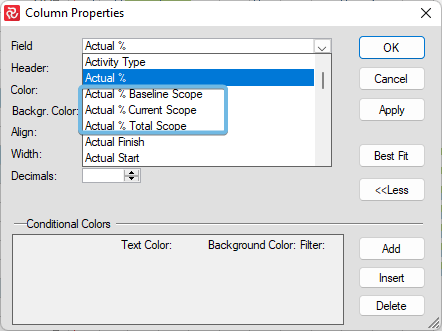
Always On Schedule Against
Safran allows you to have activities considered 'always on schedule' (AOS / auto progress). As a part of each Status Update, Safran calculates a 'Planned Progress' percentage for each activity. For AOS activities, the %Actual would automatically equal the planned progress figure for that cut-off.

The default option is to use the Live Plan; however, depending upon your use of Safran, you might change this to follow either the Revised or the Baseline Plan. If you do so, you should be aware that new activities added after either running a Baseline or generating a Revised Plan would not have a Baseline/Revised Plan. Therefore, Safran could not calculate a planned progress percentage for the activities in question.
Lock Scope
The option to Lock scope as part of Scope Handling ensures that planners use the VO/Change register functionality to adjust the activity scope. The VO/Change register provides you with a detailed overview of all changes to the project scope. Also, it allows you to compare your Baseline scope to your Current or Total scope, providing you with a picture of the project's variation in scope.

It is highly recommended that you enable Lock Scope after setting the initial baseline so Safran can track changes to the scope.
Lock scope ensures that you use the Change Control system. When you add another activity with a resource or another resource record to an existing activity after running the Baseline, you need to 'connect' it to a Change to save it.
Until you run a Baseline, you can still delete the resource; however, you need to delete it from the Change Register. After running a baseline process, you are not allowed to delete a resource that exists when running the process.
In all cases discussed above, you can always change the resource quantity.
If, for some reason, you don't want to use Lock scope, you can/should still make scope changes through the Change register.
For more information on how to use the Change Register, please see the topic, Change Control.
Note: The "Lock Scope"-functionality has changed throughout the later releases. If you want to use Lock Scope as you did in, e.g., Safran version 5.0, you must also use the "Lock Resource data from further updates" configuration. Also note that even though you export a project with "Lock Scope" enabled, you would have to re-enable it after import should you wish to keep it enabled.
Lock Resource Data From Further User Updates
In addition to controlling the deletion of resources, Safran also provides options to control the updating of resources during project execution concerning which part of the resource may be locked and when/during which process it is locked.
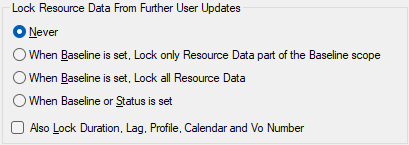
The default setting for locking for a new project is 'Never'. This option will allow you to change all resource related data at all times. However, for most projects with a fixed scope, it is highly recommended to use a locking option, as this will ease the tracking of changes and ensure consistent progress reporting as the project develops.
For the purpose of locking Resource Data, resource information is divided into two categories Resource Data and Schedule/VO data.

When configuring Resource Data locking you have three main options governing which resources will be locked as well as when the locks will be applied. In addition to the main option you choose, you may also elect to lock the resource’s Schedule/VO information.
In all cases you will still be able to enter/update the resource’s Status information.
- When Baseline is set. Lock only the Resource data part of the Baseline scope.
The resources that will be locked by selecting this option will depend upon how your Baseline scope is defined. Consider the default Baseline scope configuration that only contains/includes new resources that have the VO-status VO/approved. In this case if you have an activity with a resource with any other status than VO, ie. VO-Request/Internal Change/Sub-Contracted, this resource will not be locked.
The picture below illustrates the effect of choosing this option. The first resource is part of the original baseline (VO absent), is in gray and and the resource data may not be edited. Note that the second resource is part of a VO with the VO type/status 'VO-request' and may therefore be edited.

- When Baseline is set. Lock all Resource Data.
This option will lock resource data for all resources, irrelevant of VO type/status when running a Baseline update. If a new resource is added, it may however be modified up and until a new baseline is set.
In the picture below note that both resources are in gray and may no longer be edited.

- When Baseline or Status is set.
This option will lock resource data for all resources, irrelevant of change type when running both Baseline and Status updates. If a new resource is added, it may however be modified up and until a new status/baseline is set.
Choosing 'When Baseline or Status is set' would put more rigid time limits regarding when the resources would be locked.
- Also Lock Duration, Lag, Profile, Calendar and Vo Number.
In addition to the to the main locking option you select, choosing this option will additionally lock the related Schedule/VO information for the relevant resources.

Cutoff Dates
After entering your project span and selecting the weekday for Cut-Offs, Safran Project generates the Cut-Off date table. This table lists reporting dates and periods that may be configured as hourly, daily, weekly, monthly, and optionally bi-weekly for reporting purposes. The cut-off dates table is used to control the status update process. You can access the table to modify cut-off dates for bi-weekly and monthly reporting periods. The data content in this table may be modified, although no records may be added or deleted.
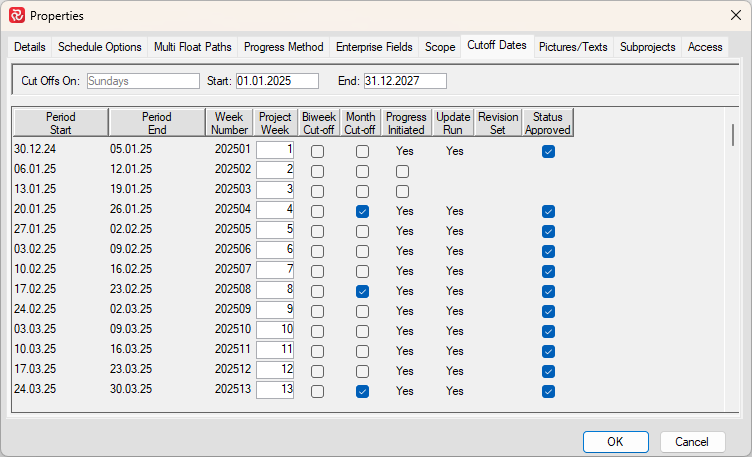
| Field | Description |
|---|---|
| Period Start | Period start date, display only field, according to specified weekday for cut-offs. |
| Period End | Period end date, display only field, according to specified weekday for cut-offs. |
| Week Number | Displays the calendar week number. |
| Project Week | A consecutive number starting at 1, counting numbers of weeks in the project span. |
| Bi-week Cut-Off | Marks weeks to be used as biweekly cut-off during periodic reporting. |
| Month Cut-Off | Marks weeks to be used as monthly cut-off during regular reporting. The last cut-off date for every calendar month. |
| Progress Initiated | Output field. Displays "yes" if progress input has been started for a specific week. |
| Update Run | Output field. Displays "yes" if a status update has been run for a particular week. |
| History Saved | Output field. Updated if users mark the save history checkbox during the status update. |
| Revision Set | The output field shows when a Set Revision process has run. |
| Status Approved | Status flag showing management approval of status update. The flag does not affect the application and is information only. |
Safran Project also supports work-intensive shift-oriented projects such as Turnarounds by allowing you to have multiple shifts/cut-offs. To enable this function, select the Lowest duration units to be either Hours or Minutes in the details tab.

Now, if you go back to the Cut-Off Dates tab, you can select Multiple Hours Shifts in the 'Cut-Offs On' drop-down list.
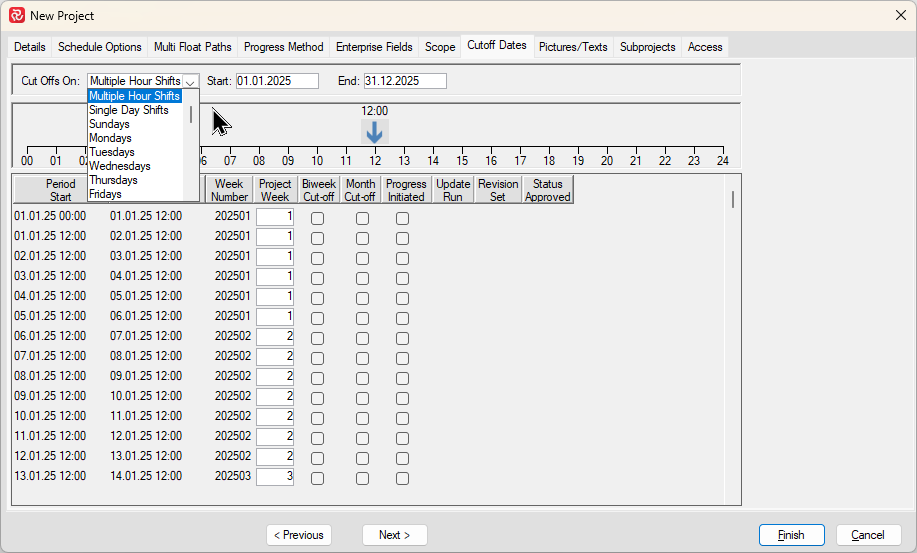
You'll notice that an hour-based daily 'timeline' appears above the usual list of cut-off dates. By default, the day is divided in 2 shifts 00:00-12:00 and 12:00-24:00, however a total of 6 daily shifts/cut-offs may be entered by right-clicking on the appropriate hour and selecting 'Add Cutoff'.
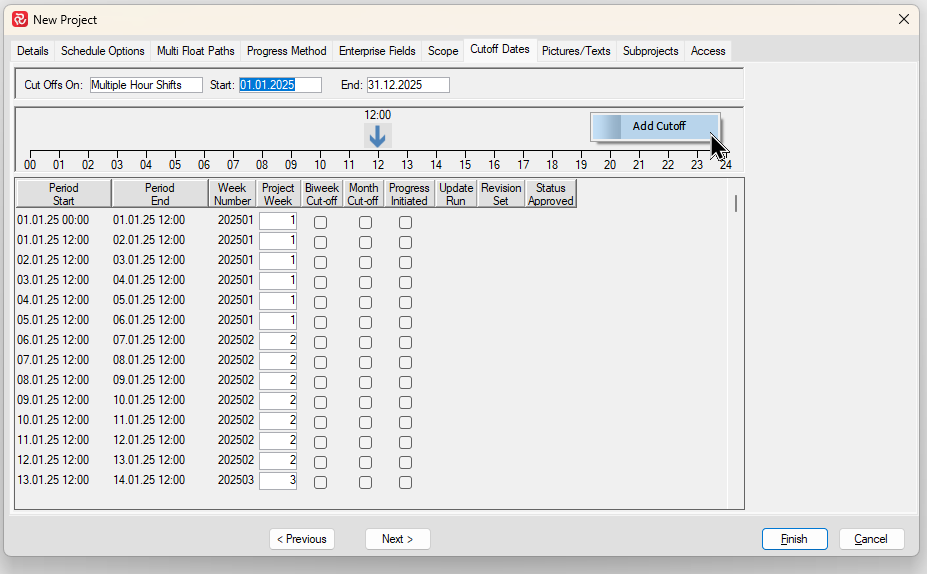
A new Cut-off will be added for the hour where you right-clicked.
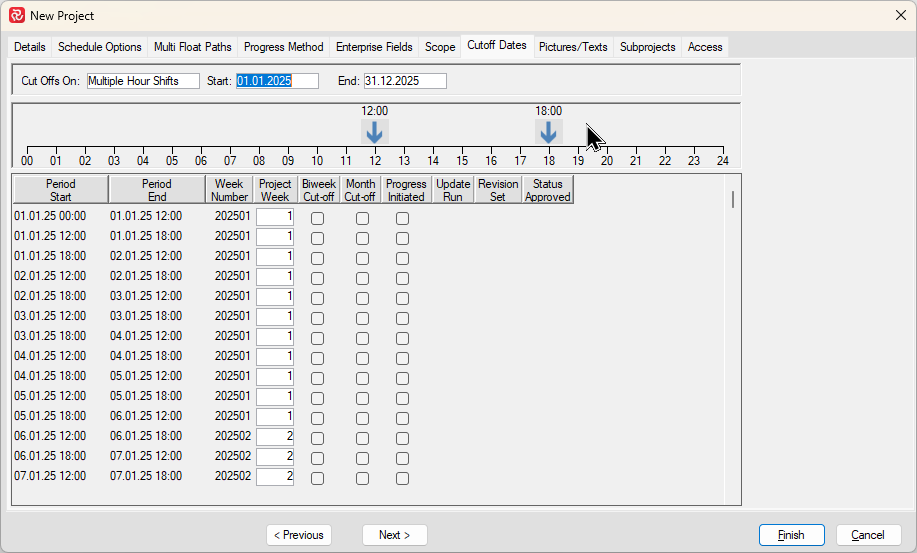
Any number of Cut-offs may be defined in this manner.
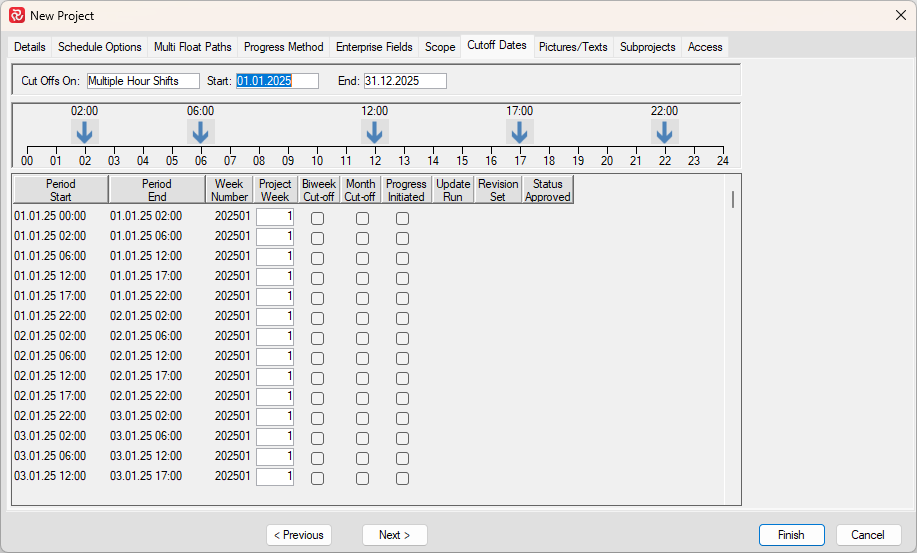
Existing cut-offs may be deleted by right-clicking the cut-off arrow symbol and selecting Delete Cutoff.
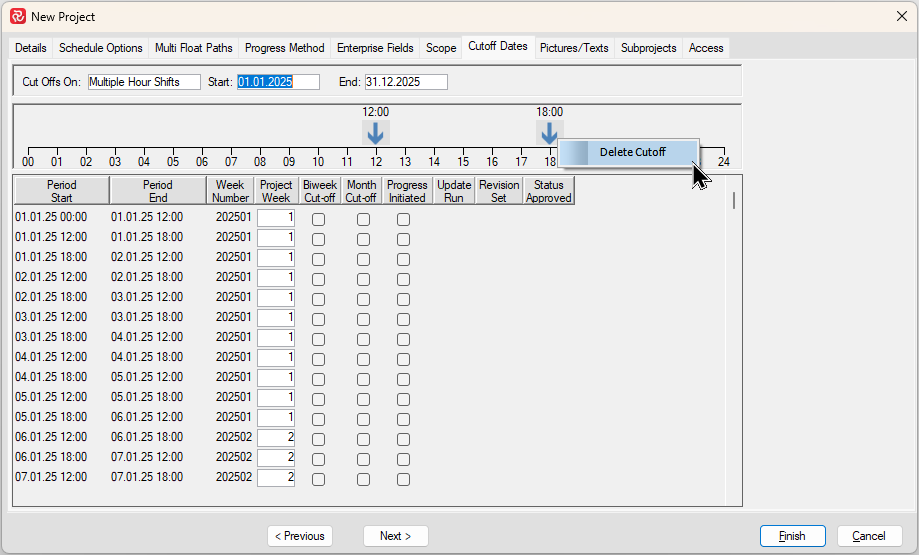
Pictures/Texts
Safran Project provides you with a the following standard project texts for use in the report header area:
- Title
- Text 1-4
- Client
- Contractor
You can also include logos for your project (usually your company’s logo) and your client, which may also be placed on the right and left of the header area.
Your logo must be saved as a BMP, JPG, or PNG-type file.
To add a photo or logo, right-click on the logo area, choose your relevant option, and select your file.
The information fields Title and Client and Project/Client logos will then be available as defaults for all your reports.

An example report showing the default project information as described above:
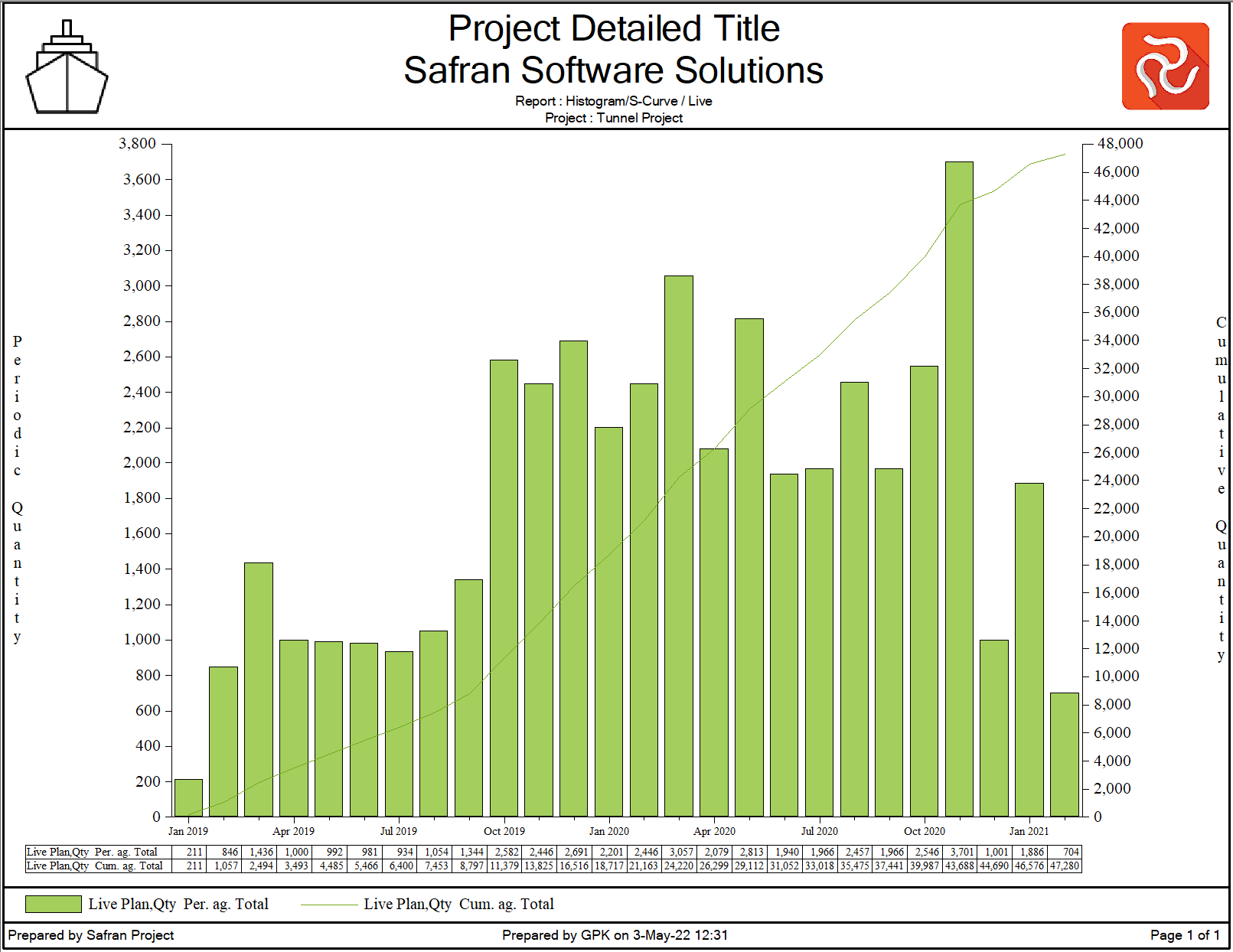
Access
The User who creates a new project is considered the project Owner. Only the Owner can share their project with other users or groups of users by granting access to the project.
Note: If no access has been given to a project, it will not be visible to other users on the File/Open menu.
Keep in mind that Project access only gives access to core project data such as activities, links, resources and so forth. The library sets associated with a project have their own access government.
The available access levels are described below:
Read: Users are only allowed to view data on-screen. No updates are allowed, either on-screen or to the database. Safran Project supports an unlimited number of simultaneous users to access a project in Read Mode.
Test: In Test mode, users can change project data to see the effect on the screen but are not allowed to save changes to the database. Users may commit changes to a different project name using the 'Save As' option. Safran Project supports an unlimited number of simultaneous users in Test Mode.
Update: In Update mode, users Add, Delete or Modify project data. Safran Project supports an unlimited number of simultaneous users in Update Mode.
Exclusive: Allows exclusive update access to the project. If a user has opened the project in Exclusive mode, Safran Project will not allow additional users to access that project in Update mode.
To grant access to your project, select the Access tab on the far right of the Properties panel:
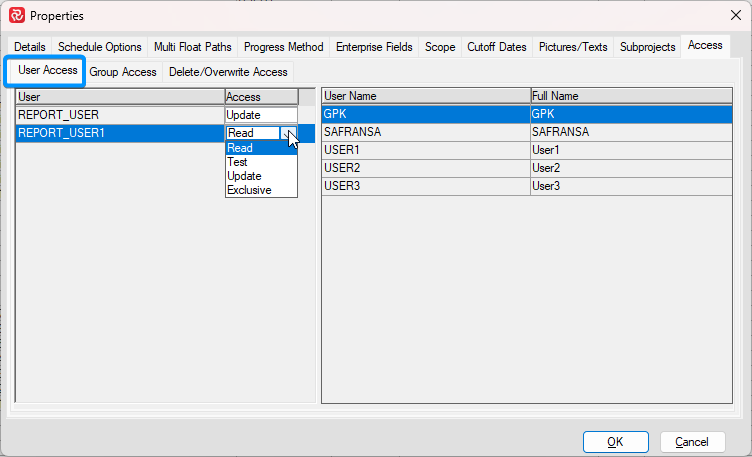
The access tab is divided in three sub-tabs, User, Group, and Delete/Overwrite. The Right portion of each panel consists of a list of database users without access.
To grant access, select/set focus on a user name, and using the drag and drop technique, drag the user to the left. You can then drop in to the Access dropdown and select the relevant access level to be granted.
Removing access is done in a similar way, select/set focus on a user name, and using the drag and drop technique, drag the user to the right.
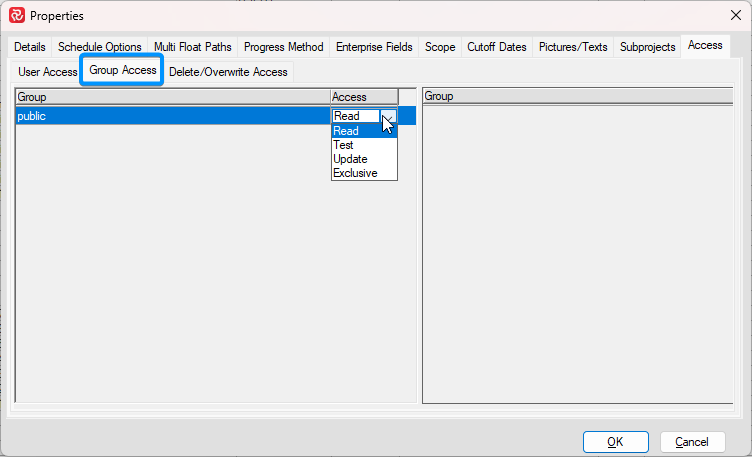
In larger organizations with multitudes of both projects and users it's often easier to grant access to groups of users in stead of on a 'one by one' basis. The Group Access sub-tab allows you to give access to groups of users in the same way as for single users. User Groups must however first be established in the Safran System Administration module.
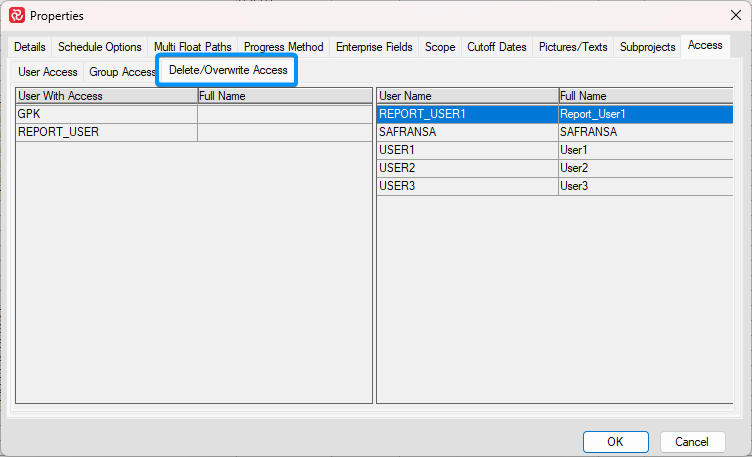
By default, Safran will only allow the Owner of a project to Delete or Overwrite (relevant when importing a project) the project. The Delete/Overwrite sub-tab allows the project owner to nominate additional users to have this ability. Use the 'drag n drop' technique to add/remove users.
Working with Library sets
Library Sets are found either, under the ADMIN menu:

or, the DATA menu:

In order to access a Set from the DATA menu, you'll need to first open the Project itself. If a Set type is inactive (grey) on the Data Tab, it means that the Set type is not available for this project. To add it to a project, you'll need to open the Project Properties.
Calendars
Entering Calendar Data
Calendars consist of working hours per day, holidays, vacations, and other rest periods, allowing Safran Project to determine valid working periods. There is no need to enter hours per day for hourly-based calendars, only non-working periods. Safran Project supports unlimited calendars per project, facilitating extensive and complex requirements modeling. Calendar sets are assigned to each project, specifically to your project plan's activities, resources, and constraints. For example, if specific work requires a 5-day workweek, while other activities are performed during a particular period, you may create different calendars and assign various activities to each. Safran Project utilizes calendar information in all calculations involving dates, time arithmetic, schedule analysis, resource-load calculations, aggregate, etc. Calendars are essential in defining detailed and accurate schedules.
Specifying Calendar Units
The minimum unit for activity duration is controlled by the calendar type entry and is specified for your project. If you assign a calendar set specified with hours as units, all activity durations are perceived as hours during input and all calculations involving time arithmetic.
Specifying Calendar Span
You specify the calendar span for the entire project by entering a calendar start date and a calendar finish date.
Adding a New Calendar
Select Calendars from the DATA ribbon and select New Calendar on the right-hand side of the calendar editor window.
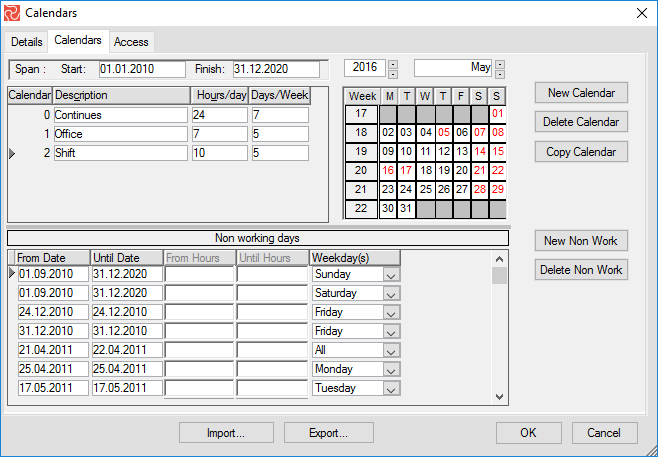
Safran Project now adds the new calendar line to the calendar editor window and defaults to using 7.5 hours daily. Now, you may enter your data, including a description of the new calendar.
| Fields | Description |
|---|---|
| Calendar | The calendar work pattern number is a number assigned by Safran Project. |
| Description | Enter a description for your calendar hours. |
| Hour/day | Enter the number of working hours per day. They are used for computing staffing workload. |
| Days/week | They are used when calculating Activity durations when duration is entered as a number of weeks. |
| From | Enter the start date for the non-working period. |
| Until | Enter the end date for the non-working period. |
| Weekday(s) | Enter a weekday as the non-working day or select all to indicate vacations or other nonworking periods. Single-day exceptions can also be made for dates that should waive the regular patterns. |
Copying a Calendar
To copy an existing calendar, choose the Copy Calendar option on the right-hand side of the calendar editor window.
Importing and Exporting Calendar Data
The Import and Export options used to export and import non-working period data for a selected calendar will be found at the bottom of the calendar editor window. You can use these options to quickly build a new calendar set with individual calendars from different calendar sets in your Safran database.
Specifying Non-Working Periods
Click the "New Non-Work” button, and Safran Project adds a new line to the non-working days table in the calendar editor window. Use this table to enter further non-working information. Time off may be entered as a specific date, for example, January 1st, a weekday (Saturday, Sunday), or a vacation or holiday period spanning several days or weeks. In either case, Safran Project requires both the From and Until date to be entered. If you work on an hourly or minute-based calendar, the from/until date may be specified to the hour using the additional from/until hour fields.
It is also possible to define Work Exceptions as individual dates or a range of dates that need to contradict the regular pattern of Non-Working Periods. For instance, if every Saturday is usually defined as Non-Work, it is possible to override this for one or more Saturdays that should still be work days. This makes it less cumbersome to define and administer complex calendar definitions.
Recommendation:
It is possible to enter non-working periods and not set a From or Until date, e.g., every Saturday or Sunday.
Recommendation if you are going to import the Safran plan into Synchro:
If you know you will send your Safran plan to Synchro, it is highly recommended to add every non-working period. If you have a week of non-work in a day-based calendar, add this to the Non-Working period as seven individual lines of non-work.
Deleting Non-Working Periods
Select the Delete Non-Work option in the calendar editor window to delete the selected non-working line.
Renaming a Calendar
To rename a calendar, edit the calendar description field. You are only allowed to edit the calendars of calendar sets where you have been given update access rights. Save your changes to the database after editing the calendar name to store the new name.
Assigning a Calendar
The different calendars are assigned to activities, constraints, and resources that comprise your project’s plan. By giving other calendars, you may create a project plan that allows you to plan and control complex project requirements. By default, Safran Project suggests calendar 0 for all activities, resources, and constraints. If you have defined additional calendars, you may assign them to the project elements using the appropriate forms or editors.
Changing Calendar Data
Rest periods and time off can be added to calendars as described above. Modifying an existing calendar by changing/deleting time-off periods or adding new ones may affect associated activities. If so, this will also affect your plans and schedules.
Keep in mind that once a calendar is used on an activity/resource that has been part of Baseline process or Status Update, the calendar in question will be presented in grey and may not be modified. This is due to the fact that changing a calendars characteristics would in this case potentially change historic data.
Deleting a Calendar
Choose Delete Calendar from the calendar editor window to delete the current calendar. You cannot delete a calendar if assigned to an activity, constraint, or resource requirement.
Advanced Calendar Features
Advanced Calendar Features were part of the Safran Project 25.1 release, you can read more about that in this article: Advanced Calendar Features
Profiles
Safran Project has facilities for distributing resource requirements and associated costs in two ways: linear or based on user-defined profiles. By default, Safran Project performs a linear distribution. This may be overridden by user input.
Linear Distribution
Safran Project evenly distributes the resource requirements (and cost) across the resource's duration. In Safran Project, resource requirements may have delays and durations. If you assign your help a time, Safran Project will spread the need proportionally over the resource duration, applying the resource delay to calculate the required resource's start and end date. By using multiple resource requirements, including delays and durations, it is possible to create complex resource profiles when summarized to the activity level.
Profiled Distribution
As an alternative to the proportional or flat-load distribution, using profiles provides a quick way to spread your requirements over time, based on user-defined distribution profiles. Again, Safran Project does all the work for you, spreading the resource requirements over time. For example, you might anticipate using a resource to be intensive at the beginning of an activity and taper off towards completion. A graphical representation of this requirement would describe a front-loaded curve. Safran Project distributes any resource requirement according to the profile you define/apply. When utilizing a distribution profile on your resource requirement, combining this with resource delays and durations is also possible. The profile will then be applied to the specified duration of the resource requirement.
Adding and Editing Distribution Profiles
To add or edit existing profiles, select Profiles in the DATA ribbon. Select New Profile in the profiles window. Enter a name in the profile name field and the necessary reference points in the % time and % load fields.
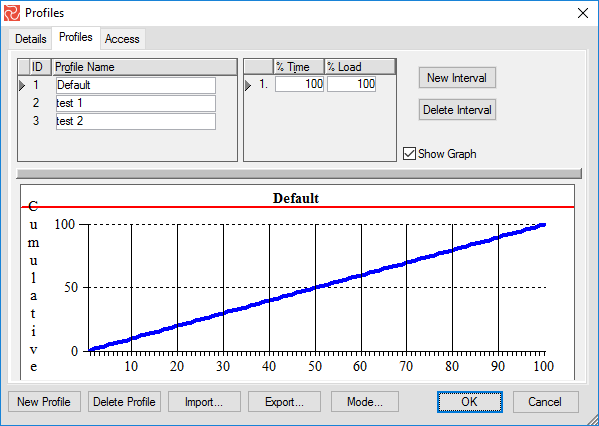
The ‘% Time’ field represents a point in time relative to the resource duration. The ‘% Load’ field represents the corresponding cumulative percentage of the total resource requirement to be used. Safran Project requires all percentage values (Time/Load) to be entered as integers. You may enter a maximum of 100 x y points to help define the shape of a distribution profile, although a minimum of 2 x y points are required (0,0 and 100,100).
Viewing a Profile as a Curve or as a Histogram
The profile's graphic representation may be viewed as a curve (Cumulative) or a histogram (Periodic). To switch between these views, click the Mode button in the graph area.
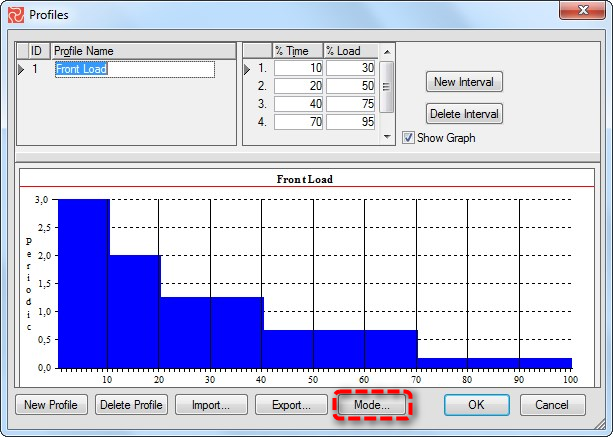
Deleting a Profile
Highlight the profile you would like to delete and select Delete Profile. Safran Project asks you to confirm the deletion of the profiles.
Importing & Exporting Profiles
Safran Project supports both tab-separated text files and XML files.
Resources
You can develop a Critical Path Network integrating activities, logic, resources, and cost to control your project effectively. Activity durations and logical constraints are the basis for the Critical Path; however, the resulting schedule does not consider resource requirements and availability. Your plan may not be complete until you consider the question of resources. Resources are physical elements needed to perform the work. They usually extend across activities and projects. You can assign a calendar and define the resources’ cost over time. To minimize the time and cost of a project, resources must be effectively controlled—particularly human resources. The resources required by each activity and the quantities available over the relevant period will determine whether each activity can still be scheduled at its earliest possible date or needs to be delayed until the required amount of resources is available. When it comes to working with resources, the following tasks and issues should be considered:
- What resources are required?
- When will the resources be required?
- A definition of the individual resources required.
- The availability of each resource over time during the life of the project.
- The unit cost of the resource. Does the contract allow for constant cost rates throughout the project's life, or are complex rates with escalation tables and overheads required?
- An estimation of the resource(s) required for each activity in the project
- Should the resources be planned linearly spread or as profiles over the resource or activity duration?
This may seem like many options, issues, and questions to consider, and might seem intimidating. Below are the steps to follow.
Defining New Resources
Choose Resources from the DATA ribbon to add or modify resource definitions in your project.
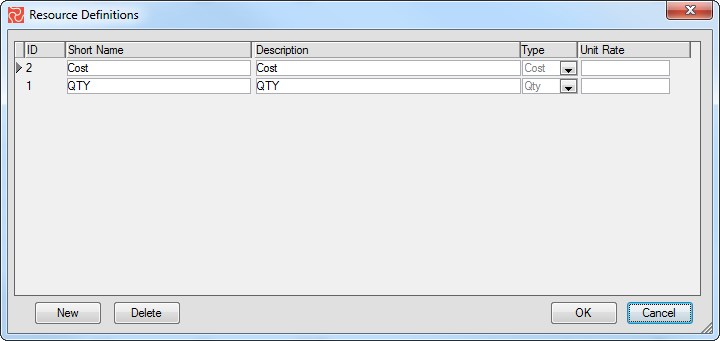
Choose New to add a resource definition to your resource definition set. Safran Project inserts a new line, a resource record, in the window.
| Field | Description |
|---|---|
| Short Name | Enter the resource shortcode. The application in the list box uses this code. |
| Description | Enter a description for the resource. |
| Type | Specify the Resource type. Available options are QTY or Cost. Only resources of QTY will be considered in a resource leveling process. |
| Unit Rate | The rate per unit for the resource. Available only for QTY-type resources. The Unit Cost Rate is used in cost calculations. |
Deleting a Resource Definition
If a resource definition is not in use, i.e., associated with any resource requirements/activities, you can delete it from your resource definition set by clicking the Delete button.
Userfields
Since projects are seldom the exact same, you may need to track information that’s unique to your project, process, or organization.
Custom user fields allow you to extend Safran to suit your business and project needs and track additional data such as purchase/delivery dates, purchase order numbers, work orders, work breakdown structures, responsibility, and other codes and references.
Once defined in the userfield data dictionary, userfields are available in the barchart editor as Activity Columns and Activity Information. Userfields are often included in filter expressions and may also be used to structure your schedule and sort activities. You can perform calculations and do conditional tests a userfield in order to zoom in/focus on areas of concern.
Safran provides you with a comprehensive range and high number of userfields. A total of 730 user defined fields are now available (Safran Project v. 22.2: 290).
A brief overview is shown below:
| Field | Short | >v22.2x | v22.2x | Description |
|---|---|---|---|---|
| Reference | R | 100 | 60 | Codes and defined list values |
| Text | F | 100 | 40 | Text |
| Date | D | 100 | 40 | Dates |
| Flag | L | 100 | 40 | Checkbox, single character |
| Decimal | N | 100 | 20 | Decimal |
| Duration | U | 100 | 10 | Duration |
| Outline codes | O | 30 | 30 | Custom codes or tags that allow you to show a hierarchy of activities in your product |
| Computed | C | 100 | 50 | Computed/calculated display fields |
Reference fields and Outline codes consist of a list of predefined codes/description.
You can use a reference field to define a list of valid codes for the field and an associated text description. As an example, you might define a reference field called “DEPARTMENT" containing the following items:
| Value/short code | Description |
|---|---|
| MNGMT | Management |
| ENG | Engineering |
| PREFAB | Prefabrication |
| STRUCT | Structural steel |
When you enter data into a Reference field for an activity, as in the above example, the Department field, Safran Project ensures the value entered is in the list. Safran Project provides a list of valid values ensuring quick and efficient data entry and validation. Furthermore, Safran Project uses the text description for summary line titles whenever you summarize your schedule.
Reference fields are often used to code activities with their relevant WBS code, Discipline, Contractor code, Sub-contractor, Level 4 code, System, Department, Section, Area, Phase, and so forth. Reference fields are often used to group activities and summarize information in the Barchart Editor and in a number of report styles
For any of the Reference fields R1-R100, you may enter an unlimited number of codes & descriptions.
Outline Codes are slightly different than reference fields as they are hierarchical by nature consisting of a number of nodes with parent-sibling relationships.
You can use the Outline Codes to create a hierarchical structure for your project that can be used to sort, select, and group activities.
When you create an outline code, you start by defining the number of levels in your structure and the coding for each level. Outline codes allow you to show a hierarchy of activities differing from the dynamic grouping by reference codes. Outline codes are typically used for WBS, OBS, or any other fixed breakdown structure such as AA.BBB.C01.DD, AA.BBB.C02.DD, AB.BBB.C01.DD, etc.
The userfield type Computed is also slightly different as a Computed field may not be entered manually and is always the result of a calculation. Further, they are only (temporarily) available in the Barchart Editor and are not stored as ordinary fields or columns in the database.
See, Enterprise Fields, for user-defined codes defined per Project ID (instead of per Activity ID).
Adding New Userfields
Userfield configuration may be done either when initially creating a project or at any time after the project has been created.
You’ll also notice that the Userfield configuration tool is available in two places with slightly differing capabilities.
From the Data ribbon, Userfields allows you to access and configure userfields for your current project.
From the Admin ribbon, Userfield Sets allows you to access and potentially configure userfields for any Userfield set you have access to.
The userfield configuration panel is a tab-separated window organized by userfield type.
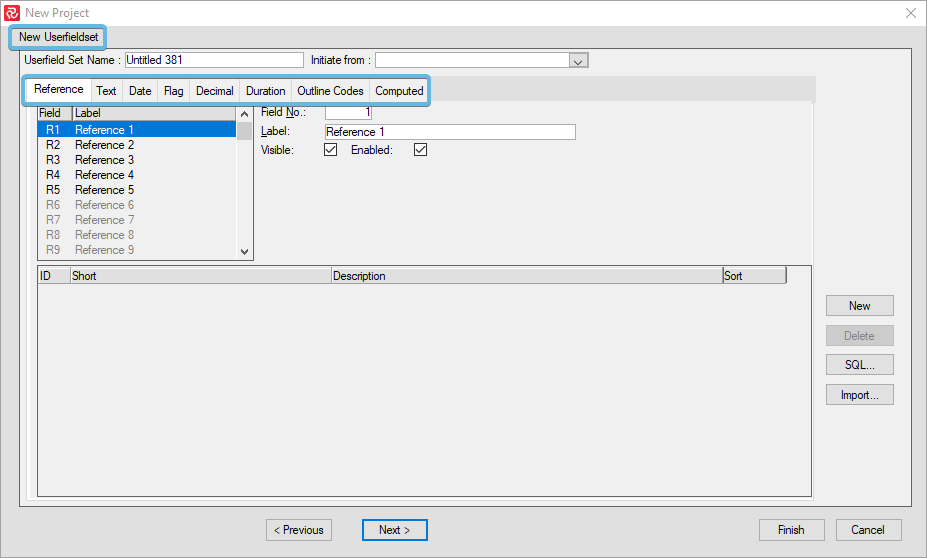
A label, predefined codes, description, and an optional sort value define reference fields.
The Text, Date, Flag, Decimal, and Duration type fields are characterized by a label, further you can also define formulas to be applied at the activity level and the Summary/group level for the Barchart Editor.
A label, the maximum number of levels, and a detailed outline configuration define the Outline codes.
Computed fields are represented by label, type, and formula.
Select the tab corresponding to the required field or column type to add a new code, then press the ‘New’ button.
-
By pressing "New" in this window above, you will add a code to the Reference field 1 (R1). You may also import codes from a text file.
-
Pressing the "Delete" button deletes the current line containing a userfield definition record.
-
If you wish to create other fields than Reference fields, you should press on the various tabs:

- By pressing "Next," the wizard will save a userfield set for your new project and take you to the next step: creating a resource set for your project.
Modifying a userfield
During the New Project Wizard setup, adding all userfields and userfield codes at once is unnecessary. This may be modified later on. In fact, in most projects, the userfields are constantly updated with new codes during project execution.
To modify your userfield later, open your Project and go to Data>Userfields.
Deleting a Userfield Set
To delete a Userfield Set, go to Admin>Userfields, right-click and delete.

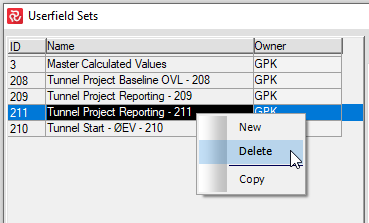
Adding/Deleting Reference Field Codes
Move your cursor to the codes part of the pane and press ‘New’ to add a new short code-value description and sort.
Pressing the ‘Delete’ button lets you delete a single or all codes for a Reference field.
Please note that you cannot delete reference fields or outline codes if the userfield code is in use (assigned to an activity).
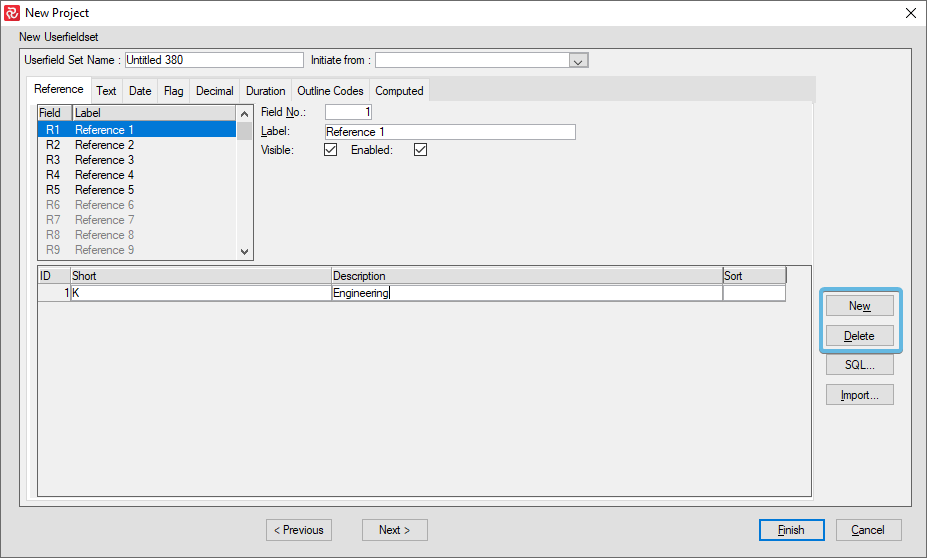
Importing Reference Fields from File
Valid reference field values may be imported from a file. The file must be a tab-separated text file with the following format: CODE tab DESCRIPTION tab SORT (optional). Then press Import.
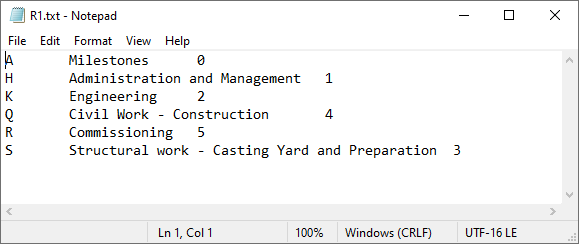
How to import from a text-file
- Add a Label.
- Ensure Visible and Enabled are ticked.
- Press import and locate your text file.
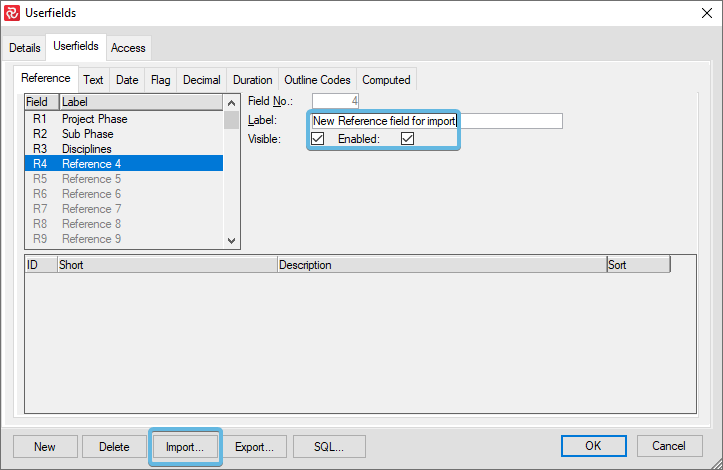
Tip: If you are uncertain how to make an import file like this, export an existing Reference field and then edit and import that file.

Assigning Reference Fields and Codes from Foreign Tables
It is not uncommon for larger organizations to keep such information in a data repository. To save repetitive data entry and duplicating information, Safran Project allows you to assign your code values from tables other than the code sets in the Safran data structures. To use this feature, you must have proper knowledge of Safran Project data structure and be familiar with SQL. The codes may be assigned from other Safran Project tables or foreign tables. Press the ‘SQL’ button, and within the ‘Table Select’ window, you may edit or write your own SQL select statement.
Open your Userfield set and click on the field (e.g., R1) that you wish shall inherit codes from another Userfield set. Click on the "SQL"-button.
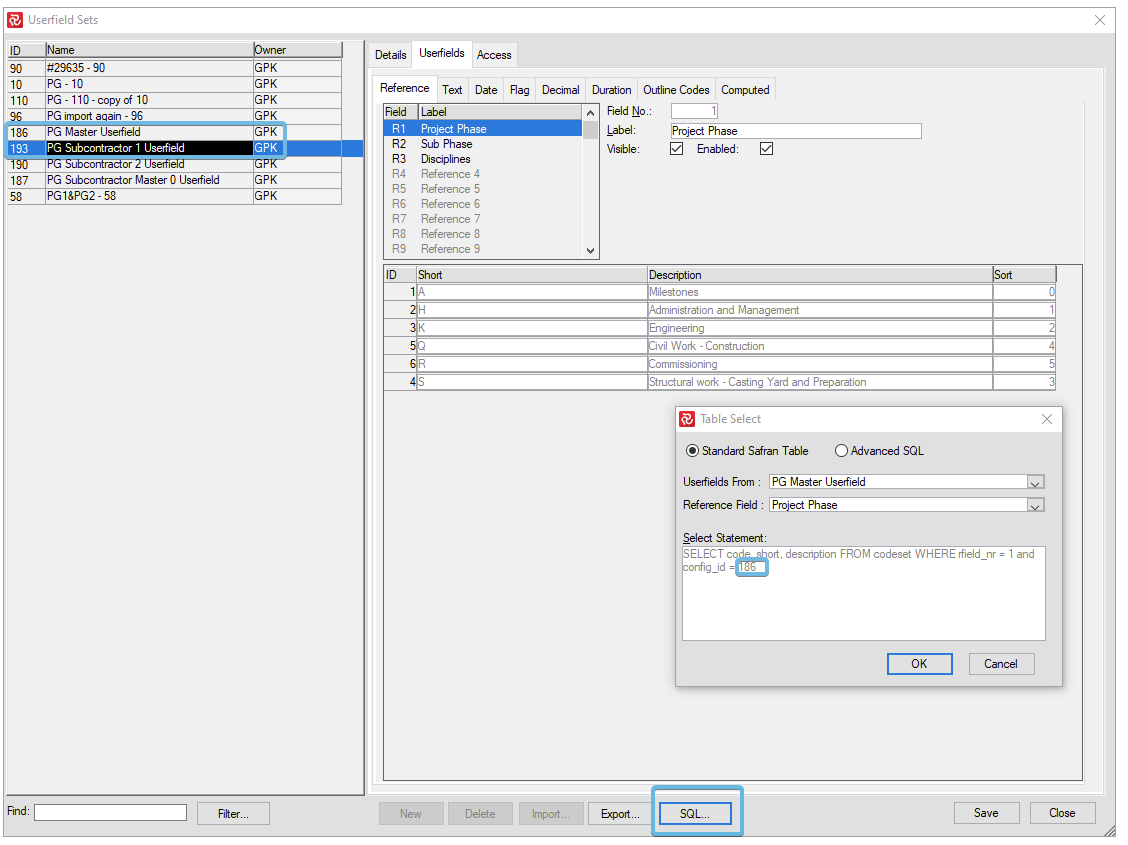
The above figure shows the default select statement generated by Safran Project. This statement corresponds to the definitions entered. You may edit or overwrite this statement to allow for other references.
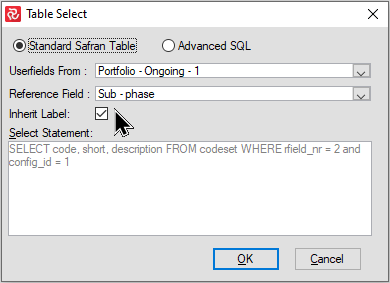
When referencing userfields from other userfield sets the name/label of your 'local' field will remain the default ie. 'Reference 2' allows you to specify your label. Check the' Inherit Label' box to use the label from the referenced field.
Notice how ID 186 has black (editable) fields:
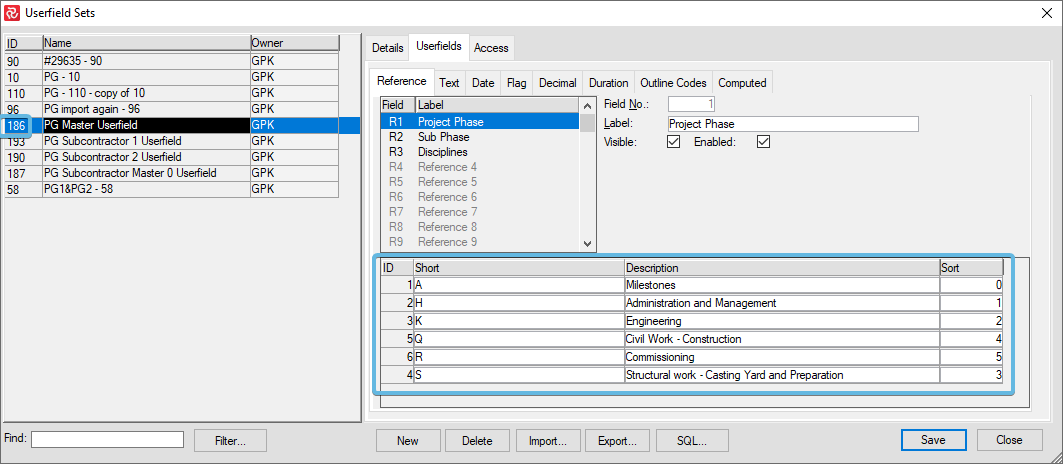
While ID 193, which reads from ID 186, has grey (none-editable) fields:
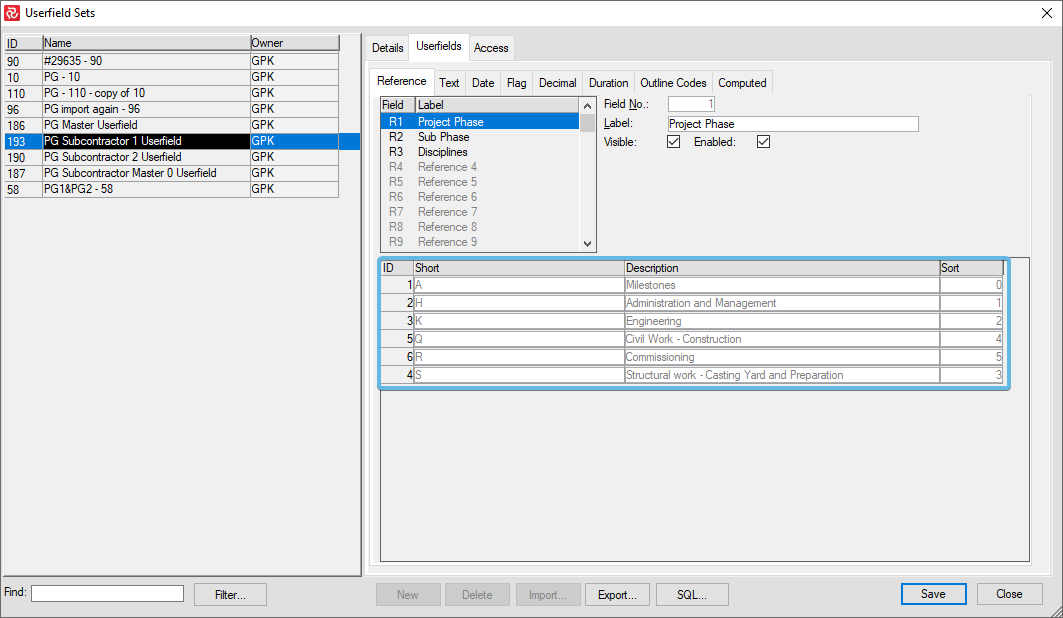
Similar functionality is available in other fields as well:
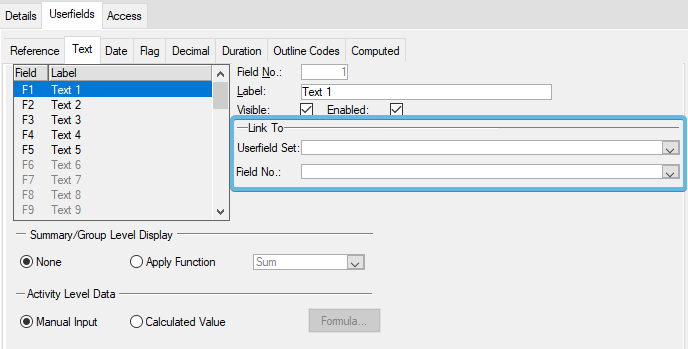
Outline Codes
Outline Codes allow you to create a corporate, project-specific, and user-defined hierarchy of activities and structure for your project. The breakdown structures by work, cost, organization, physical or other, all illustrate your project's division in successively greater detail. You can create multi-level codes consisting of uppercase or lowercase letters, numbers, or characters that you specify. As you define your outline codes, you create a lookup table that makes entering or assigning outline codes for each activity easier. A total of 30 Outline Code fields are available each with up to 25 levels of detail.
To define an Outline Code, set focus on a field and give it a relevant name in the Label box. Next, ensure that Visible and Enabled are checked. Then, select a maximum number of levels for the structure. The Max Level may be modified at a later time if required.
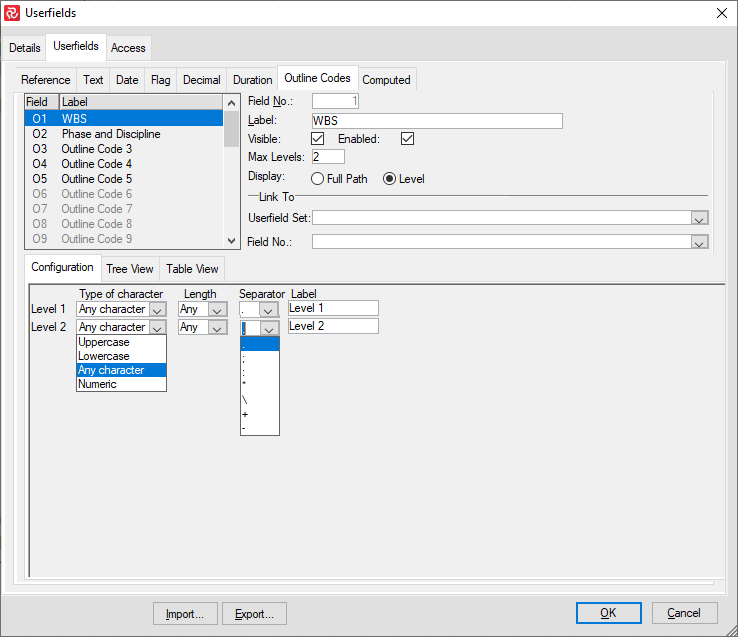
The Display Full Path/Level determines how the code will be presented when the field is shown in the barchart editor, either as the full path to the node chosen or just the selected node value.
Link To Userfield Set/Field number allows you to utilize existing code definitions from other Userfield sets in your database. This is often used to simplify/enforce corporate or industry coding standards.
When you have determined your Max Level, Safran establishes a list of levels in the Configuration panel. You can configure the type of character allowed, length, separating characters, and name/label describing the level for each level. The maximum number of levels allowed in Safran Project is 25.
After you have specified the basic characteristics of the outline code field, select the Tree View panel to enter Nodes and build your structure.
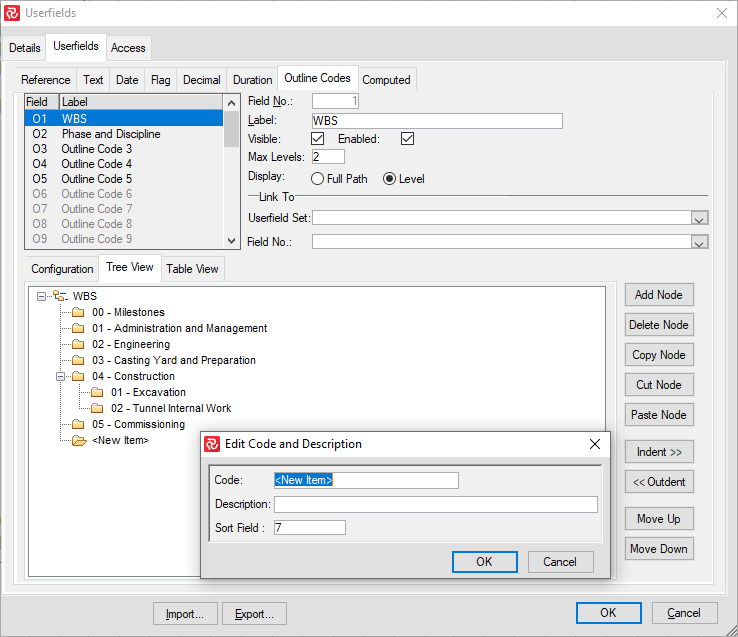
Press Add Node to add a new node. The new node will always appear as a sub-node of the node you have in focus. Each new node will have basic properties, i.e.:
Code = New Item / Description = 'blank' / Sort Field = Next available Number
Double-clicking a node opens an Edit window, allowing you to enter/edit your Code, Description, and Sort Field number values.
The Node manipulation functions are described in the table below:
| Function | Functional description |
|---|---|
| Add node | Adds a new node on the level below the node in focus. |
| Delete node | Deletes the node in focus. |
| Copy node | Copies the node in focus, which may be added under another node using 'Paste node.' |
| Cut node | Copies and remove a node after the node has been moved using 'Paste node.' |
| Paste node | Adds a copied node under an existing node. |
| Indent | Moves a node and its sub-nodes down one level in a structure. |
| Outdent | Moves a node and its sub-nodes up one level in a structure. |
| Move up | Moves a focused Node up one step. |
| Move down | Moves a focused Node down one step. |
Keep in mind that outline structures often become quite extensive. The Userfields window may be re-sized/expanded by 'pulling' the lower right portion of the window frame.
To simplify working with larger structures, several additional tools are available in the Tree View panel by right-clicking in the white/structure area, such as the Explode/Collapse functions.
The Indent/Outdent and Move Up/Down are also available from the context-sensitive short-cut menu.
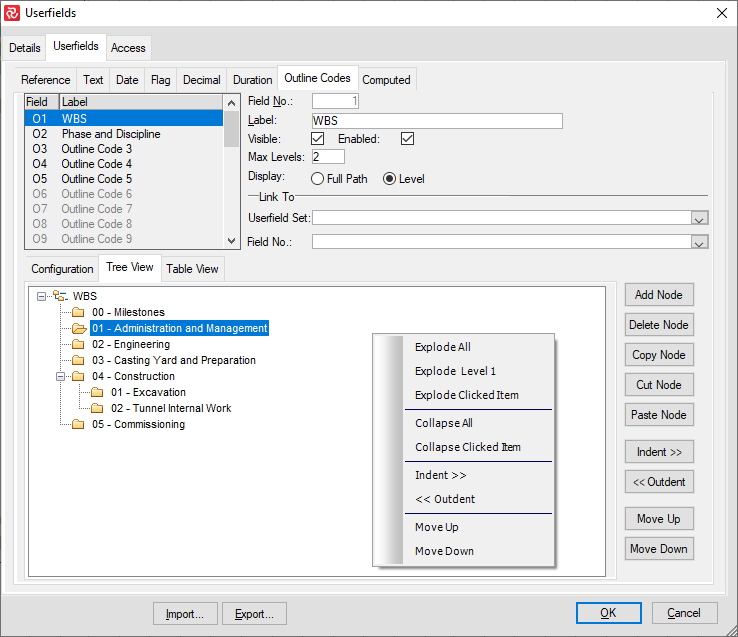
The Table View panel can simplify adding or editing your nodes' Short/Code and Description properties.
It can also be used to build your structure, as all the Add/Delete/Copy/Cut/Paste functions discussed earlier are also available in this panel.
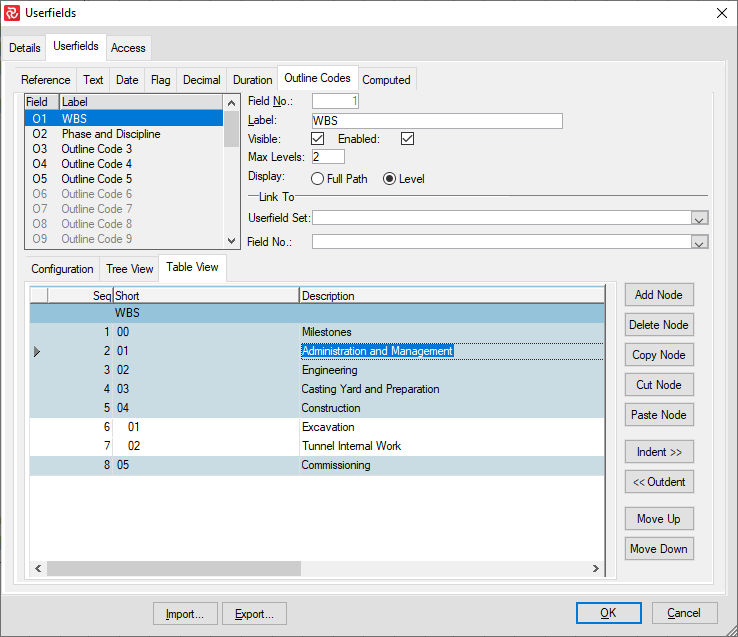
Safran also allows you to quickly Export/Import an Outline Code structure/values via a tab-separated text file if you need to share an Outline code with a user on another Safran database/installation.
Building a larger structure from scratch might be more efficient than building the basic structure, i.e., nodes/levels in Safran, and then exporting the code to a file. The file may then be opened by Excel and edited to include the proper codes and descriptions. After editing, save the file as a Text (Tab delimited) type file.
When you import nodes/codes/descriptions to an outline code, you can add/append new paths/nodes or replace the entire structure.
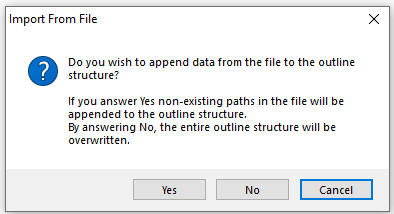
Generating an Outline Code from a set of Reference Fields
You may want to build an outline or a hierarchical structure from data already defined for two or more reference fields. For example, you may have reference fields for the project phase, discipline, and sub-phase. Now, you want to structure this into an outline. First, you define the new outline code. You open your Barchart Editor, group your Gantt according to the desired structure, add the new outline code to your columns, and select ‘Convert To Outline Structure’ from DATA > Userfields.
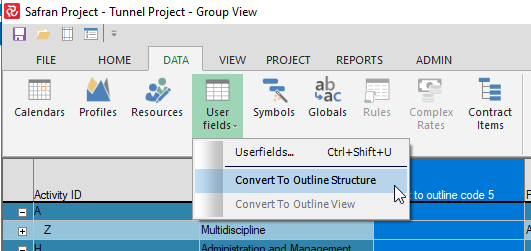
How to convert multiple reference fields to an Outline Structure
Define an outline code:
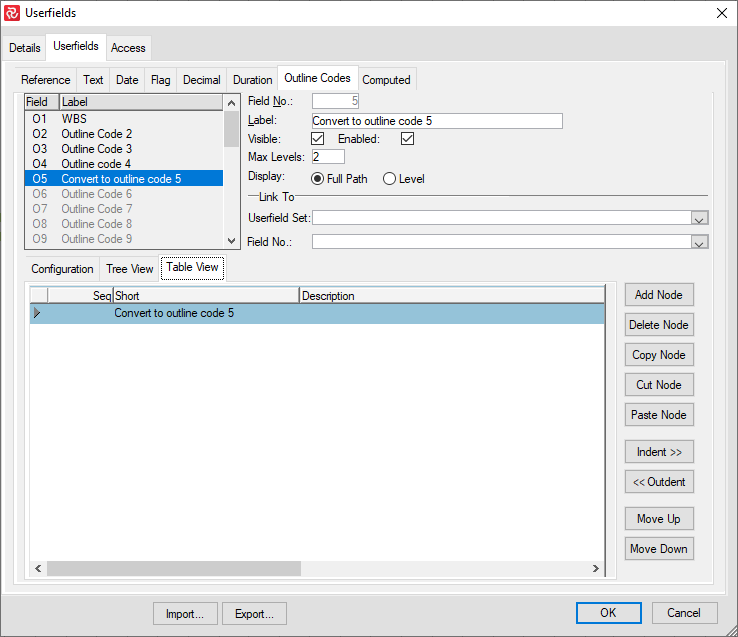
Open Group Properties and add the fields that you would like to convert to the outline code:
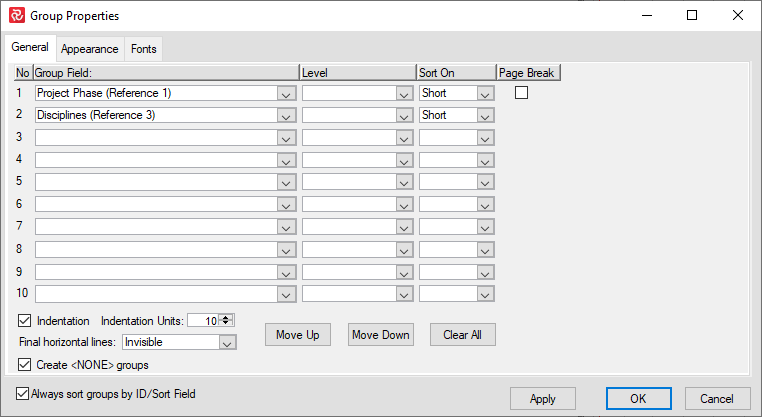
In the Barchart Editor, add the outline code column and click the header to hi-lite the column:
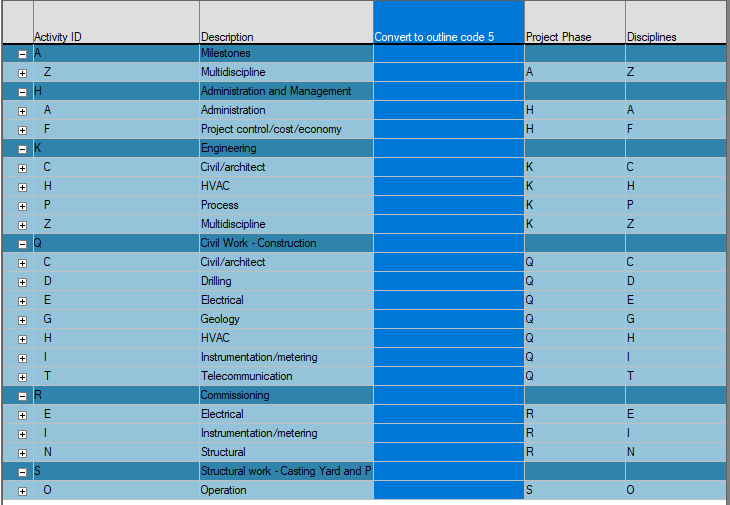
Click on the Convert to Outline Structure:

Click yes in answer to the following questions:
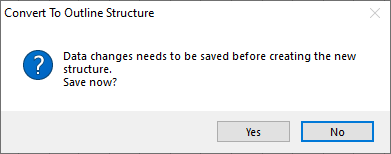
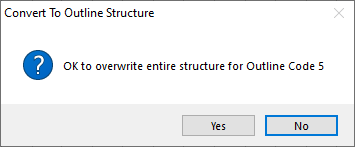
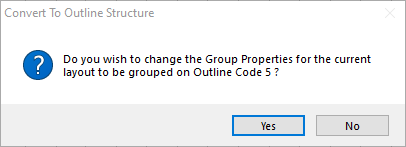
The result:

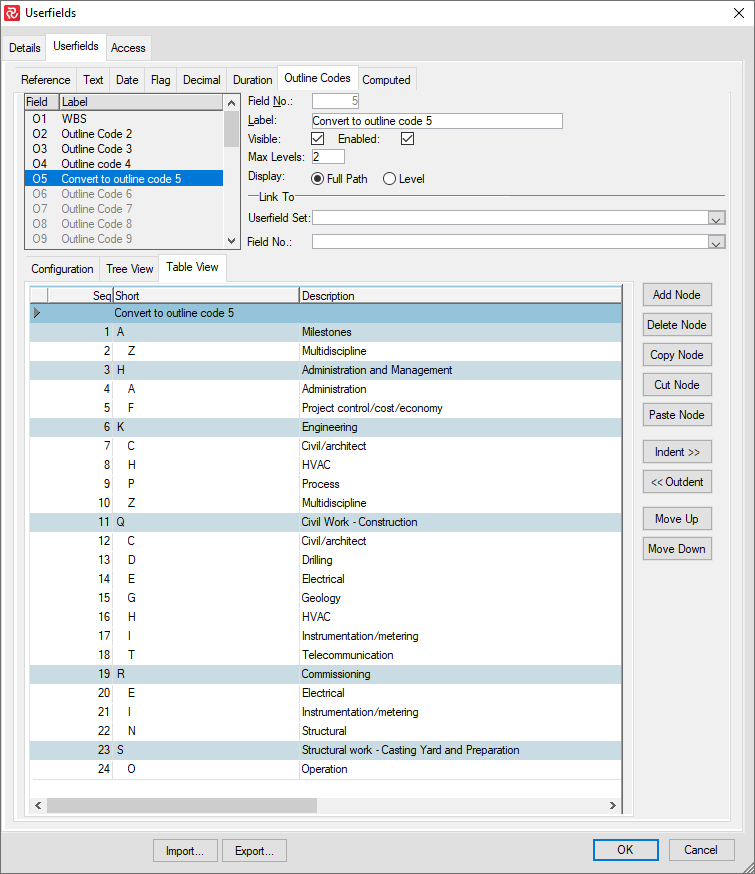
As the outline code levels can be used just as flexibly as individual reference fields for grouping and sorting data, converting reference fields into outline structures allows you to add new and other information into reference fields, using the outline codes where structures are in place.
Computed Fields
Computed Userfields are used to perform calculations. Unlike other userfields, you cannot manually enter data into a computed field.
When you set up a computed field, you first define its type. The field type will depend upon what output you want from your calculation. You can choose between Decimal, Date, Text, Flag, and Duration. Safran Project has 50 computed fields.
After defining a new computed field, you can click the "Formula"- button to set up your desired calculations.
Note: The computed value is not stored in the database. It is calculated in real-time when the Barchart Editor is open.
Example:
In the example below we would like to know how many percent points have been achieved since the previous status period.
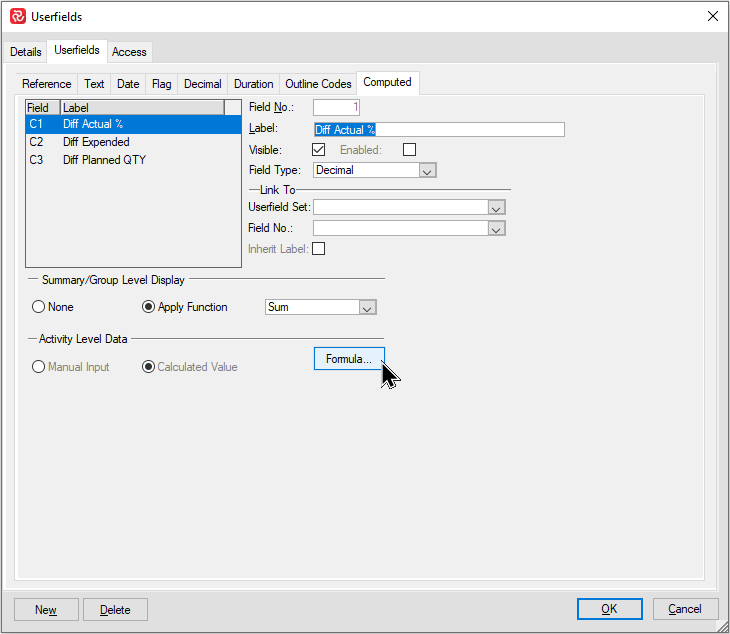
A Computed field ‘Diff Actual%’ of type Decimal has been defined and by pressing the Formula button we can create a Formula for the field.
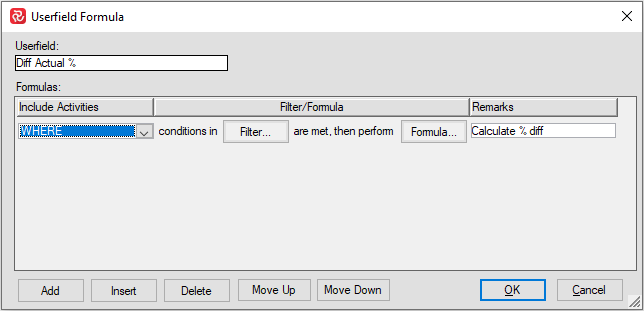
First a filter is defined in order to exclude activities without progress.

Then the calculation itself is defined where a field containing 'Last week's Actual %', which in this example is a regular user field, is subtracted from the current Actual %.
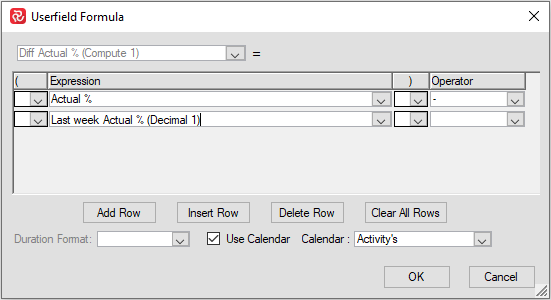
The computed field Diff Actual % now contains the last status period's progress percentage.
Formulas and Display options for User-Defined Fields
User fields are usually input/updated manually, however Safran Project also supports Calculated Values for Text, Date, Flag, Decimal, Duration and Computed type fields.
If you choose 'Calculated Value' for activity level data, you can add a Formula to calculate values. Formulas can also include filter expressions supporting multiple case/if-then-else type processing.
You can also choose whether or not to present values at the Summary/Group level and additionally specify what type of summary value will be presented. Functions at the summary level include Min., Max., Average, Sum, Count, First, Last, And, Or and Calculate. The various options as to what to present are relevant to the userfield type.
If a userfield has a Calculated Value assigned to it, you can also choose whether or not to save the value to the database. In general, if the field contains an ‘isolated’ or derived value it might not be necessary to save to the database, perhaps saving processing time. If the value is used by another application, it might need to be saved.
As an example you could create a Decimal field and add a formula to calculate the number of manhours behind/ahead of the baseline planned hours like this:
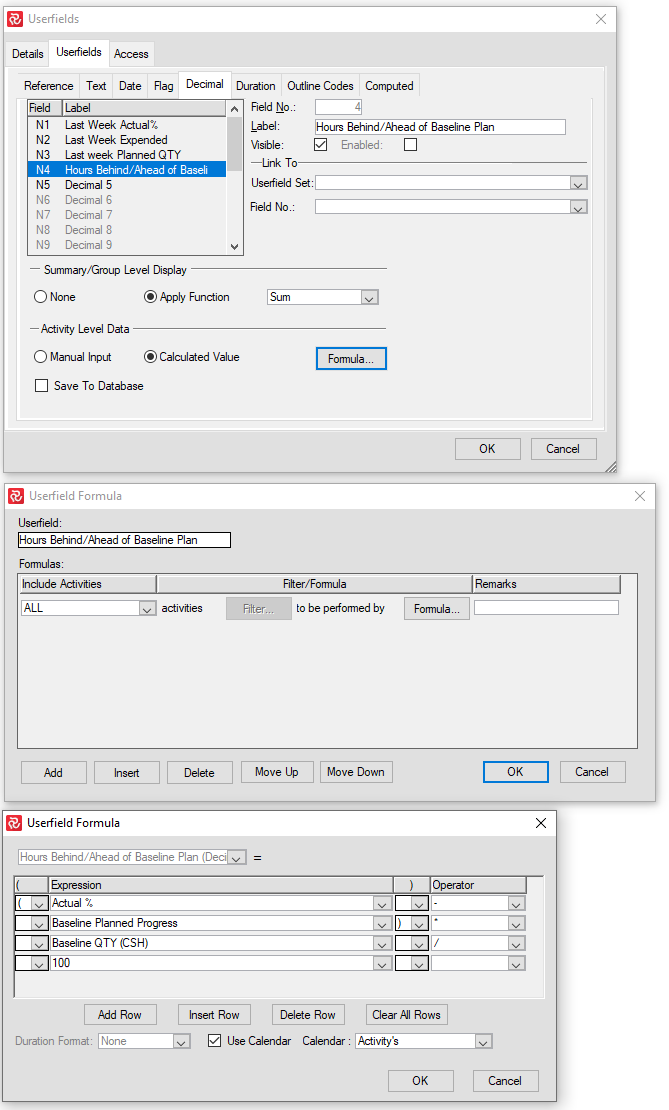
Together with Conditional Colors, you now can create a very effective Barchart Editor layout monitoring how many hours ahead or behind the Baseline Plan/Scope you are with 'traffic light' type high-lighting:
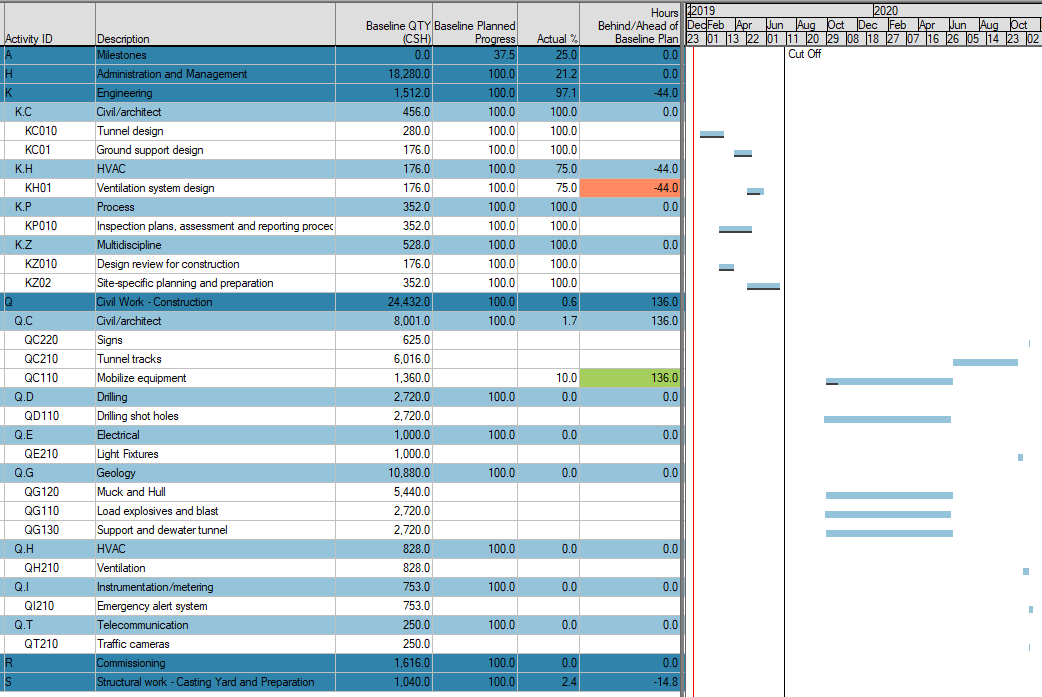
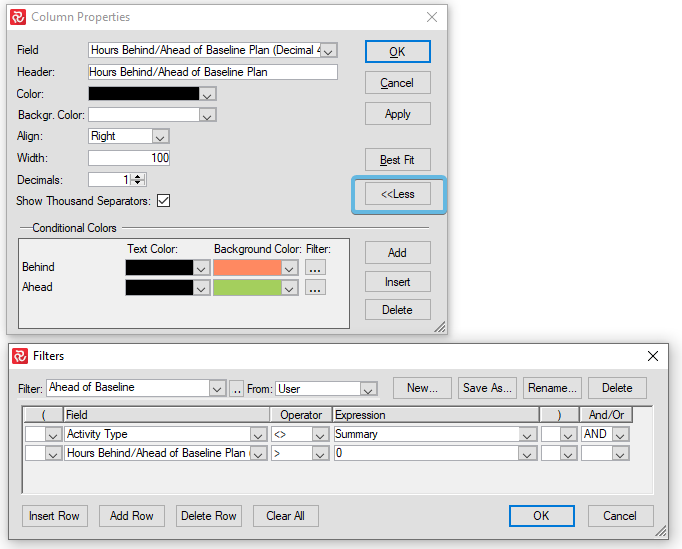
The Ahead of Baseline filter is applied to the green 'Ahead' conditional colorsymbol. A similar filter is applied to the red 'Behind' conditional color.
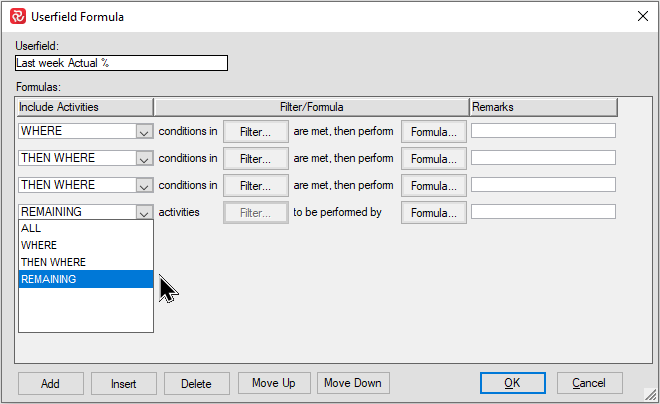
By adding multiple calculations with varying filters and formulas for a userfield, complex case-oriented or if-then-else type processing is possible.
If you have multiple projects in your database that want to make use of this kind of calculation, you can set up a Master computed userfield set and link your various userfields to the master:
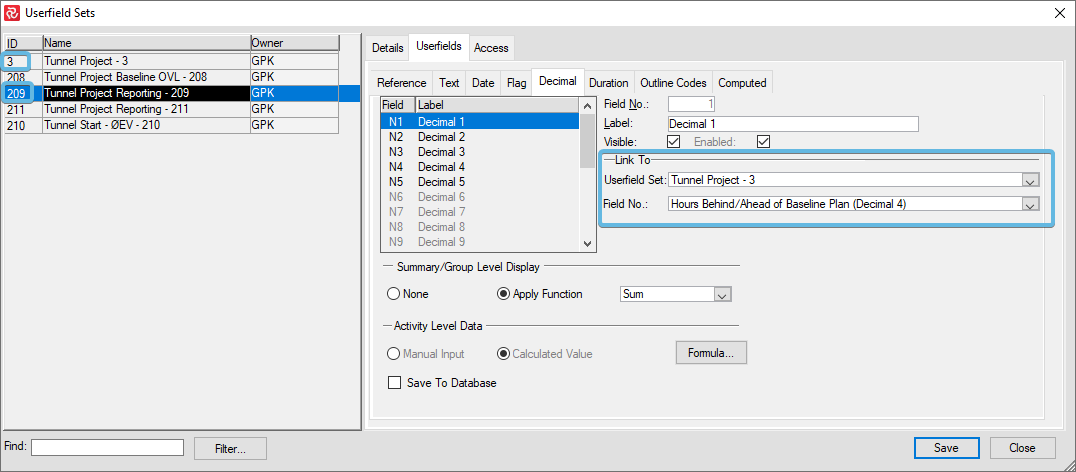
Manual input works well with Assign Fields and Assign Field Packages.
Advanced Userfield configuration options
The way a Userfield Set is set up and developed during the lifecycle of a project will often depend on size and complexity as well as the company/corporate environment.
In smaller, less complex stand-alone projects the userfield set starts from ‘scratch’ and grows organically field by field as the need for new userfields arise. In this case a userfield set is often a standalone configuration.
In larger, more mature project organizations, a large majority of userfields are already developed and defined over time on the basis of requirements of past projects. In this case re-use and standardization of information becomes more important which in turn requires more complex userfield configuration and handling functionality.
Safran has a powerful range of functionality to support the needs within this type of environment.
The various functions available are discussed below.
• Using an existing (complete) set of userfield definitions
Either when setting up your project the first time (Create New Project) or even shortly after you have created your project you can change the userfield set associated with your project. In the latter case this may be done by selecting Properties on the Project tab. Keep in mind that by doing this it might have unwanted side effects if you already have defined userfields and added activities making use of any userfields.
• Using specific userfield definitions from another userfield set/Mapping Userfields
In some cases, only certain userfield definitions are required from other userfield sets.
You can easily do this using the ‘Link To’ function that is available for all userfield types (apart from Reference fields that have their own 'link' functionality) that you'll find in the 'Link To' portion of the Userfields definition panel.
Start by selecting the relevant Userfield set and then field type and Field (No) you want to define/configure. Make sure Visible and Enable are checked. Then select the Userfield Set and Field No. you want to link to. Note that if you are configuring Field No. 1 in your target userfield set you can select any Field No. from the source userfield set. ie. Target Field 1 can be linked to source field 1-100.
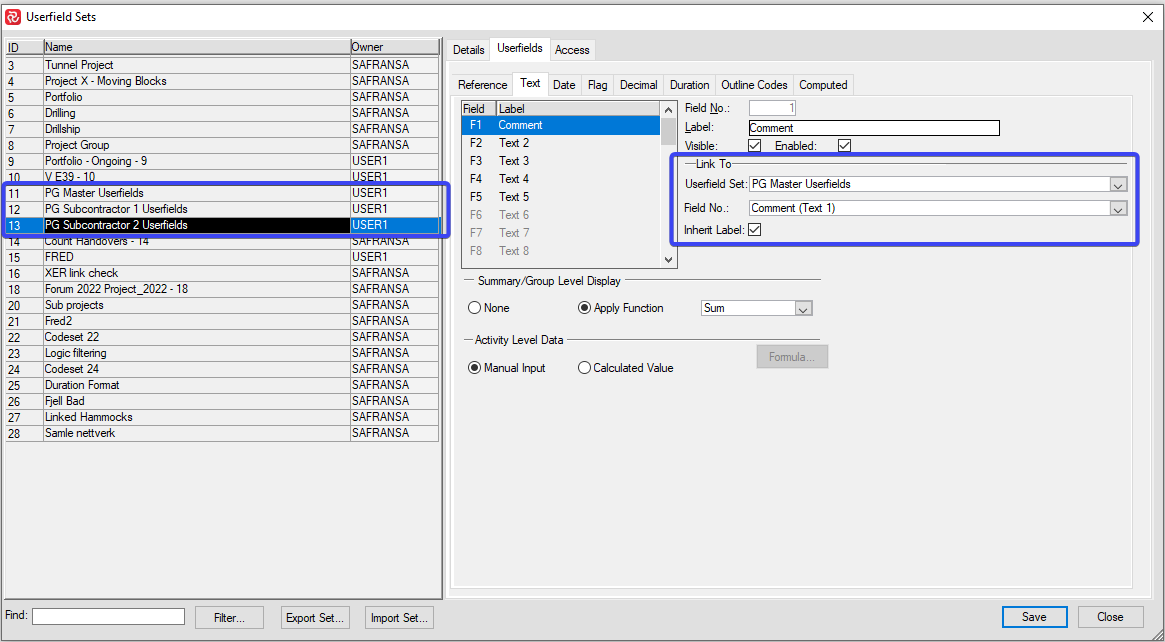
In the above example the Text field F1 in the 'PG Subcontractor 2 Userfields' (ID 13) set is linked to the Text field 1 in the 'PG Master Userfields' (ID 11) set.
If you check the ‘Inherit Label’ checkbox the Label from the field you link to will be used as the Label for your field.
Linking to an external field definition will also inherit/utilize any Summary/Group Level Display, Activity Level Data and Save To Database properties from the source definition.
Reference fields also have linking capabilities, however these are more extensive and may be accessed by pressing the SQL button when working with Reference fields.
Start by selecting the reference field you want to define/configure. Make sure that the Visible and Enabled boxes are checked. When the ‘Table Select’ window opens, start by selecting the relevant Userfield set from ‘Userfields From’ dropdown, then select the relevant reference field you intend to link to/inherit codes from.
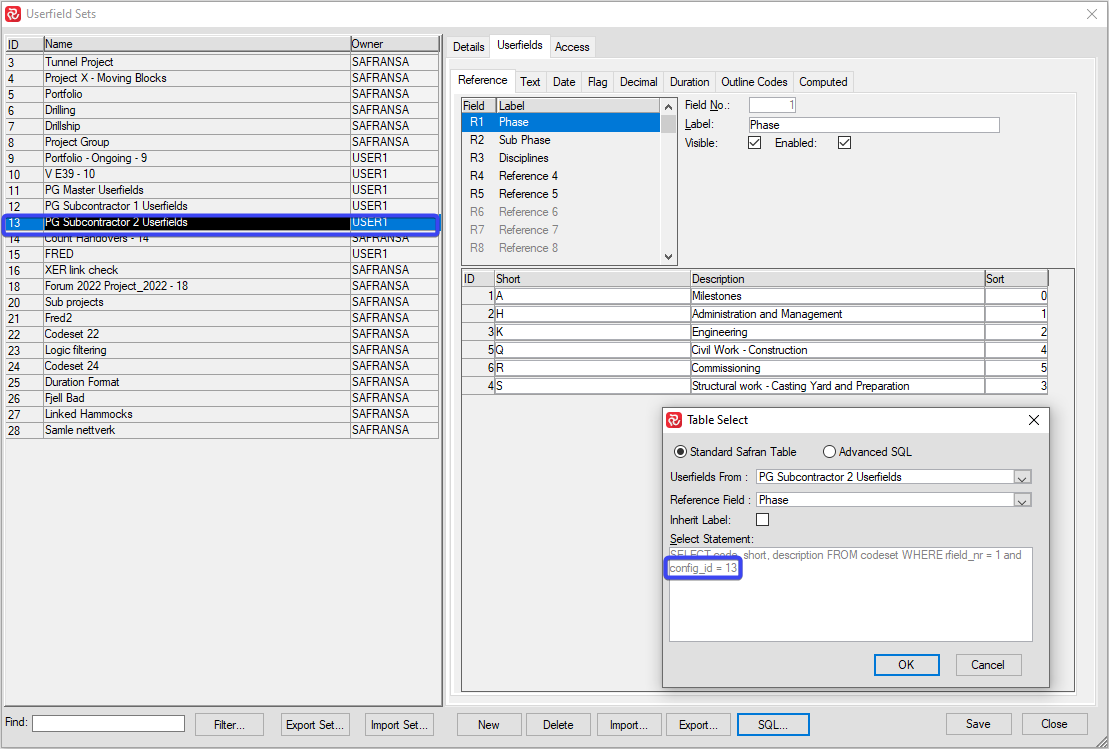
In the example above, the default linking is shown. Reference field R1 named 'Phase', uses values found for 'rfield_nr 1 in from the 'PG Subcontractor 2 Userfields' set config_ID=13.
In this example note that the Reference Field Values are black and may be added, deleted or edited.
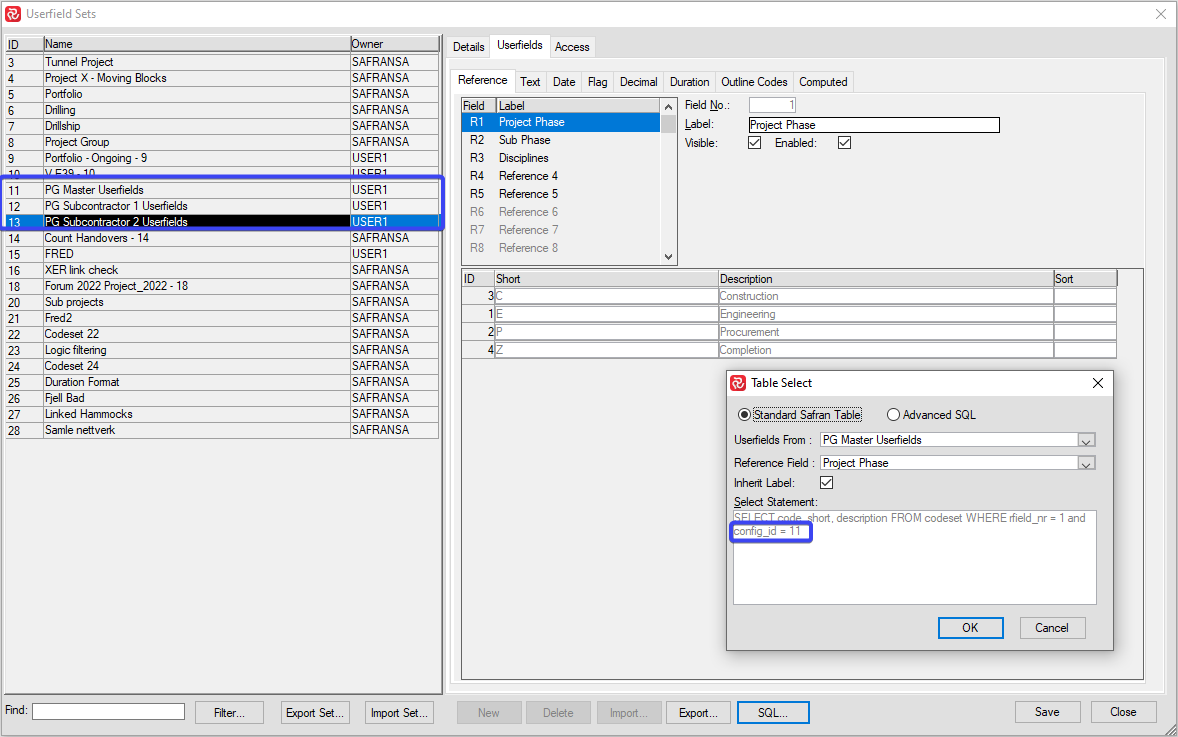
In the configuration example above where the reference field R1 is linked to another Userfield set, note that the SQL Select Statement selects values from the 'PG Master Userfields' set ID 11. It also inherits its Label 'Project Phase' from the linked Userfield set.
Note also that when you link to a reference field in another userfield set the reference field values, New, Delete, and Import buttons are grey/disabled. Ie. when linking to an 'external' reference field you will not be allowed to modify its contents.

• Advanced SQL/Modifying the Reference field Select Statement
It is not uncommon for larger organizations to store code libraries in a data repository. To save repetitive data entry and duplicating information, Safran Project allows you to assign your code values from tables other than the default code sets in the Safran data structure. To use this feature, you should have proper knowledge of the Safran Project database structure and be familiar with SQL.
Using this functionality can also assist in standardizing Reference fields across multiple projects and simplifies maintaining code set content.
In addition to being able to link to and use all values from a Reference field, Safran allows you to modify the SQL ’Select Statement’ and add additional arguments to limit the list of available Reference field values.
By selecting the ‘Advanced SQL’ button, you’ll notice that the Select statement box content is no longer grey allowing you to edit the SQL Select Statement.
In the examples below a few of the various capabilities provided by modifying the Select Statement are discussed.
In the example below, we have a reference field containing a list of disciplines where some of the codes are considered 'legacy' values and are no longer valid. All the time the userfield set is in use for a multitude of completed projects, we are not able to delete the non-longer valid codes, we could however modify the Select Statement to exclude these values from further/future use.
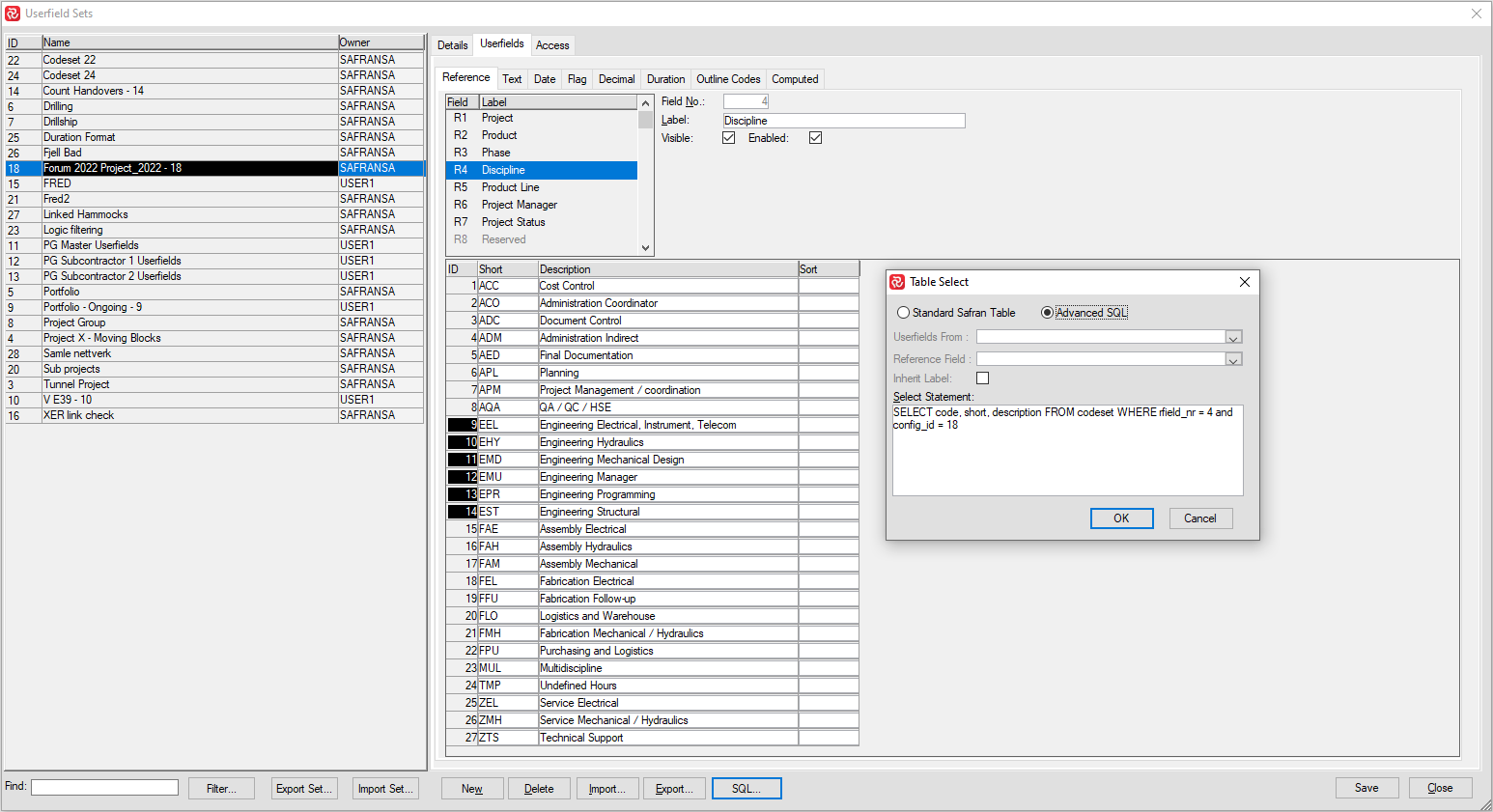
Standard SQL Select Statement showing complete content.
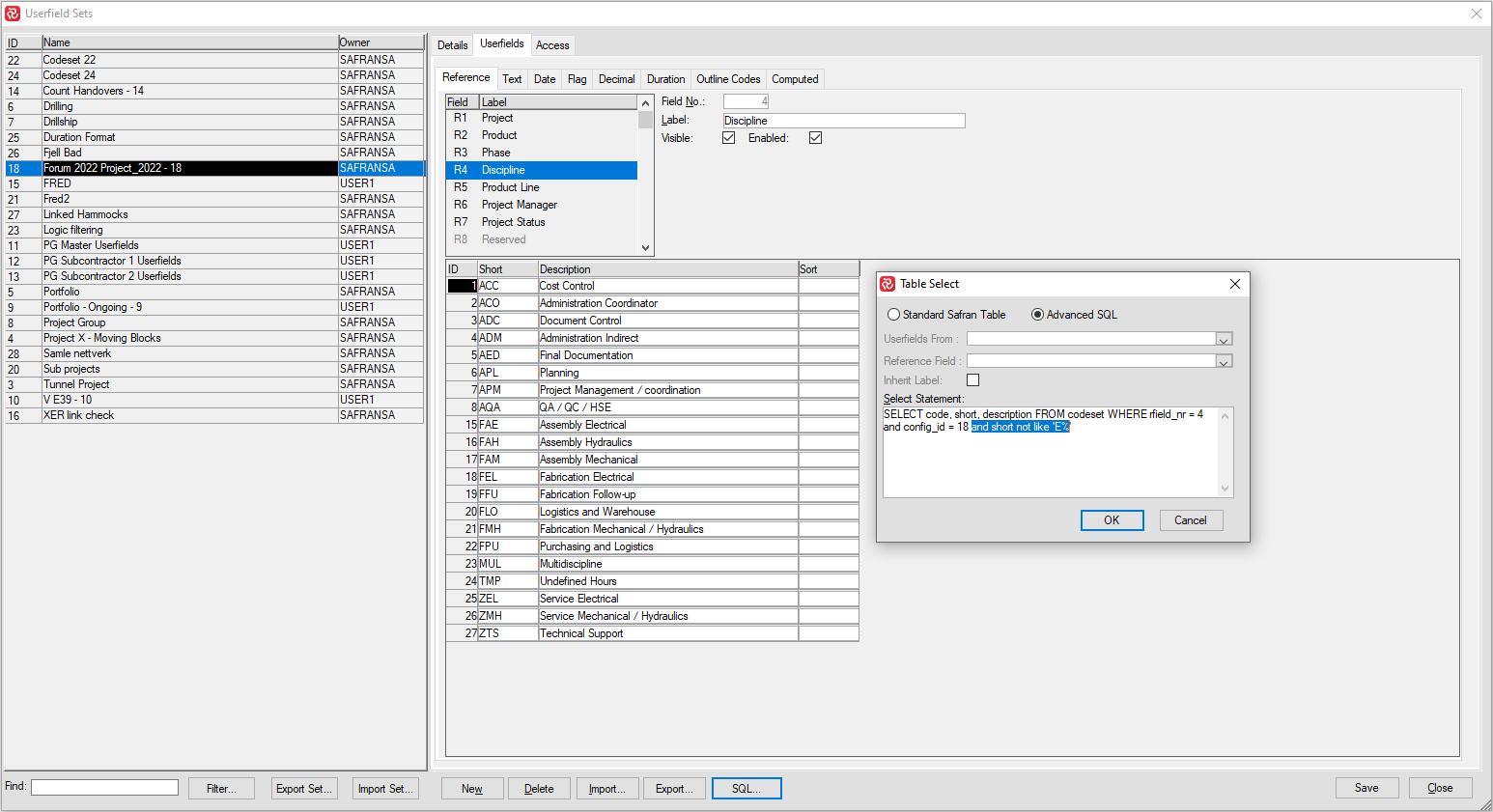
Modified SQL Select Statement showing reduced/filtered content. Notice that codes beginning with 'E' are no longer present.
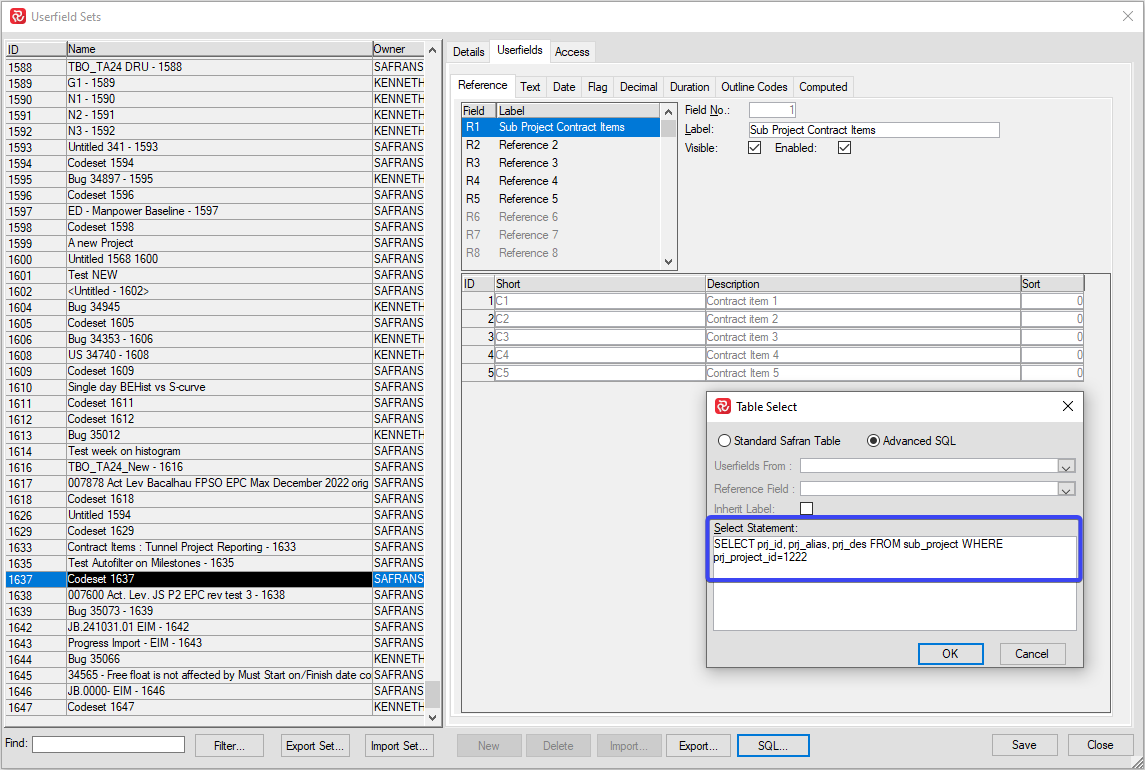
SQL Select Statement showing lookup from another Safran Database Table. In this case the reference field is populated from values found in another table in the Safran Database containing Contract Items from a specific Sub Project.
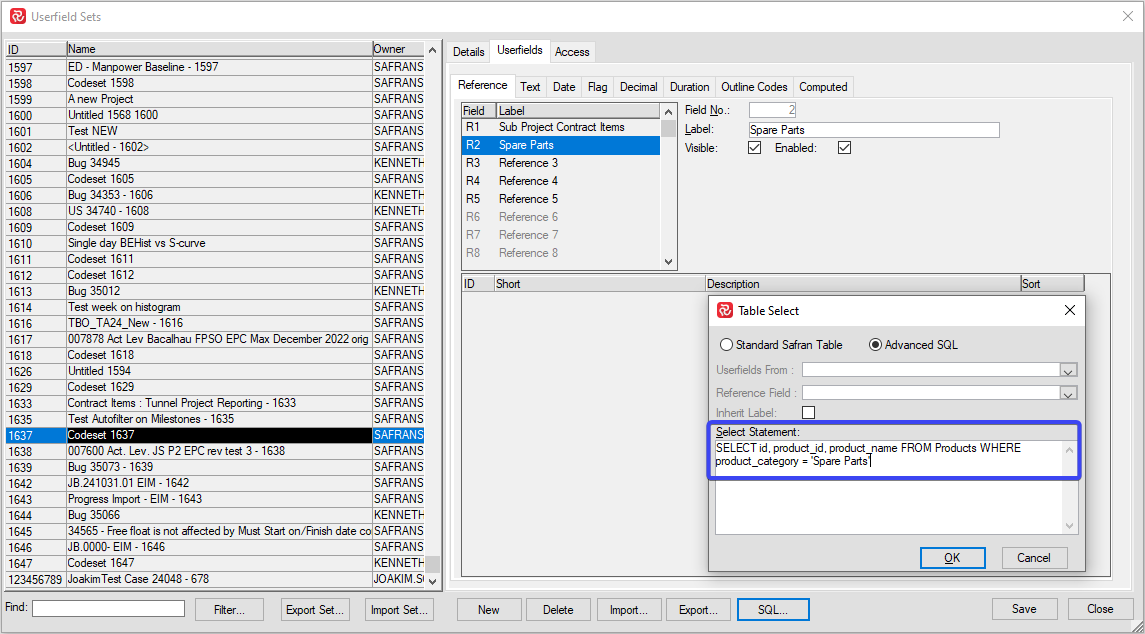
SQL Select Statement showing content from non-Safran table in another database. In this case an 'imaginary' Product database selecting Products defined as 'Spare Parts'.
• Copying Userfield set definitions
Safran allows you to copy a complete set of Userfield definitions. You’ll find it on the Admin ribbon under Userfield Sets.

Once the Userfield sets window opens, select the Userfield set you would like to copy, then right click and choose Copy.
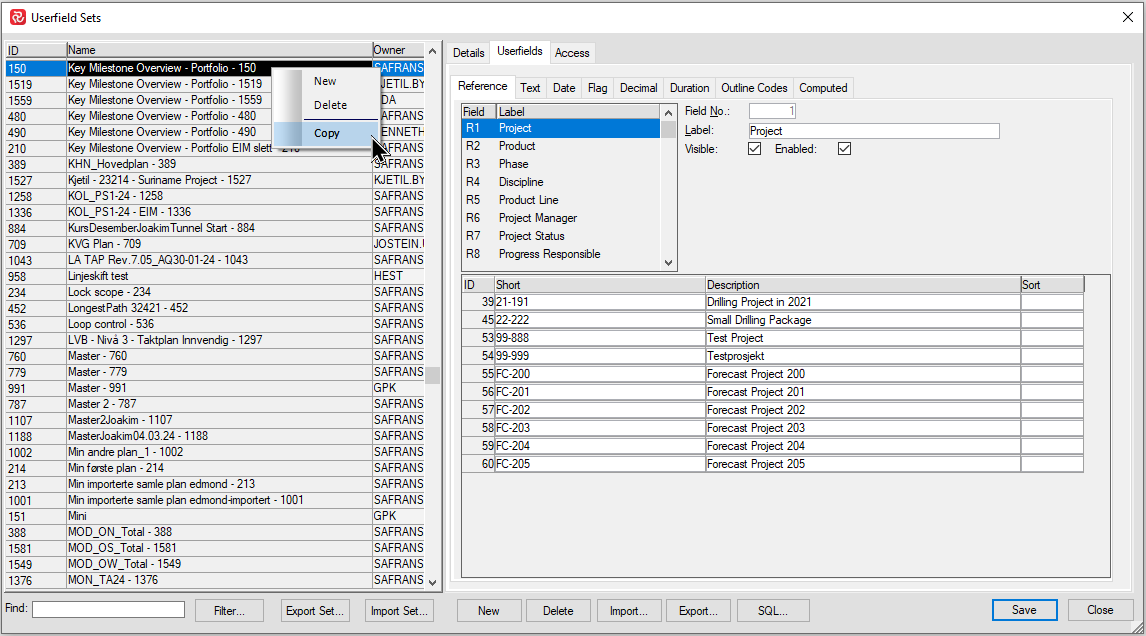
You will then be given three different options as to how and what to copy:
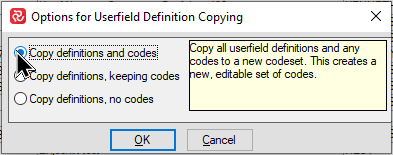
Copy definitions and codes – This will copy the complete set of userfield definitions and all codes (ie Reference field codes as well as Outline code values) to a new separate userfield set where all codes will be editable.
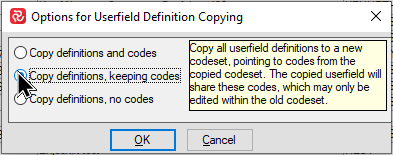
Copy definitions keeping codes - This will copy the complete set of userfield definitions. Reference and Outline type fields will be linked to the relevant fields in the original userfield set. The code values may only edited in the original userfield set.
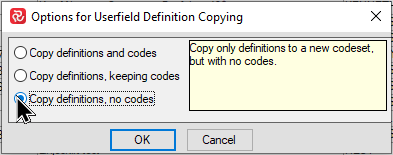
Copy definitions no codes - This will copy the complete set of userfield definitions, however none of the Reference and Outline field code values will be copied/populated.
After making your choice and pressing Ok, you'll return to the Userfield Sets panel. If you select the Details sub-panel, you'll notice that the new/copied Userfield set has been given the Name <Copy of ..> which you may re-name to suit your needs

• Export/Import Userfield set
You can copy the whole content (both field definitions and codes) of a Userfield set to file by using the Export function found at the bottom of the Userfield sets window. The file may then be imported to a database. This may be useful as either a back-up or a way to transfer a userfield set to another database.
When you import a Userfield set from file, it will be saved using the same name name as the original. If the Userfield set name already exists it will be given a post-fix '_1'.
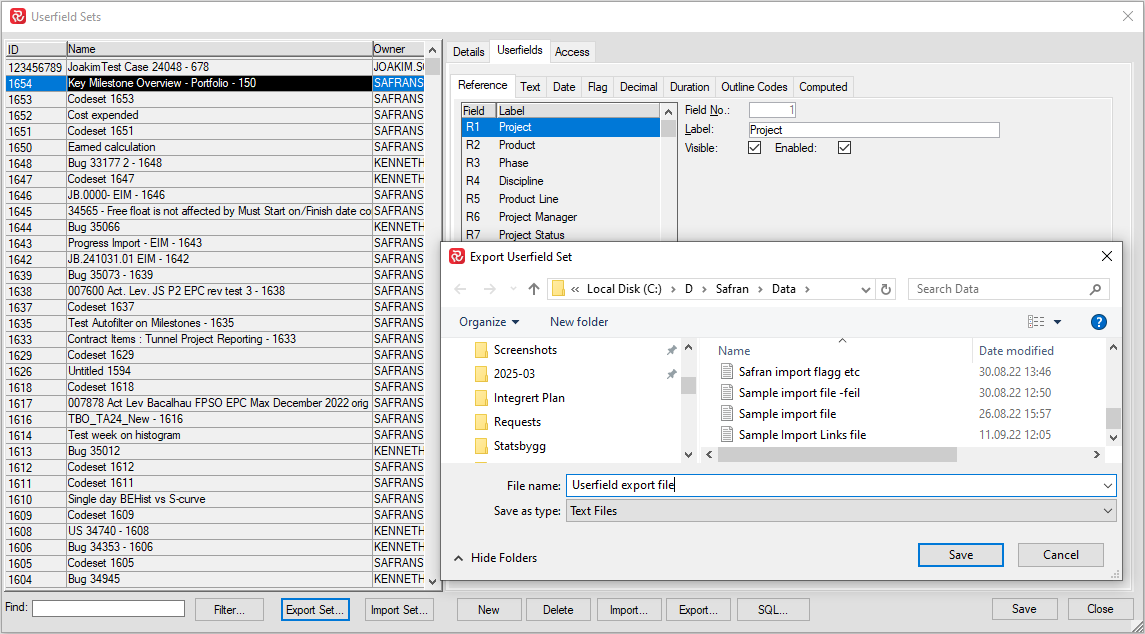
• Export/Import Reference field and Outline code values (codes & descriptions)
You can copy the contents (codes, description, sort field) of a Reference field or Outline code to file by using the Export function found at the bottom of the Userfield sets and Userfields window. This may be useful when transferring a Reference/Outline code field between projects.
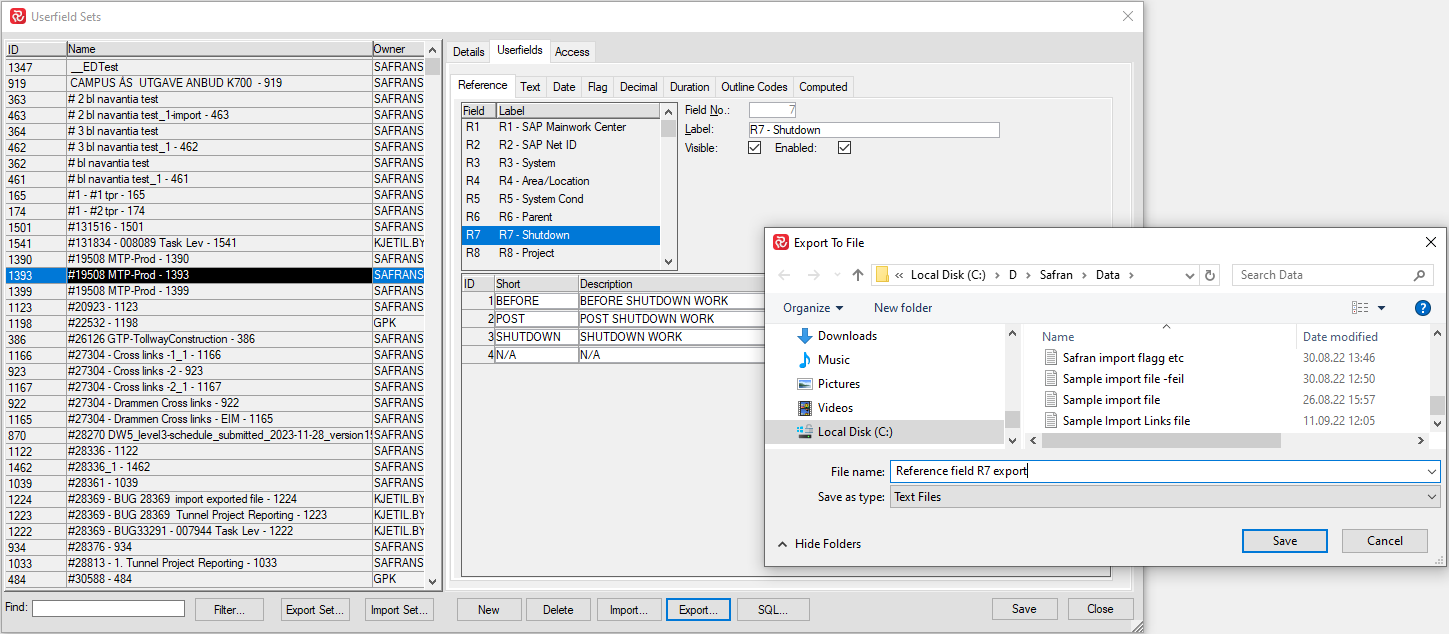
Symbols
User-defined symbol sets allow you to customize the barchart view for presentation and analysis. The symbol sets hold your plan's defined symbol styles and annotations. You can configure the activity bar's size, appearance, format, color, position, and other characteristics. Show one or more bars for each activity. Include conditional symbols for groups of activities or single activity annotation. You can use the symbols to define a standard set of bars for your project and then choose the bars, symbols, and text annotation you want to show. Symbol styles are saved as part of your barchart layout.
Symbols can highlight details or show different parts of the schedule; for example, a baseline bar, a current bar, a progress bar, or symbols with bars spanning user-defined dates.
You can define an infinite number of symbols in your symbol set
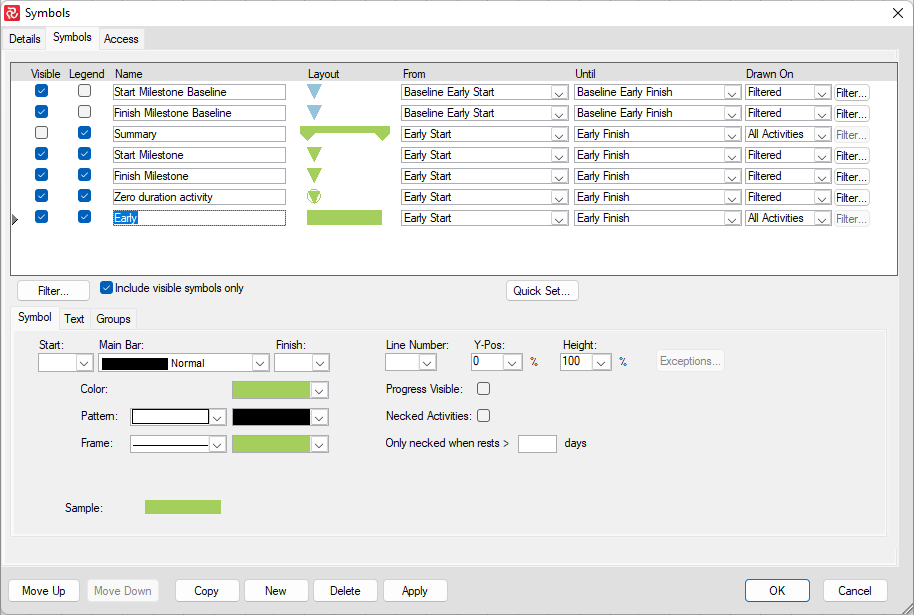
In the following chapters, you will learn how to set up a symbol set and how to create/modify bars within a symbol set.
Symbol Definitions and Layouts
Symbols are used and displayed as part of the Barchart Editor layouts. Layouts utilize the Symbol set and store and hold the list of symbols selected as visible. You will most likely create different layouts with different perspectives to visualize your project schedule for various stakeholders and reporting as well as layouts for day to day planning work.
The use of symbols are layout-specific as each layout contains a definition of which symbols are to be presented. This flexibility, combined with the capability of unnumbered layouts and symbols, is an excellent advantage when reporting.
Please study the Barchart Editor section for full details on Creating Layouts and working with the Barchart Editor.
The Safran Project Default Symbol Set
The default Symbol Set offers a wide range of existing symbols but also allows you to create an unlimited number of your own specific symbols.
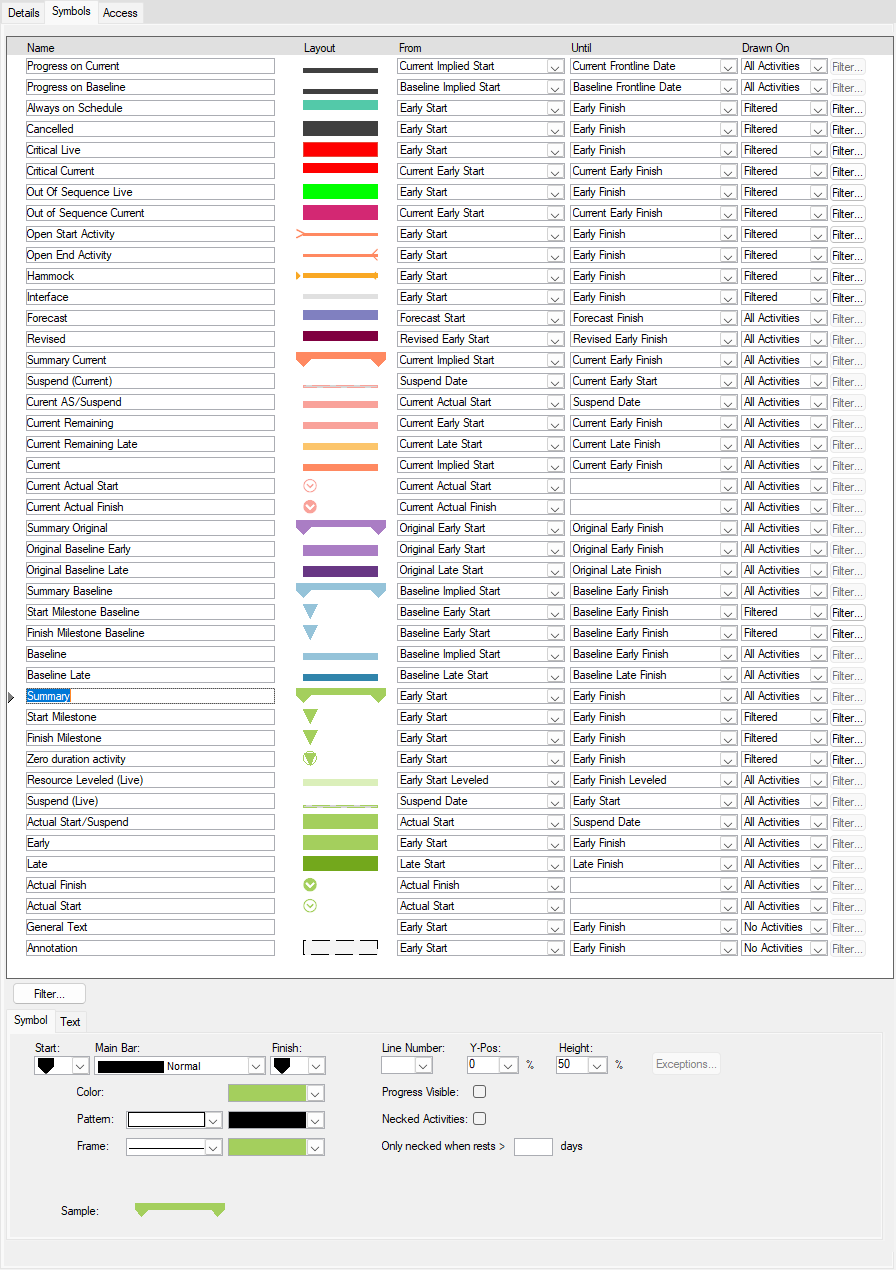
The Symbol Set
Defining a new Symbol Set
A project symbol set often selected/set upon using the project setup wizard, however, a symbol set may be defined and/or modified at any time.
To define a new symbol set without using the wizard, go to the ADMIN ribbon and choose 'Symbol Set.'

Right-click and choose 'New' or 'Copy'.
You can copy (and then modify) one of the existing symbol sets in the database or create a new one.
If you choose 'New,' the new symbol set will contain all the Safran Project Default Symbol Set symbols. Your new symbol set may be used as is or modified to suit your needs.
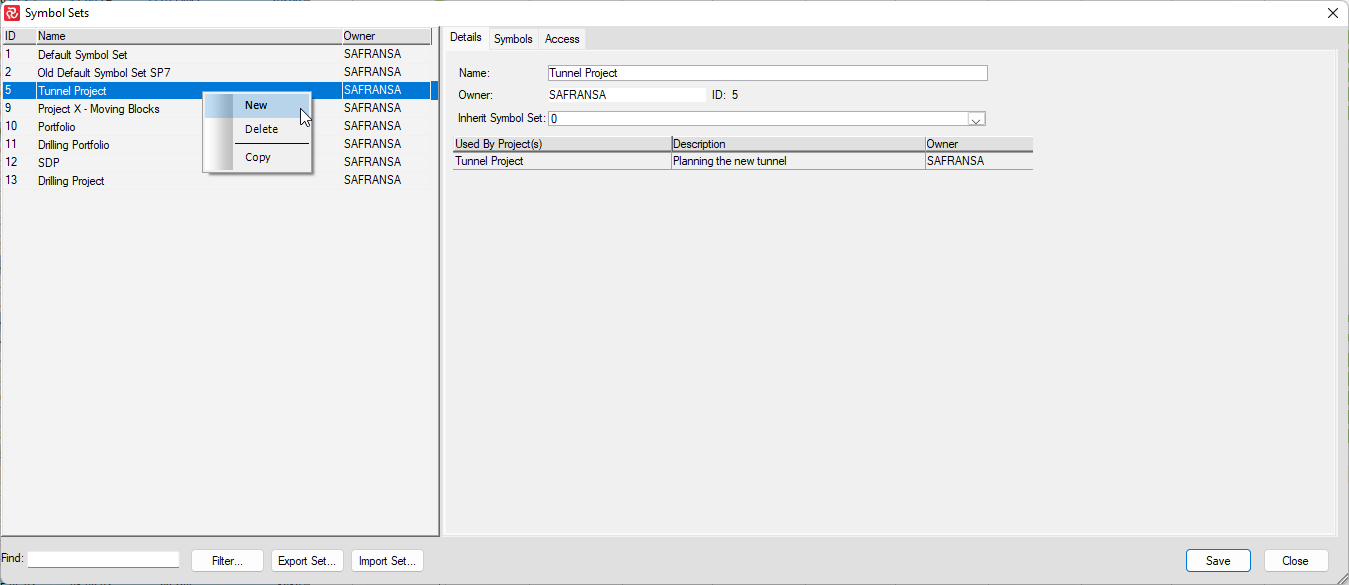
You can also both export and import a symbol set to/from a file.
When working on a project, the project will already have a symbol set defined. Go to the PROJECT ribbon and choose 'Properties' to view the name of the Project's symbol set:
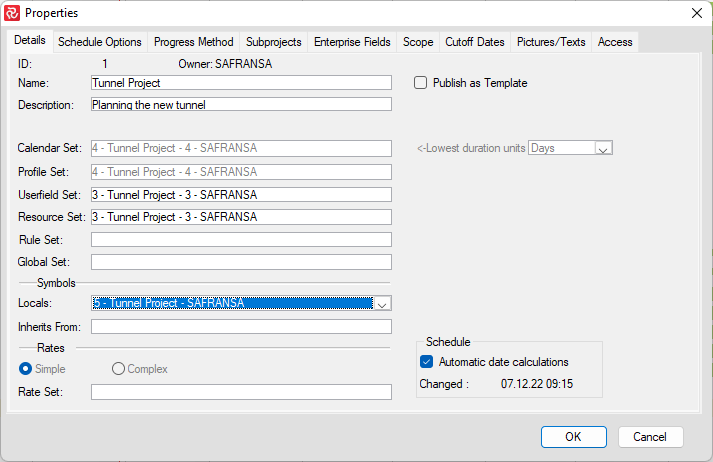
Note: A layout will by default use the Project's Symbol Set, however you can override this for a specific layout from the Layouts window by selecting an alternative Symbol set from the Use Symbol Set dropdown as shown below:
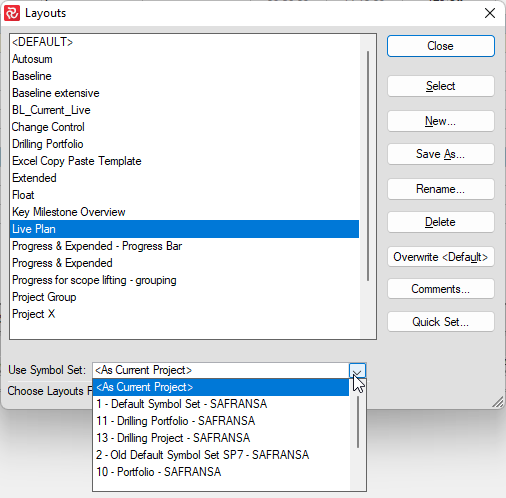
See the chapter on Layouts for more information on using symbols in layouts.
Opening the symbol set
Choose Symbols in the DATA ribbon to view the defined symbols, edit existing symbols, create new symbols, or remove/delete a symbol.
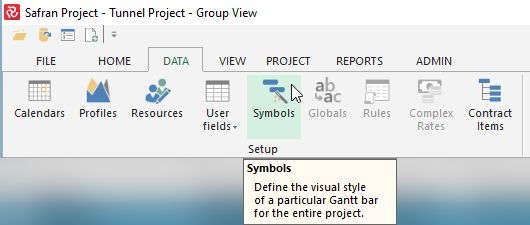
You can also use the quick access shortcut (right-click in the barchart).

Include visible symbols only.
Symbols set often contain a large number of symbols. By checking the Include visible symbols only allows you to reduce the number of symbols you see when opening the symbol set.
This option will show only those symbols ticked 'Visible' or 'Legend.'
Ticking/Unticking this flag will only affect your user/session.
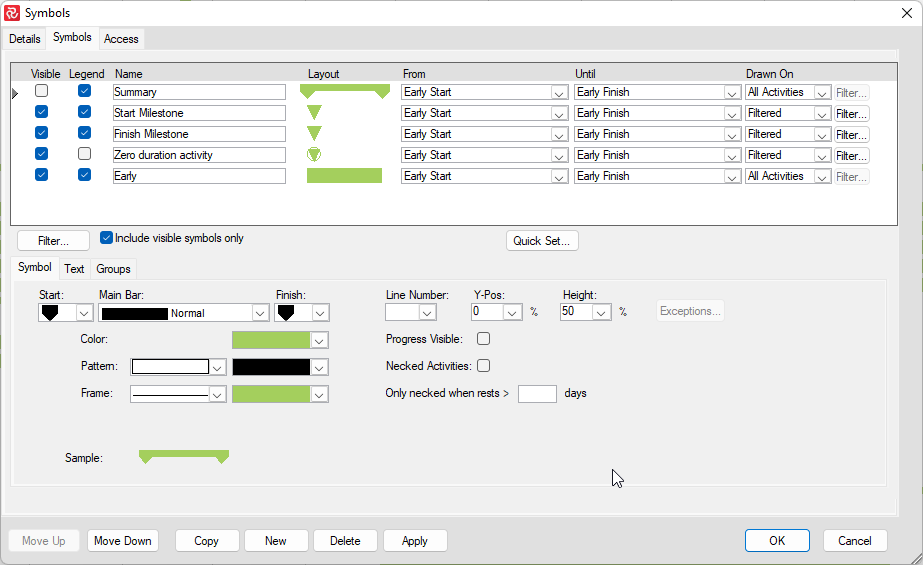
'Visible' means that the symbols will be visible in the barchart.
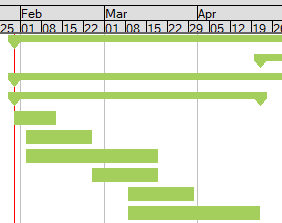
'Legend' means that the symbol will be visible in the legend area at the bottom of the Barchart area.

When printing/saving to PDF, you'll also find various legend options in 'Page Setup/Legend'.

Moving symbols up/down
The order in which symbols are listed in the symbol set plays an essential part in how the symbols are displayed in the barchart. For each activity line Safran will start at the bottom of the symbol set and draw/place each visible symbol. If one or more symbols overlap in 'time' (ie. have the same start/end dates), it is the symbol at the top of the list that will be shown as it will potentially cover any symbol further down the list.
Notice how the blue Baseline bar shows on top of the green Early bar due to being on top of the list instead of at the bottom.
IMPORTANT: If you change the order of symbols in the symbol set, you will change the order for all users.
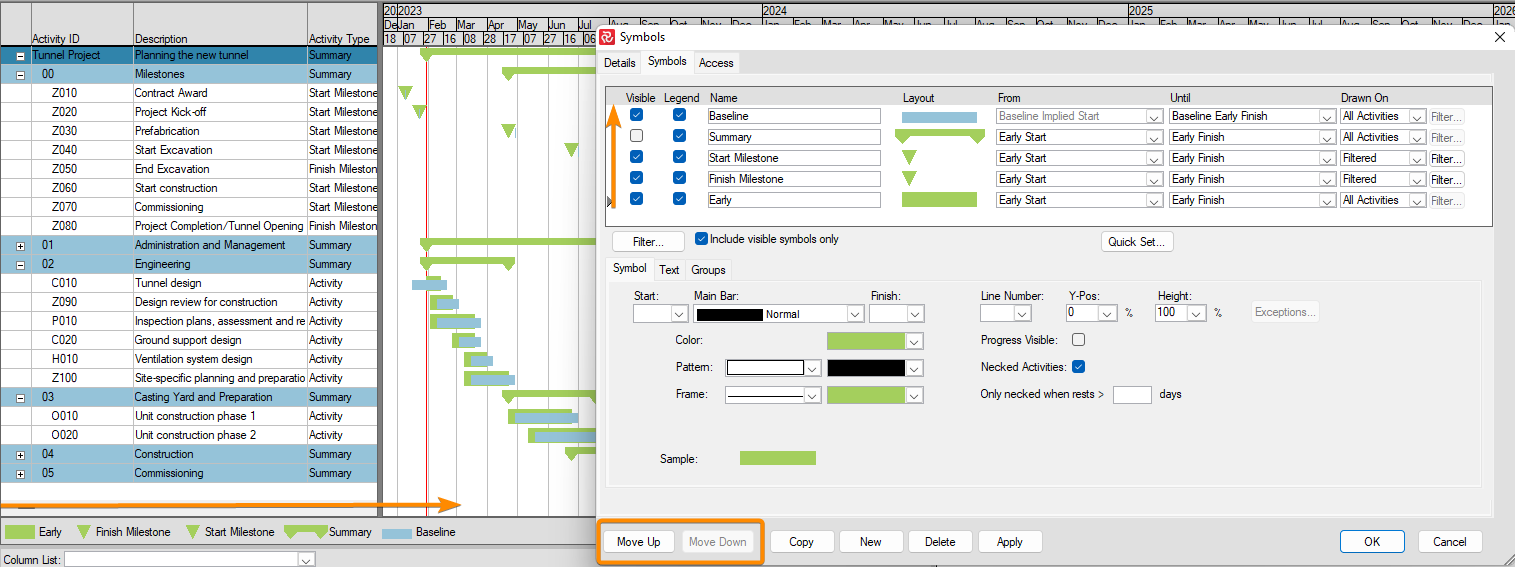
Before potentially moving symbols up/down, it is good idea to ensure that you have not ticked the 'Include visible symbols only' or have added a filter (ref. below)
Limiting the number of symbols in the window
Click on the 'Filter' button to limit the number of symbols.
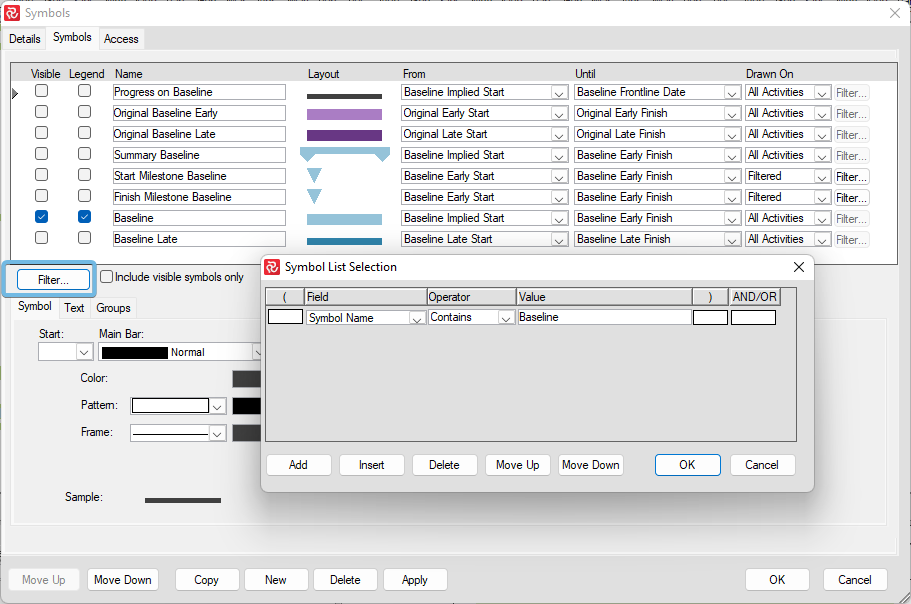
You can filter on Symbol Name, Start/End date and on which group of activity a symbol is Drawn on.
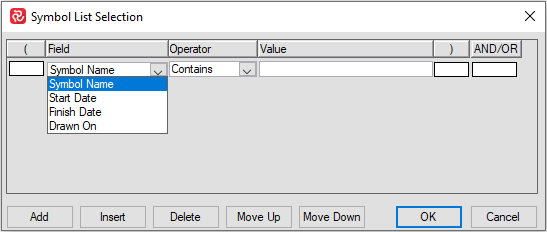

Keep in mind that this filter is associated to your User and will be applied until it is removed. It will also be valid/applied when opening/working with other projects.
Adding a Symbols filter will not have an effect on other users.
The symbol bars
Adding a New Symbol
Click 'New'. A new "untitled" symbol will be added to your symbol list. Rename the symbol and use the panels to configure symbol attributes.

Deleting a Symbol
To remove a symbol from your symbol set, highlight the symbol and click 'Delete.' Safran Project prompts you to confirm the deletion of the symbol style.
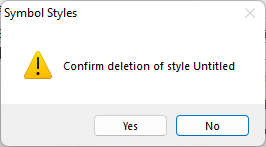
The Activity Bar Record
You can set up your barchart to display as many bars as are needed. Each bar shown for an activity/milestone must have a record defining its span. You select the span dates from the start and finish drop-downs.
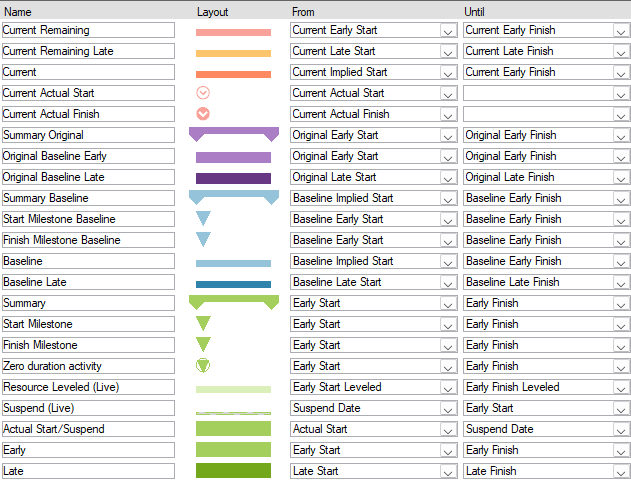
The start field holds the name of the field providing the start date for the graphical bar feature, and the finish field contains the name of the finish date field for the graphic bar feature.
Conditional Bars
By specifying a filter, the bar can be shown for all activities (default), no activities, or a group of selected activities. To do so, mark the Filtered Activities button and choose Filter from the shortcut or edit menu.
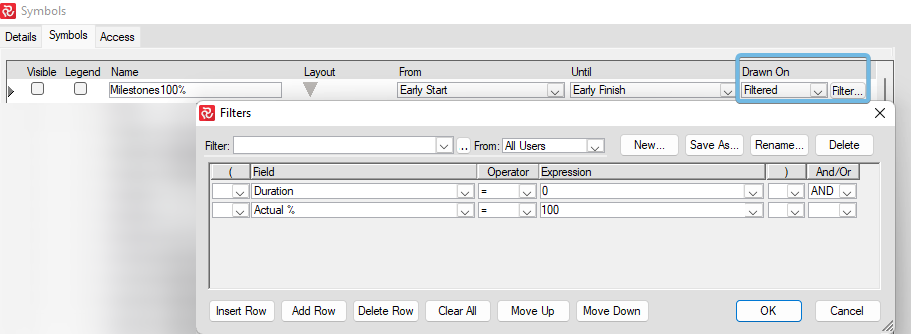
This option allows you to define conditional bars and symbols. The condition may, for example, be based on float or criticality, selected parts of your project or work breakdown structure, and many more.
Symbol Bar configuration overview
Symbol properties are grouped on three tabs: Symbol, Text, and Groups.
The Symbol tab contains basic symbol properties.

The Text tab contains additional text properties.

The Group tab governs which level a symbol is presented for and how it is presented.

Choosing Symbols and Colors
An activity symbol has three parts: a start symbol, the activity body or the main bar, and the finish symbol. Select the Symbols tab to choose from the list of industry-standard symbols or change colors.
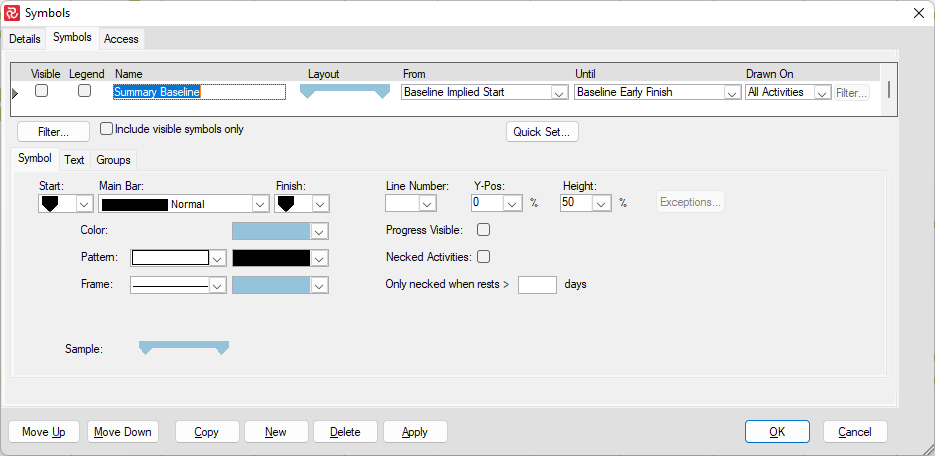
The start and finish symbols can be selected from a wide range of 190 graphical shapes.

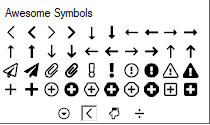
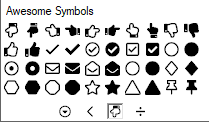
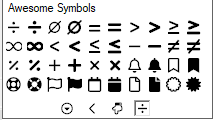
The main bar may be configured by selecting from 5 bar styles: 97 colors, eight patterns, 97 pattern colors, and 97 frame colors. The bar can be specified with pattern, frame, and style.
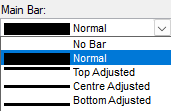
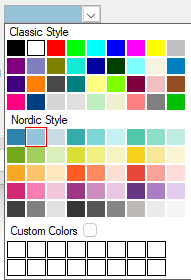
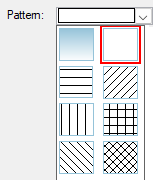
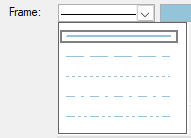
Choose Line Number
A symbol may be positioned relative to the activity row by selecting a line number. Valid positions are 2, 1, 0, -1, - 2.

Specify Bar Position
You can specify the symbol and bar offset by entering values in the Y-position and height fields. The Y-position is relative to the activity line counted from the top-of-line.





Necked Activity Bar
Mark the Neck check box to show rest and non-work time as a neck in the bar. Rest and non-work time include holidays and weekends.


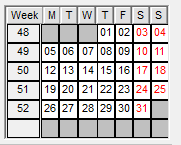
To restrict necking, you may enter a minimum number of non-working days before Safran draws a neck.

Showing Text/Data on Bars
The text attribute allows you to add free text or include data items to be displayed with the activity bar for reference or information. The text label has three parts: a leading 'free' text, Activity fields, and a trailing 'free' text. Enter your text or select a field from the drop-down, then specify the appearance by choosing color, character size, and font attributes Bold, Italic, or Underline for the text field.
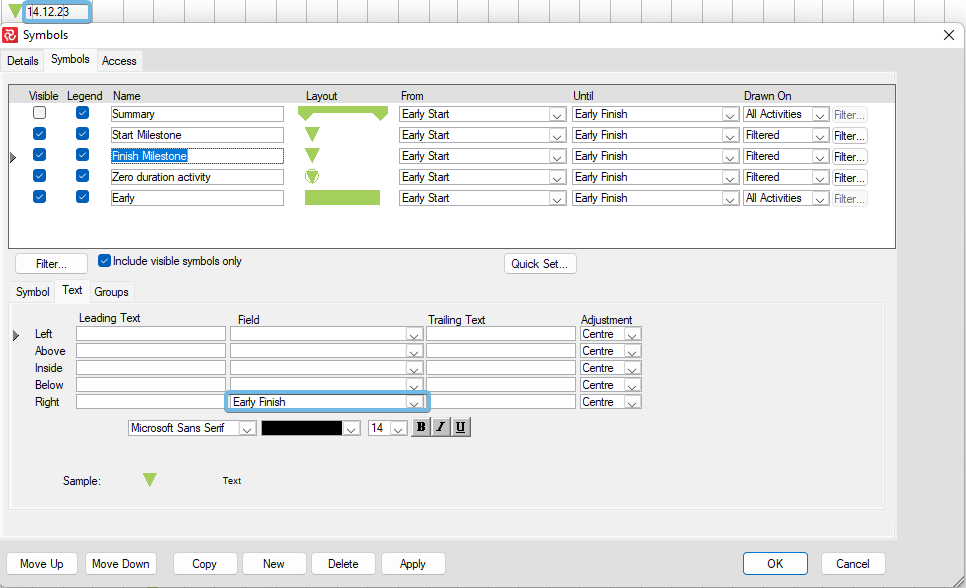
Free text and activity fields may be positioned to the left or right of the bar, above or below the bar, or inside the bar. Relative to these positions, the text can be aligned by selecting options from the Adjustment drop-down list. The Sample lets you preview the bar label position as you make changes. Select the position that suits your requirements from the available options.
Specify Summary Bar Attributes
You can define the look and feel of your summary bars in your Barchart Editor. For the Groups tab to be active, your layout must be organized or grouped in Group Properties. then choose the Group tab. Now, you can mark the visible check box and specify properties.
The Group bar default type is Summary which shows a continuous bar for each group. Since the summarized 'activity' may contain periods when no work occurs, the continuous bar may not accurately represent the total duration.
By selecting the bar type Detailed, you can show planned work more accurately, as this bar indicates inactive time by a broken bar. Group bars may also be defined as a Necked bar including holidays.
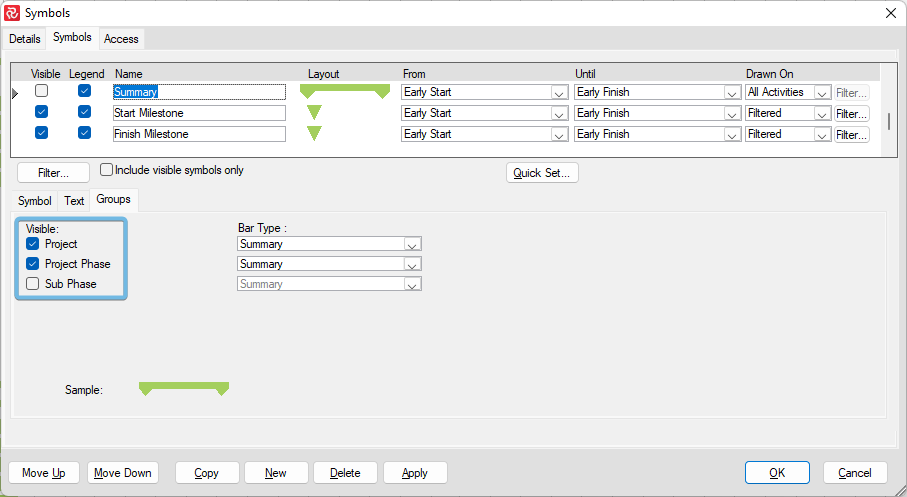
Keep in mind that a Summary symbol should not be checked as Visible on the main Symbols list as this governs a symbols presence at the activity level.
Note: The Group tab may only be accessed when working within the Barchart Editor and if Group Properties are defined.
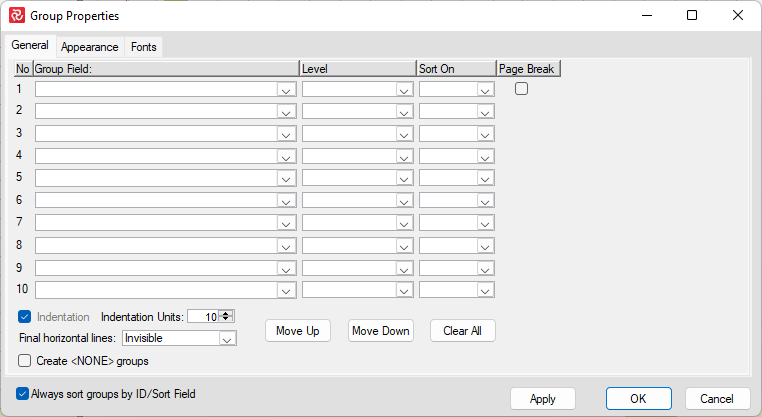
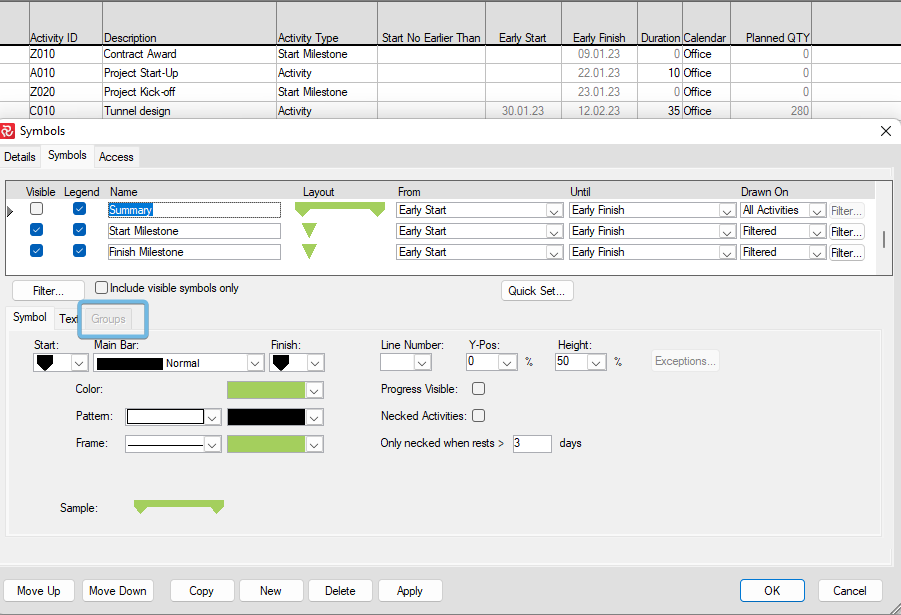
Globals
Globals are variables that are stored as part of your project and can keep various common Text, Date, or Numeric values. Global values can be either static (given a fixed value) or dynamic in that a global can also be a function of a system value such as Timenow or Today.
Once defined and populated they are available throughout Safran Project and are often used when reporting to provide a common start/finish window/timeframe for reports, a Project text in addition to the standard texts available, or to store numeric data.
Date Globals are particularly useful when establishing a rolling 'lookahead' window for a Barchart to select both the relevant activities and controlling the timeframe of the bar area.
Defining Globals
Global definitions are stored within a Global set, and you need to choose a Global set for your project in order to use this feature. You can define as many Global sets as required, and each Global Set can contain any number of as many Globals as needed for your project.
To define a new Global, select Globals on the DATA ribbon:
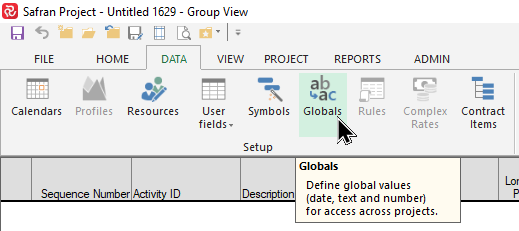
Next, set focus on the global type you would like to define and press New in the Globals window to define a new Global. The Text global can either be set to any text or selected from any project system attribute. There is also an option to set the text global as part of a text string by specifying the start position and length of the text string.
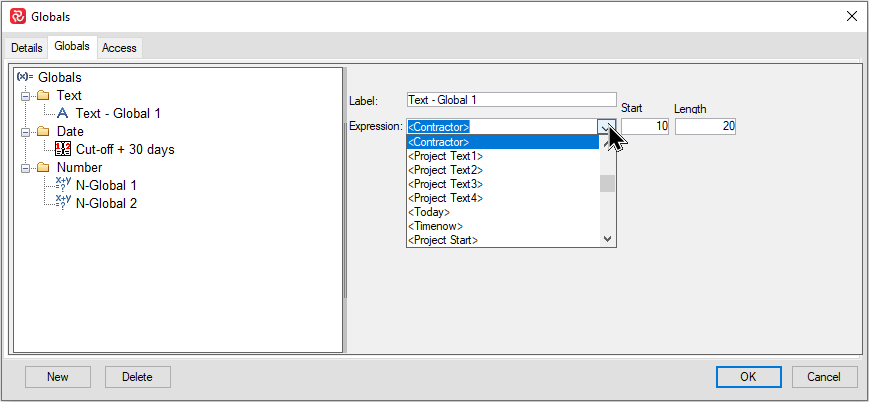
Date Globals can be set equal to a specific date, or you can set the date global relative to a a number of system dates such as Today, Timenow, Cut-Off, etc.
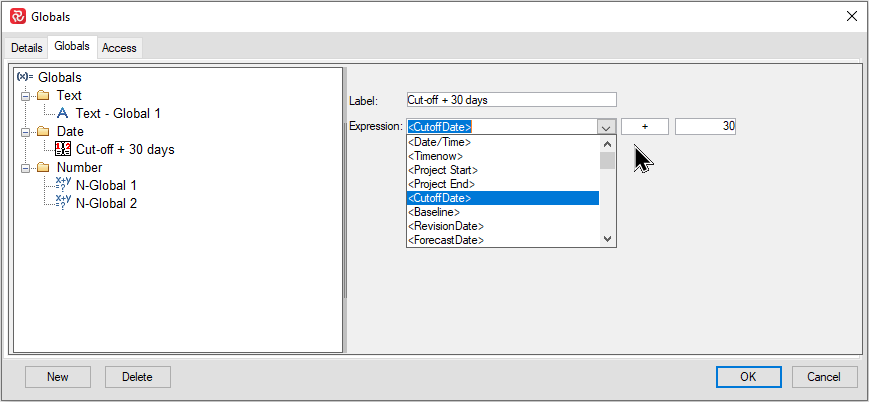
A Number global can be set to a specific decimal or integer.
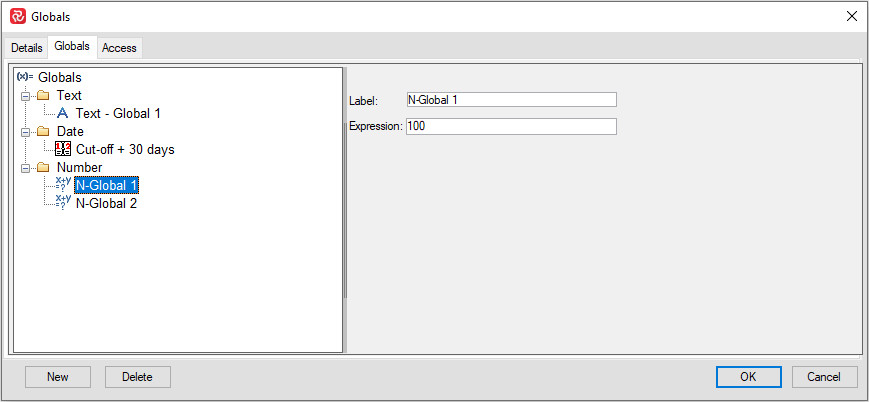
Using Globals
Once you have defined a global and its expression, you can use it as an ordinary field in your select statements in order to filter and focus attention on specific areas within your plan.
If you define a date global as cut-off + 30 days, you can apply this to your filter by selecting activities with either an early start or a finish within the next four weeks.
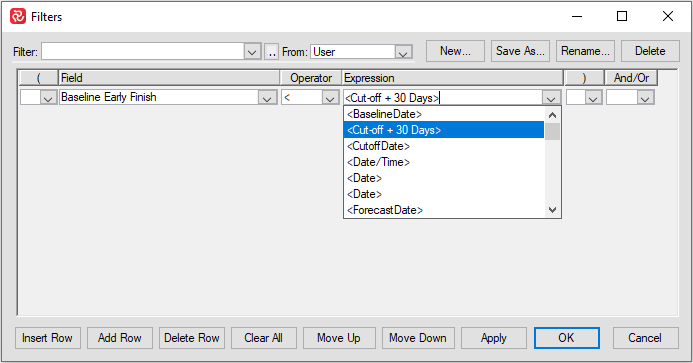
Date Globals are often also used to define the calendar start and finish for the Barchart Editor and grid lines in the graphical area of the Barchart Editor. If your global text contains EPCI, you could use this to select activities with a description, including the Global.
Rules
Using the Rules feature of Safran Project allows you to define automatic field assignments. A rule set consists of predefined assignments that may be helpful and save keyboard time when entering new data into your project. A rule set, including all defined rules, must be assigned to your project.
In many projects the Activty ID is structured and contains information or coded references to a number of code fields.
Consider the activity ID '503111.24E.010' where '503111' identifies a project id, '24' identifies a phase and 'E' identifies a discipline. By setting up a rule for each of the three references, Safran could automatically populate the Project ID/Phase/Discipline fields upon entry of the activity ID.
The rule set allows you to define code logic/assignments between the Activity ID, any F-text field, and any R-reference field code.
Defining Rules
Choose Rules from the DATA ribbon to edit or define new Rules.
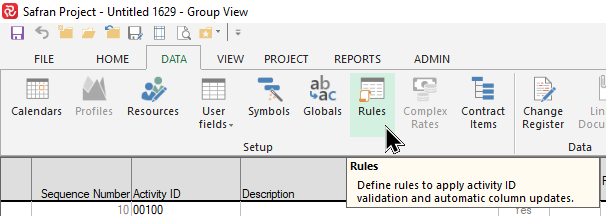
Press the New button at the bottom left to add a new rule.
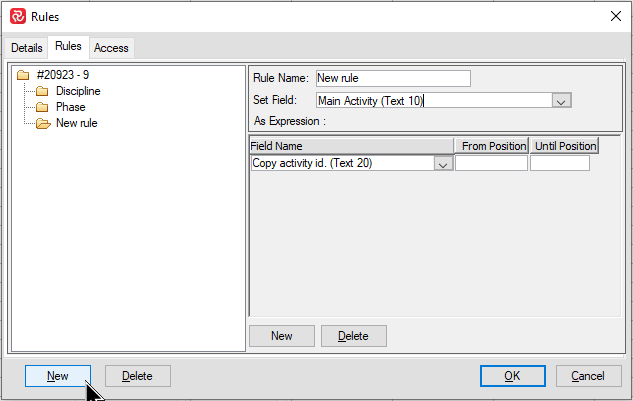
All the individual rules you establish should be given a descriptive Rule Name.
Specifying Rule Calculations
First, select the field to be updated from the 'Set Field' drop-down list box. Available fields are Activity ID, any F-text field, and any R-reference field.
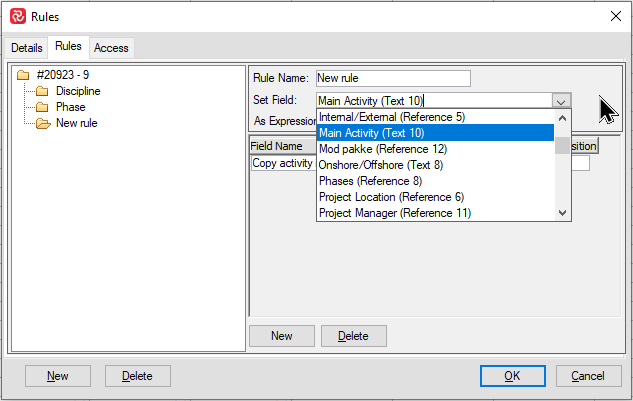
Then specify the calculation by pressing the New button at the bottom left of the 'As Expression' area and then select the field you want to copy information from.
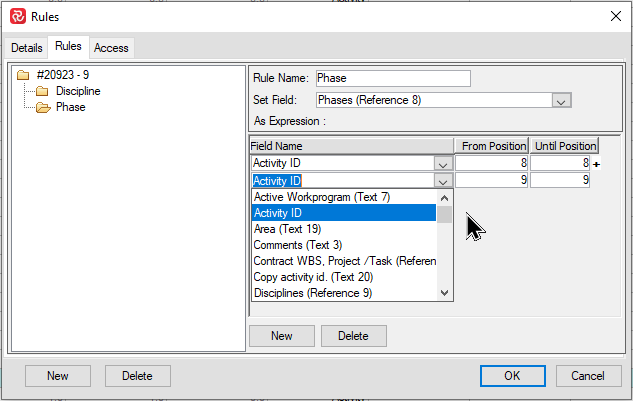
You can add as many lines/fields as you need.
Extracting Characters
To extract a string from any available field and place the result in another field, the rule should be formatted Set Field=fieldname/N1-N2. N1 and N2 are integer values indicating the position of the first and last characters of the string to be extracted.
Concatenating
You can concatenate a selection of fields, extracted characters, or combinations up to the maximum Set Field length. Use the format Set Field= f’dname1+f’dname2+f’dname3.
Rates
Safran uses Rate sets to store multipliers and escalated rates to generate derived costs. Since rates may change over time, rate sets define the applicable rate at any time and date. The rates specified in a rate set can be shared across resources. The rates defined represent the Direct labor cost, Overheads, General and Administrative, and Cost of money multipliers whose values may vary over time. Once defined, the rates are assigned to resources. Safran Project provides seven accounts:
- Direct Rates
- 4 Overhead Rates (OH1-4)
- General and Administrative (G&A)
- Cost of Money (COM)
Rate Calculations
The standard calculations for each value type are:
- Direct Cost = Hrs * Direct Rate
- Overhead Costs = Direct Cost * Overhead Rate
- G&A Cost= (Direct Cost + Overhead Cost) * G&A Rate
- COM (Cost of Money)= (Direct Cost + Overhead Cost + G&A Cost) * COM Rate
Defining Complex Rates
Using Complex rates with Safran Project is a three-step process:
- Select Complex Rates on the DATA ribbon.
- Click New Rate to define and create your rate records.
- Go to Resource Definitions to assign the rate records to each resource for budgets and actuals.
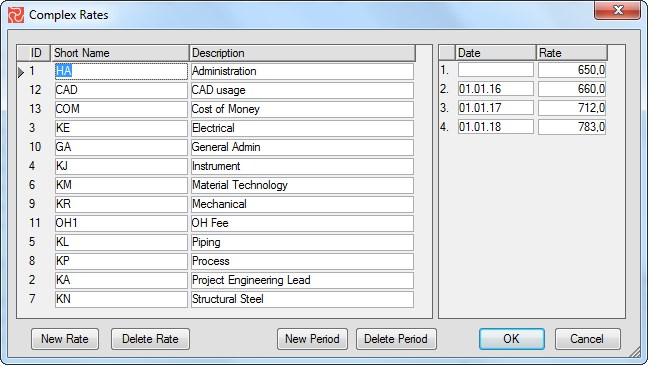
You need to enter a start date with its associated rate to specify rates. A new rate will be valid from start the date entered. You cannot enter a date in the first-rate record, as this is from the earliest start of your project and is not restricted to a specific date.
You are not restricted to specify rate changes at any particular interval, such as monthly, quarterly, or yearly. In addition, a rate record may have only one rate. Typically, the indirect—Overhead 1-4, G&A, COM—contain a single rate that does not change over time.
The rate record is simply a rate associated with a period in time. You can set up different rate records for budgets and actuals or use the same for both. A rate record may be shared across multiple resources, such as department or labor overhead. You need to enter the rate as a number so that 45 is $45 per hour, and a 15% overhead rate is entered as 0.15.
Cost reporting with Complex Rates
When you choose to report on Cost, the Safran Project charts and reports, where relevant, allow you to choose which costs to include when reporting. For government reporting—CPR and X12 export—Safran enables you to specify where to put costs. Options are:
- Include in the body of the report.
- Include at the bottom.
- Include it in the body of the report and display it at the bottom as non-add.
Using the Histogram/S-Curve, you can compare direct, indirect, and total costs by selecting and deselecting cost accounts.

You should check the features of the various reports to familiarize yourself with the cost reporting capabilities.
Change Control
One of the most critical aspects of project control is the ability to track and trace changes to the baseline plan and the baseline scope of work over the life cycle of a project. The Change Control facilities provided by Safran Project allow you to track the numerous and various changes that generally occur as work progresses in a controlled and effective manner. Changes may reflect both internal and external variations. Examples of Changes:
| External | Internal |
|---|---|
| Administration | Technical |
| Technical | Schedule |
| Schedule | Financial |
| Scope of Work | |
| Financial |
Change in a project can seldom be prevented; however, its negative effect on project control may be effectively controlled, tracked, and documented for future reference. Safran Project allows you to set the baseline scope of work at project initiation and establish a master control estimate—the original baseline scope.
This facility allows you to ensure that all future changes, variations, and modifications involving resources, quantities, and costs can only be added to Safran Project as Variation Orders. If new scope is added to an existing activity, you can track and trace both the original budget as well as the work related to the change.
Safran Project allows changes to be categorized in the four different groups listed below:
| Type | Description |
|---|---|
| Variation Order | A Variation Order accepted and approved by the project client. |
| Variation Order Request | A request for a Variation Order has been issued to the project client. If a VOR is accepted, its status may be changed to VO. |
| Internal Change | Internal changes to the scope of one or more activities. |
| Subcontracted Work | Creates a record (activity) for tracking/controlling subcontracted work. |
With Safran Project, you may specify how changes are to be summarized and when they are included in the various scopes. By doing this, you also control how they will be considered for reporting and measurement purposes.
See also the chapter on Scope and how the various change types can be set up to form the basis for your standard project reporting.
The Change Register
The Change register holds a complete record of all project changes/variations.
The Change register consists of two elements. One is the Change Order containing information about the change, such as VO number, Client number, responsible, and acceptance date. The other is a list of the detailed changes, such as the addition or reduction of scope and corresponding cost that the Change Order covers.
A Change Order may cover multiple resource quantities and additionally span numerous activities. At the same time, an activity may contain multiple Change Orders.
Working with Variation Orders
To access the Change Register, press the Change Register icon on the DATA ribbon.

The Change Register window will now open with a list of existing changes grouped by VO-type:
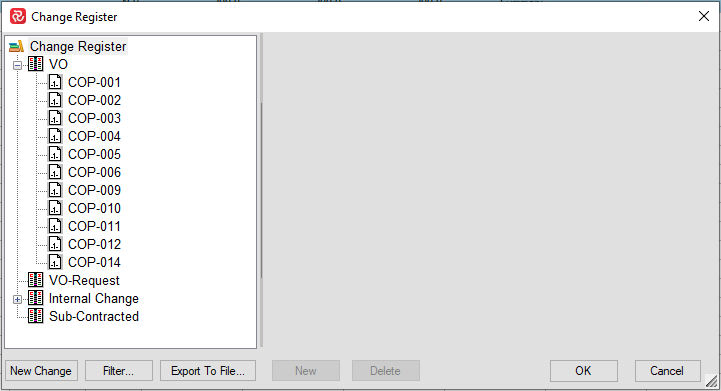
To add a new Change, right-click or press the 'New Change' button:
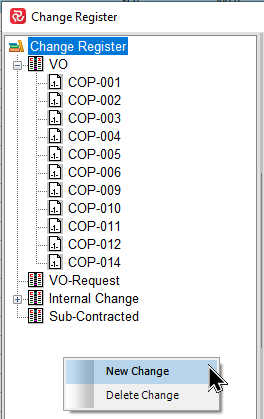
The Change Register window opens allowing you to enter either basic or complete VO information including activity/resource details:
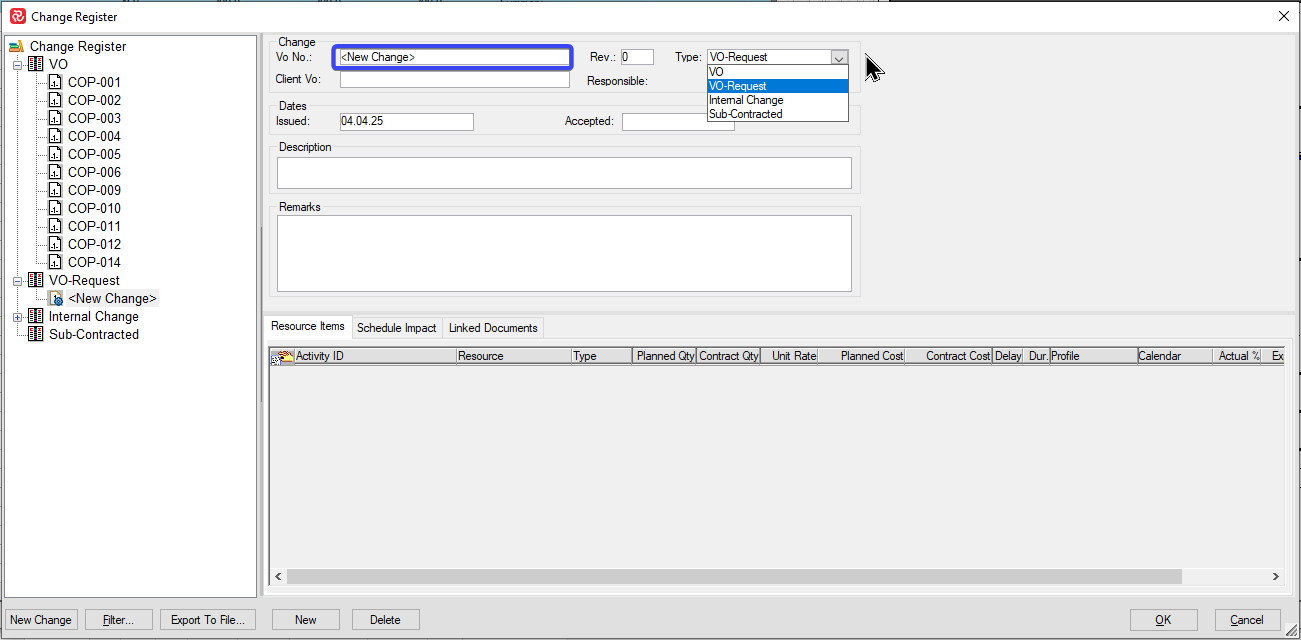
In its simplest form, the the only information required to establish a new VO is its Vo No. and Type, which may be selected from the four available statuses in the dropdown list. All other details may be added/reviewed later.
The most common way of working with VO's is, in fact, to first establish the basic/top level VO information in the Change register and then referring to it when adding/reviewing activity/resources.
Press OK to save your new VO.
After you have done this, the VO Number will be available/may be selected in the Resource Panel windowwhen adding new VO resource details for an activity:

In addition to holding positive values reflecting scope increase, Variation Orders may also hold negative values to support reduction in scope.
Reviewing Existing VO's
The Change Register window consists of three sub-panels where the left panel allows you to browse existing VO's which you'll find grouped by VO-type. When focus is set on a VO the upper right panel displays the general VO data, while the lower right panel lists the specific activity/resource details.
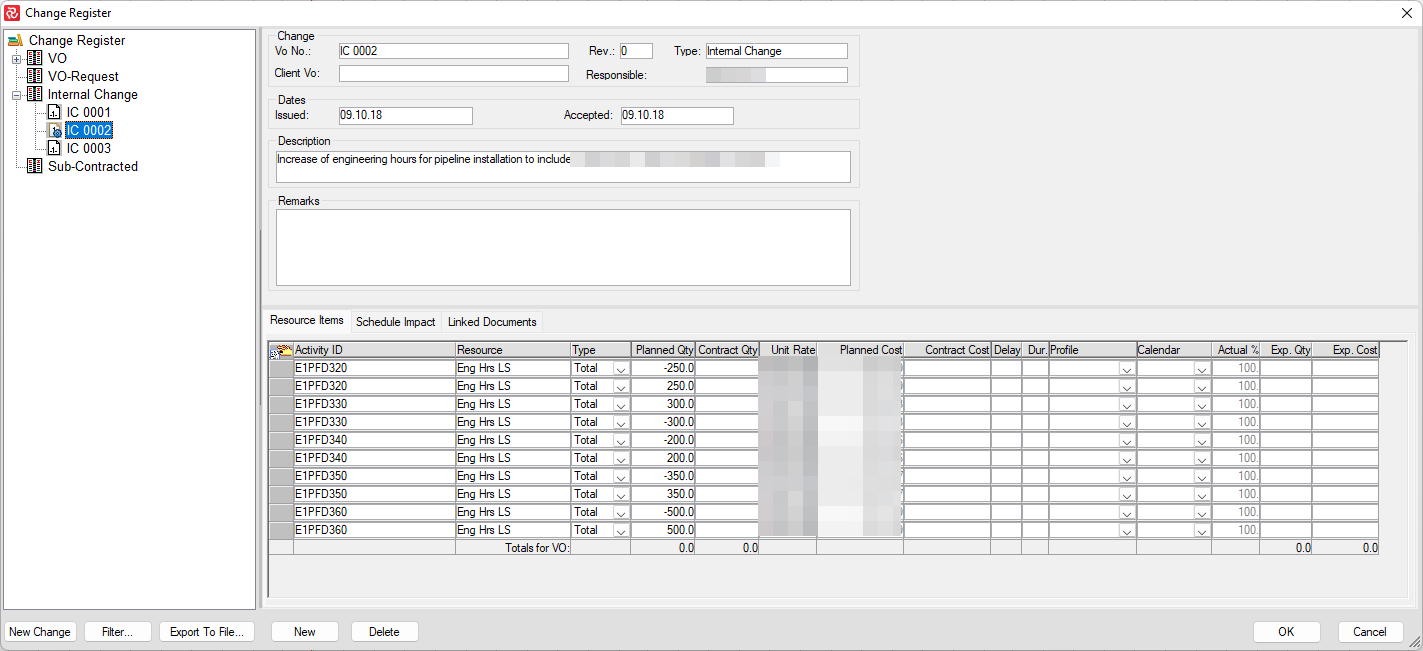
This window allows you to add, delete or review both Variation Order basics and detailed activities/resources. Use the New/Delete buttons to add/delete VO details.
If your list of Variation Orders is extensive, you can use the Filter button to limit the list or search for one or more specific VO's:

The filter panel allows you to filter on a wide range of properties related to the VO basic data such as VO. Number, Revision, VO-type/Status as well as descriptive data.
The details for a variation order include activities and resources with their estimates, a schedule impact registration, and the ability to link a document or URL address to a variation. You can select the required options from the Edit or right-click short-cut menu.
The upper half of the Changer Order entry/review screen contains the following fields:
| Field | Description |
|---|---|
| VO No. | Unique identification number for the Variation Order. |
| Rev. | Revision Code, default value = 0. You may overwrite this value. Info only. |
| Type | Choose status from the drop-down list. Controls which scope VO will be included in. If you highlight the VO type in the tree view and select new change, the type will be automatically entered. |
| Client VO | The project client Variation Order Number for the approved variation, Info only. |
| Responsible | Initials may be used to identify the person responsible for the VO. Defaults to user log-on ID. Info only. |
| Issue date | Date of issue for VO. By default, the date the change was initially entered in the register. It may be overwritten. Info only. |
| Accepted | Date of Client acceptance, Info only. |
| Description | Description of the variation order. |
| Remarks | Comments regarding the variation order. |
On the lower half of the Changer Register entry/review screen, you'll find a tab-separated panel that allows you to add change item information. The three tabs are:
- Resource Items: used to add/review activity and resource detail information:
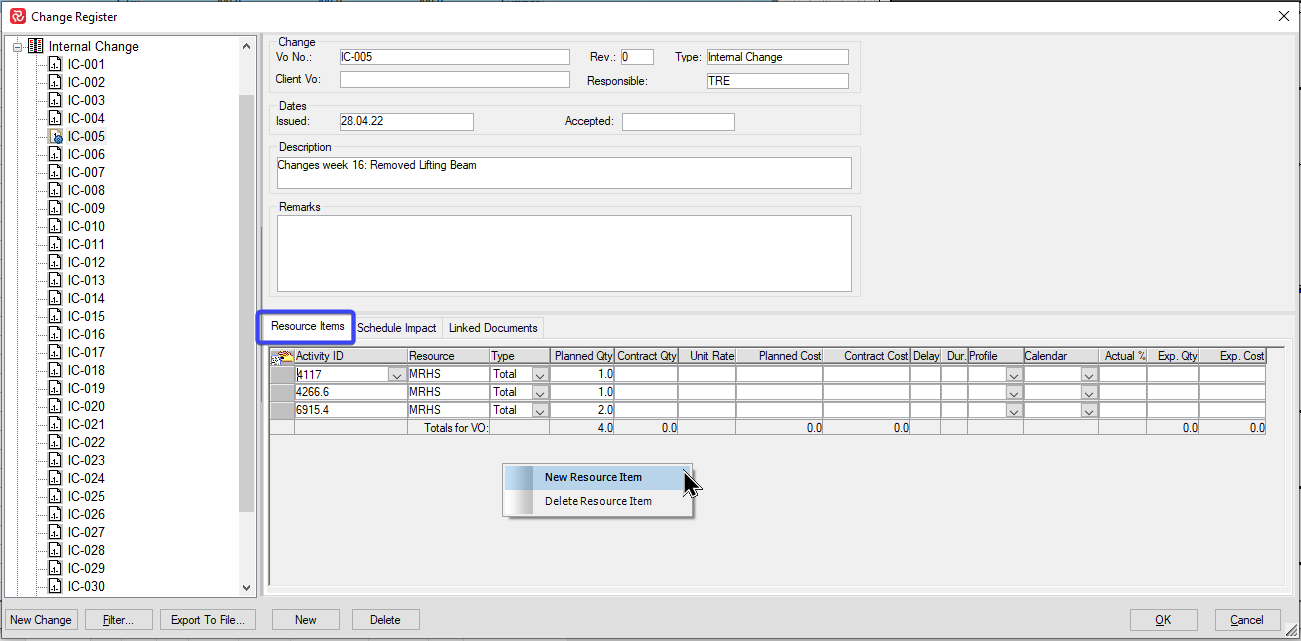
- Schedule Impact: allows you to indicate both estimated and approved schedule impact (info only) caused by this variation order having an impact on other activities:
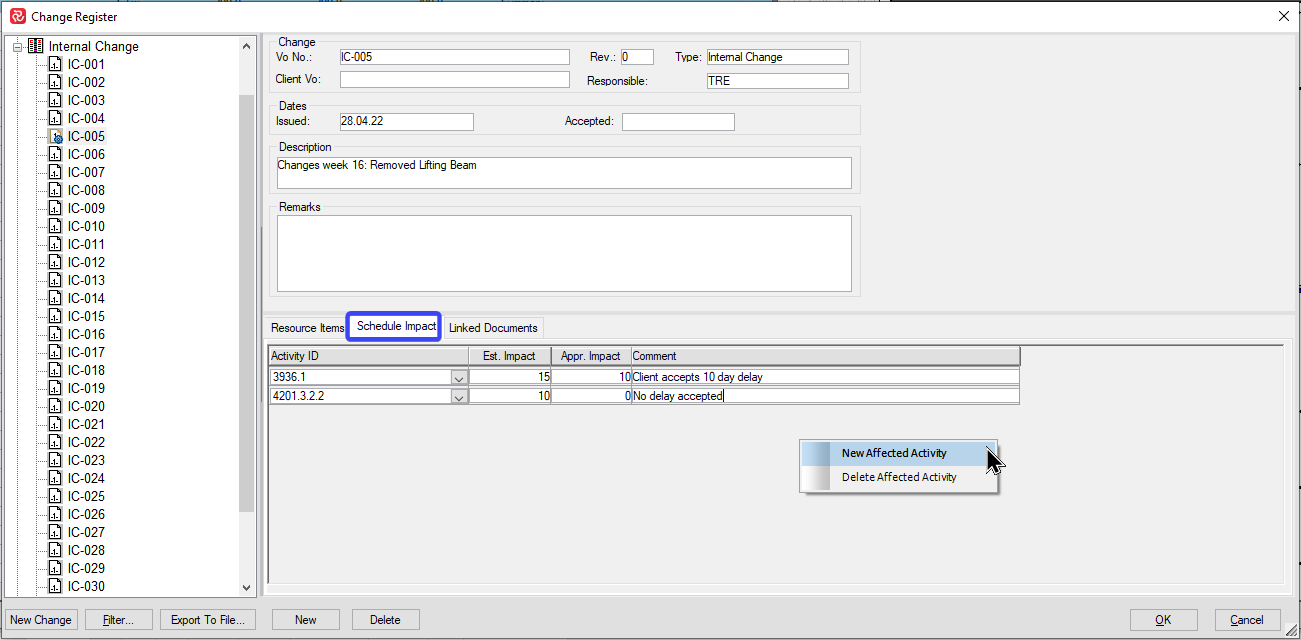
- Linked Documents: allows you to add document paths to detailed change documents or a valid URL to a change system and also open these from within the Change Register window to view document details:
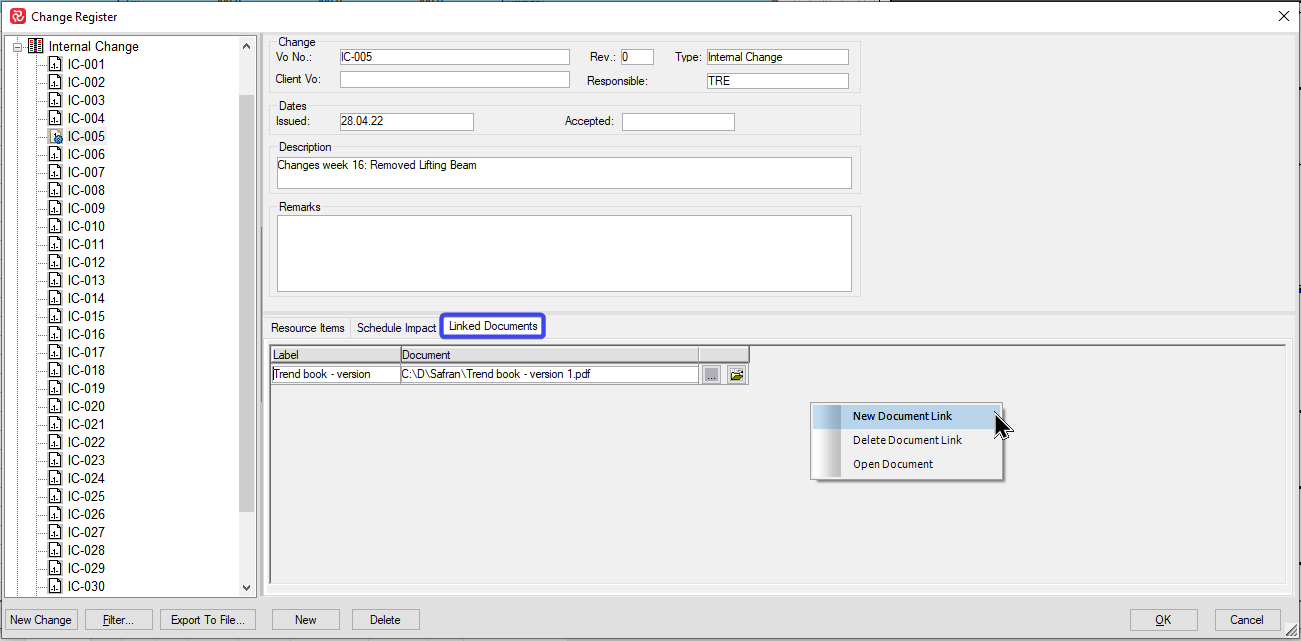
Moving resource items between Changes
Note the 'drag and drop selector' on the upper-left hand side of the Resource items list in the picture below. If you point and click here you can remove one or more of the Resource Items from you 'current' VO and move them to another VO in the list of changes.
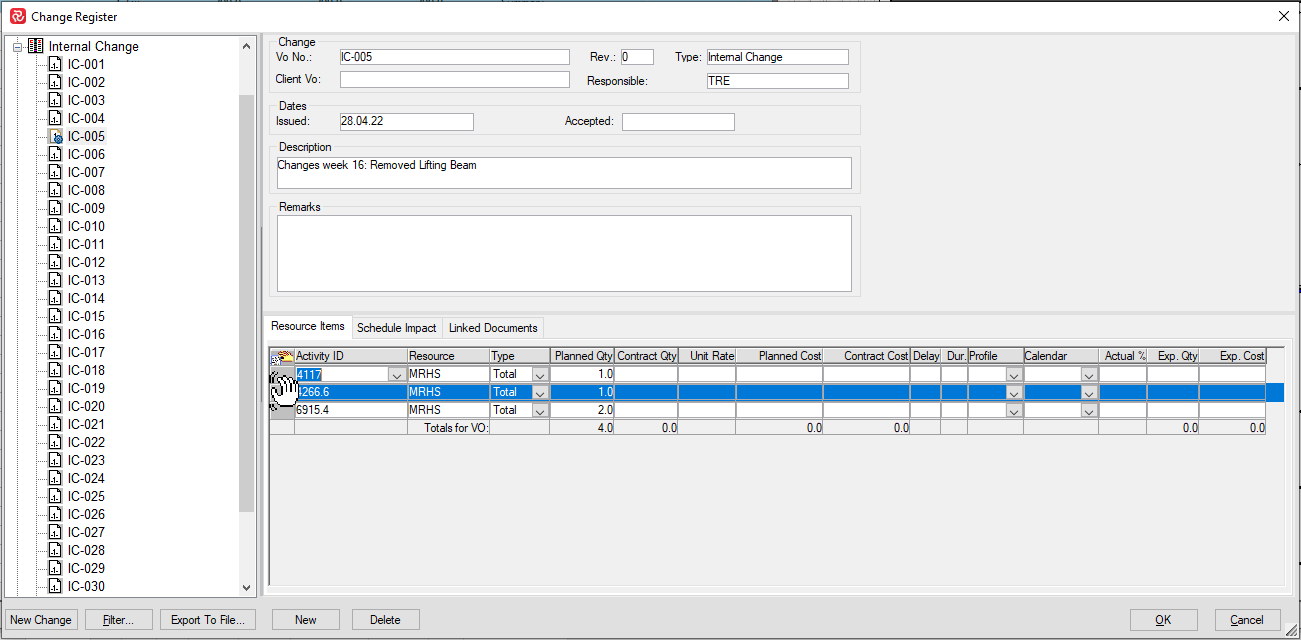
Resource items may be selected by clicking the grey area to the left of the activity id column.
To select all resource items, select the uppermost item first then hold the shift button down and select the final item to highlight all. Specific items may be selected by selecting one item, then while holding the CTRL button select each specific additional item you would like to move. Items are considered as selected when the whole line is colored blue.
When you have selected your items you can drag and drop them to the relevant VO in the list on the left.
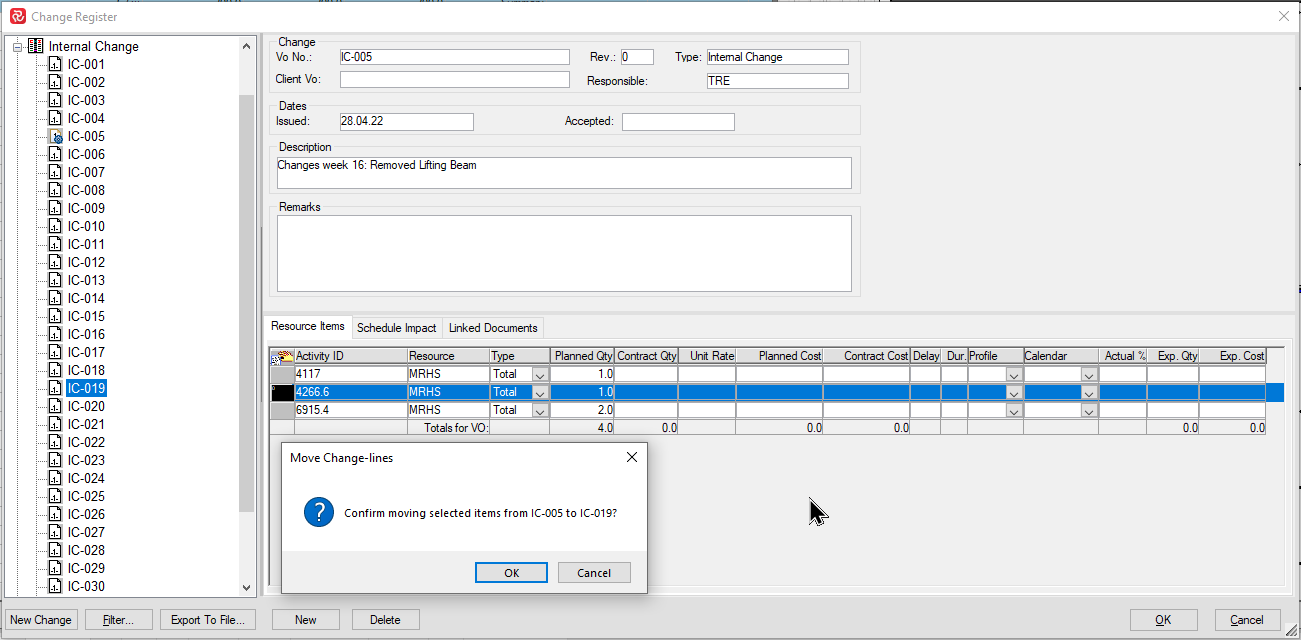
When you move resource items you will be asked to confirm the action. The change will written to the database after you press the OK button on the main Change Register window.
Exporting Change Register Details
You can export the change register details to a text file by pressing the 'Export to File' button. The file will contain both basic as well as highly detailed resource item information including whether or not the resource item has been included in a baseline/status update or if it is considered 'locked'.
The export function will export the entire change register unless a filter is applied.

Change Reports
See the Change Report Chapter for more information on the change reports available.
Contract Items
Your project can be divided into several so called contract items. A Contract Item is a part of a project potentially sharing a standard code value. It may be accessed and worked on as a separate entity. This philosophy supports individual project responsibility, multi-user project development and analysis functionality. When dealing with larger projects consisting of multiple project phases, single discipline activities, etc., dividing the project into smaller parts is often recommended.
In addition to controlling various Contract Items, Safran Project allows you to add logic between Contract Items and supports activities belonging to different Contract Items.
The diagram below is a conceptual illustration of the Contract Items hierarchy:
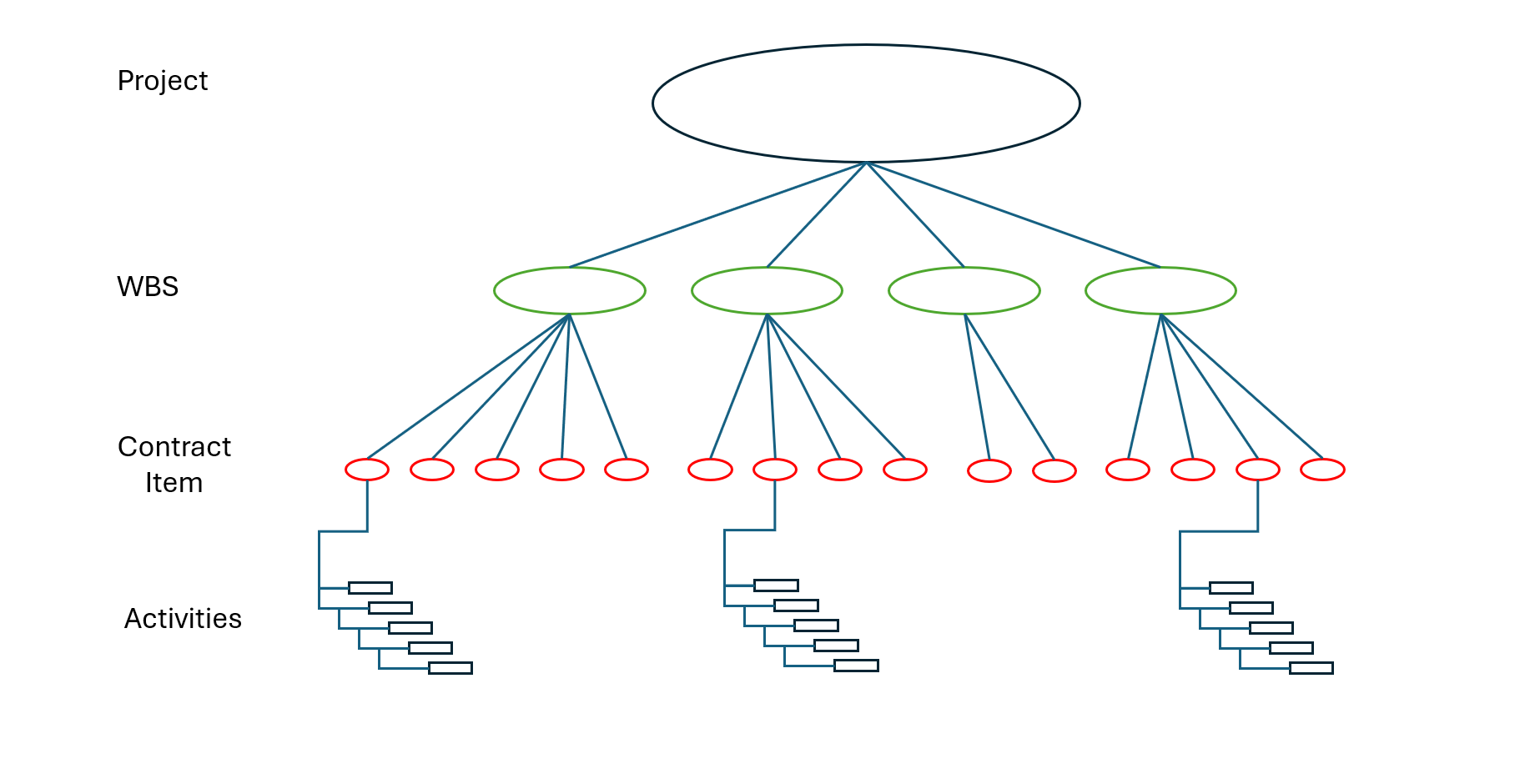
The Contract Item facility is commonly used when working with projects within the Frame Agreement/Modification & Maintenance type environment.
The two functionalities, "Contract Items" and "Subprojects," may be used independently.
You need a license key to unlock/display Contract Items on your Data tab in the menu bar.
Contract Items setup
Once you have obtained your license key, you can set up Contract Items for your project.
Click on File/Data/Contract Items.

This message box appears the first time someone in your project clicks on Contract items. Click Yes.
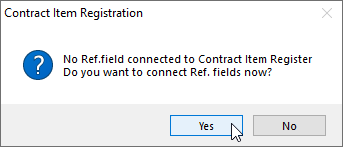
You need to connect Contract Items to two of your reference fields. One will contain a list of valid Contract Items and the other will contain a list of valid WBS codes. The reference fields that you choose may be already populated or empty.
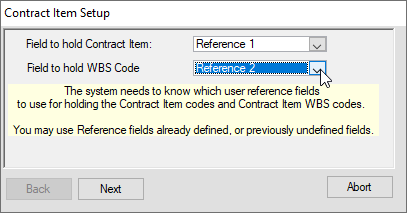
Note: If this is the first time you do this and, in particular, if this is an ongoing project, we highly recommend you take a copy (FILE/SAVE AS) of your project and test this functionality before implementing it on an ongoing project.
Choose what happens to these two reference fields and press Next.
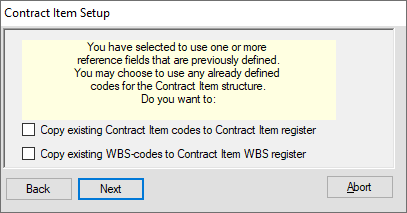
A confirmation message appears:
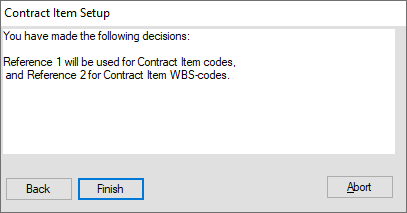
You will now see that the chosen reference fields are connected to Contract Items:
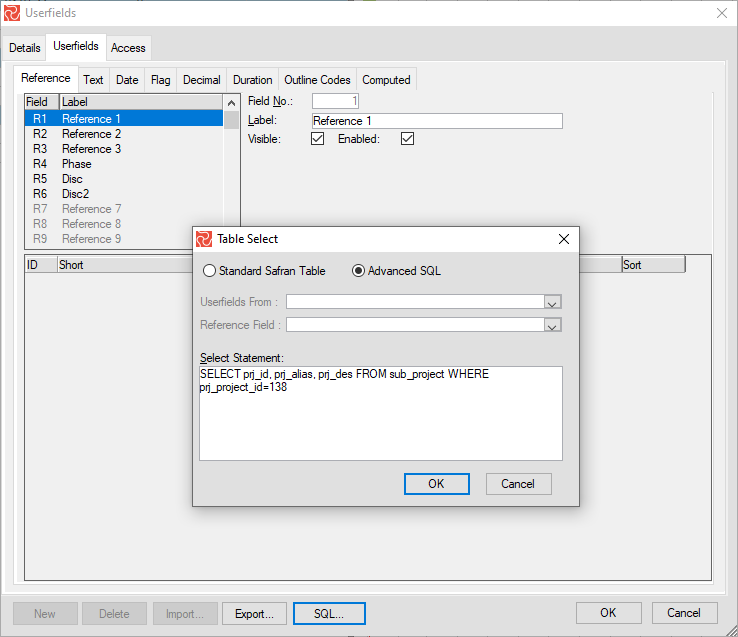
The 'sub_project' term in "Select Statement" must not be confused with Subprojects in Properties. In earlier versions of Safran Project, Contract Items were called Subprojects.
Subprojects and Contract Items go hand in hand but may be used separately.
Once you have added one or more Contract Items, these will appear in the Userfield set. You will see that these are grey and no longer black:
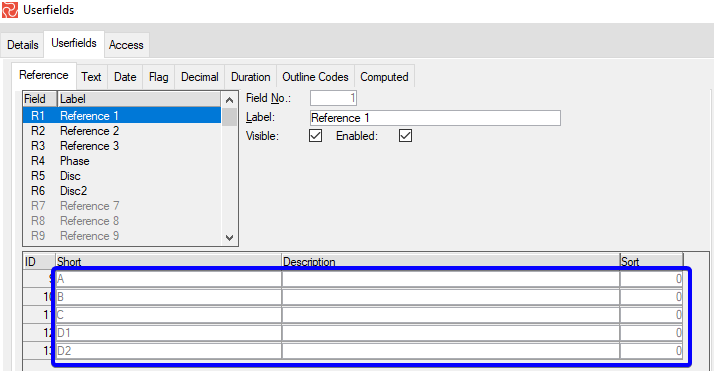
To add or edit them, it must be done through Contract Items.
Once the initial setup is complete, the next time you open Contract Items, it will (depending on your choices above) look like this (if you chose not to copy Contract Item/WBS codes):
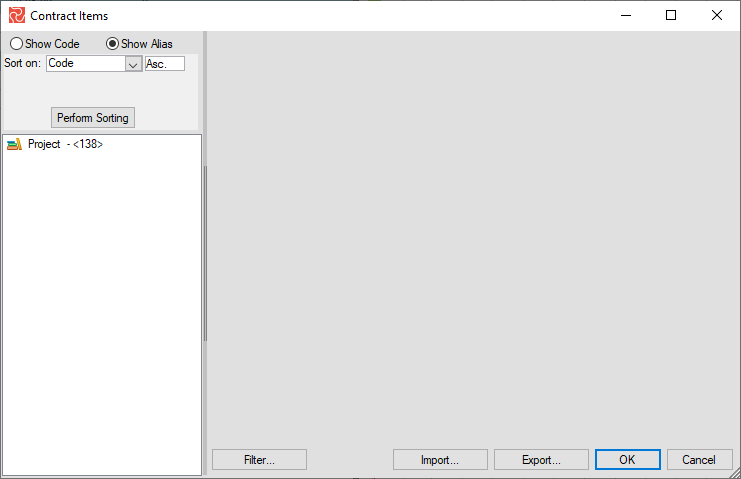
or this (if you chose to copy Contract Item/WBS codes):
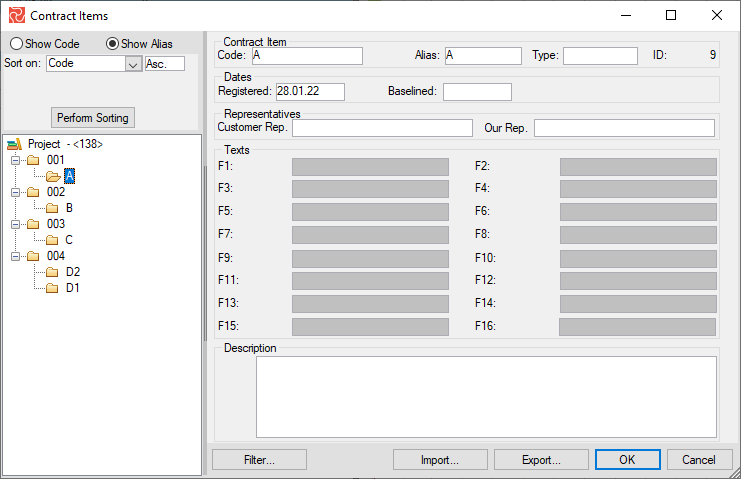
Adding Contract Items
In the Contract Items list, right-click and choose New Contract Item. A Contract Item must belong to a WBS code, so you might have to create that first before adding a Contract Item. The relationship may be 1:1 or 1 to many, as shown below:
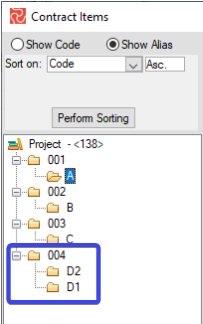
Removing Contract Items
To remove a Contract Item definition, right-click and select Delete WBS and Contract item, as shown in the picture above.
Import or Modify Contract items
In the DATA ribbon, click on the Contract Item icon. In the opened window, you can import new Contract Items and modify and export the existing ones. Before inserting a new contract item, you should select a WBS code.
WBS Node:
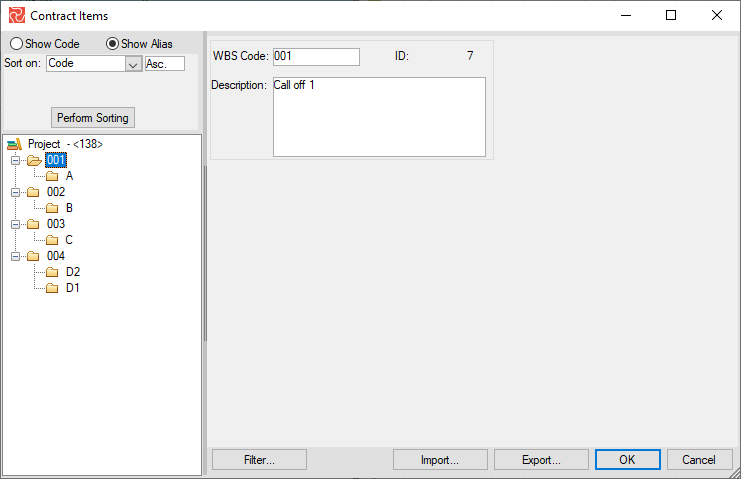
Contract Item Node:
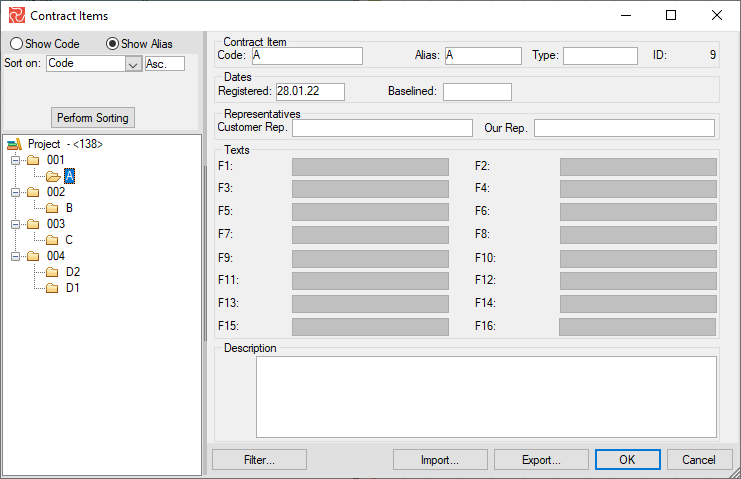
Accessing Projects
To work with a project you have to select the project you wish to edit. Press the ‘Open’ icon on the file tab to view a list of projects you have access to in the database.
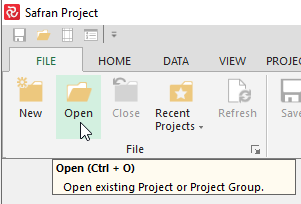
- You can limit the projects list to contain only projects you created by selecting 'User owned only'
- You can use the ‘Show Projects’ box to limit the list to projects 'Beginning with/Containing' a text string in the Project name.
- Clicking a field header performs an automatic sort of projects on this field.
When you have selected your project, press OK to open the Project.
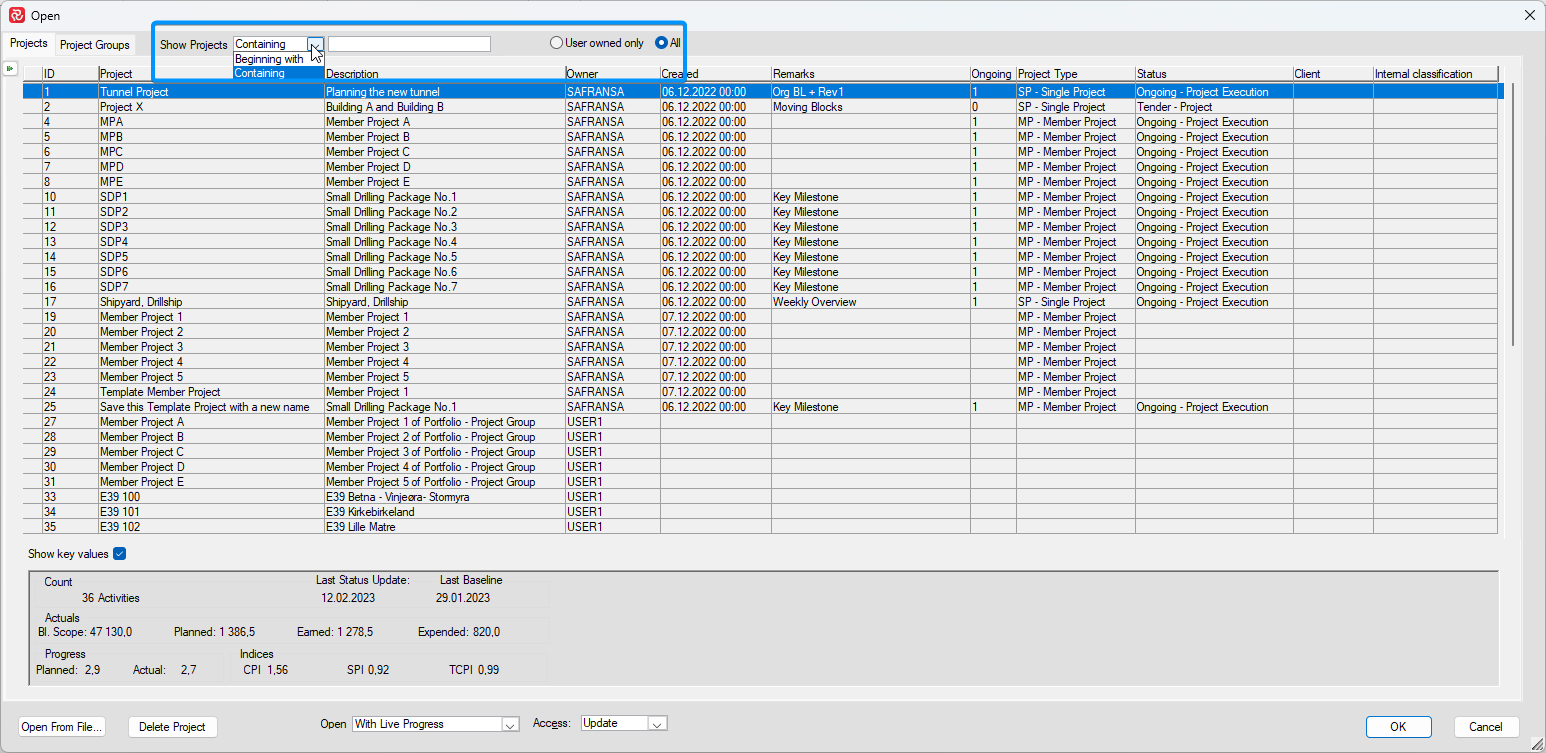
- When you select a project, you can also view/edit the Project Properties or the Userfields Loading Options even before opening the project by pressing your mouse's right-click button:

- Opening the Project Properties this way, will lock the project. In other terms, you are opening it in "Exclusive Mode". This mode is only possible if noone has the Project already Open in Update/Exclusive mode:
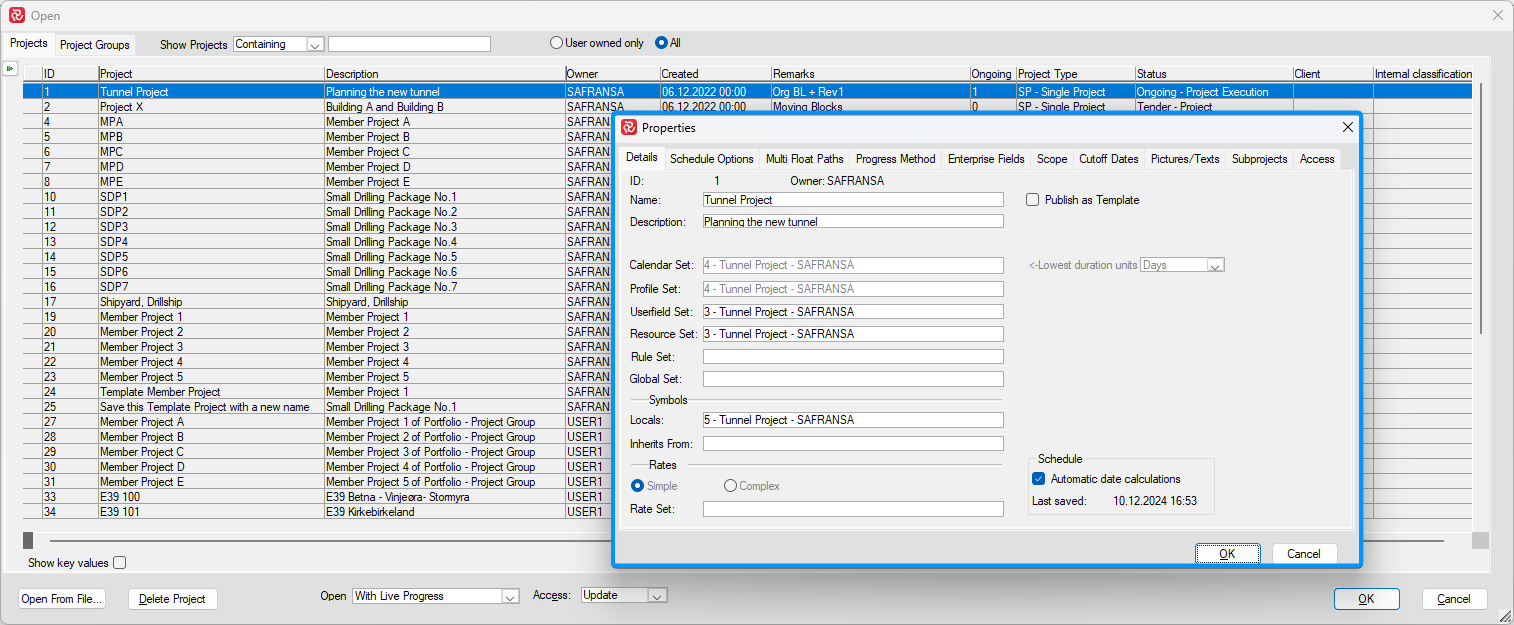
Open From File
You can also open projects outside your database. At the bottom of the window, you can press the ‘Open From File’ button, allowing you to open an external project through a browsing window. The supported project file types are:
- Safran Project (.SP/.SPX)
- Safran Planner (*.SPP)
- Microsoft Project XML (*.XML)
- Primavera Enterprise (*.XER)
Once a project is selected, the project name will be displayed at the top of the Safran Project window. You may delete an existing project by pressing the ‘Delete Project’ button at the bottom of the window.
Project Selector
If you have defined and use Enterprise Codes, the Project Selector might be helpful:
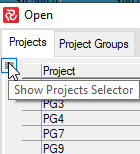
Press the Show Projects Selector to open the the selector. Start by selecting the Enterprise fields you want to organize your projects according to. When you then set focus on a node in the selector, the list of projects will be limited to the projects from that node.

Opening Recent Projects
You may easily find and open the projects you have recently worked with by pressing the ‘Recent Projects’ button in the file tab ribbon.
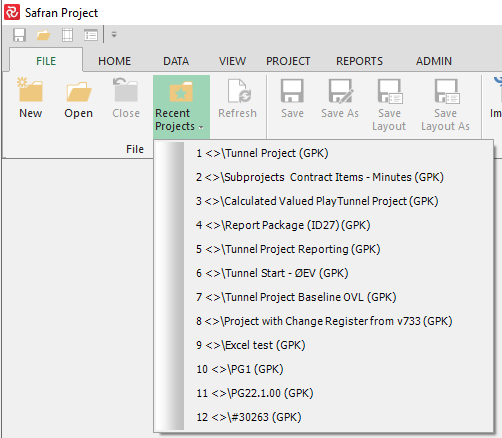
Startup Options
Safran Project allows you to customize what Safran does when you start a new session, either open a specific or your last opened project etc. Press the arrow icon in the lower right corner of the file tab as shown below to open the Startup Options configurator:
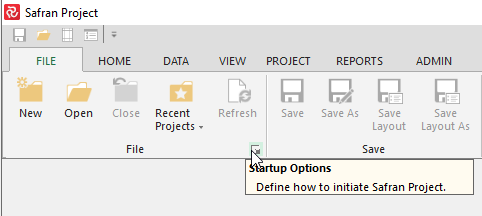
In the ‘Startup Options’ dialog box, you may select among the following alternatives:
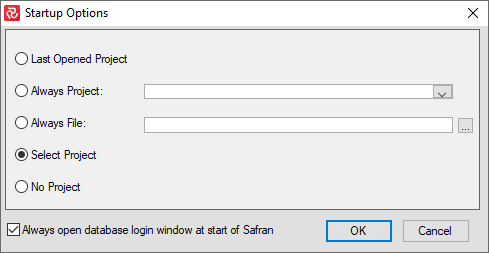
You can also choose whether or not to open the the database login window.